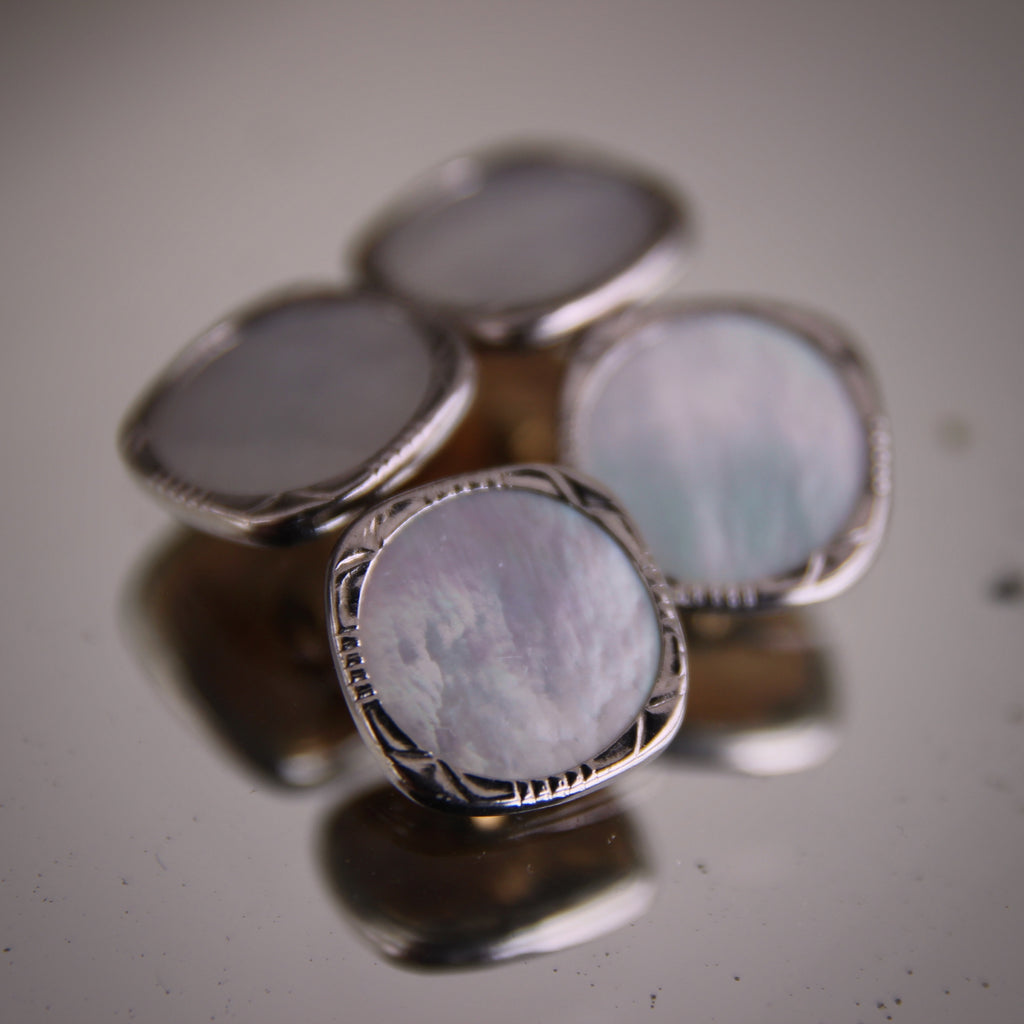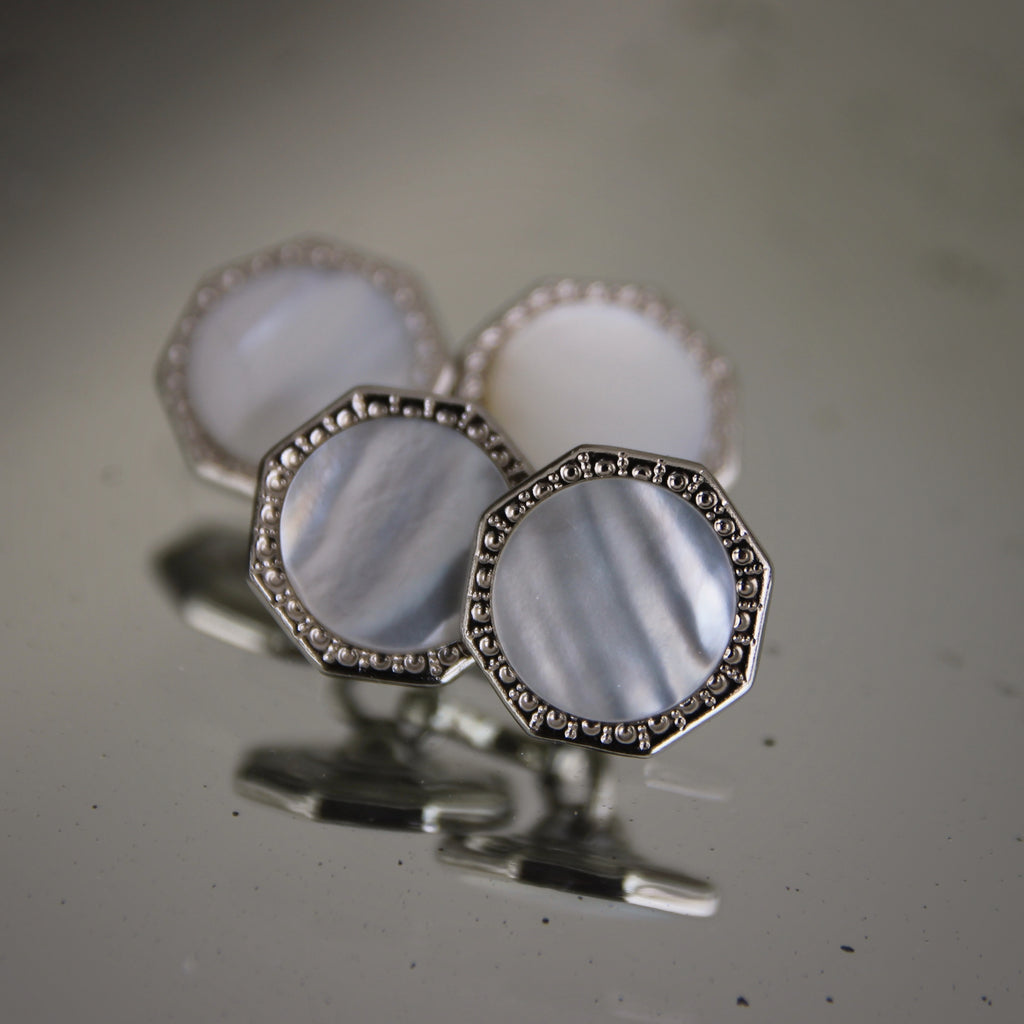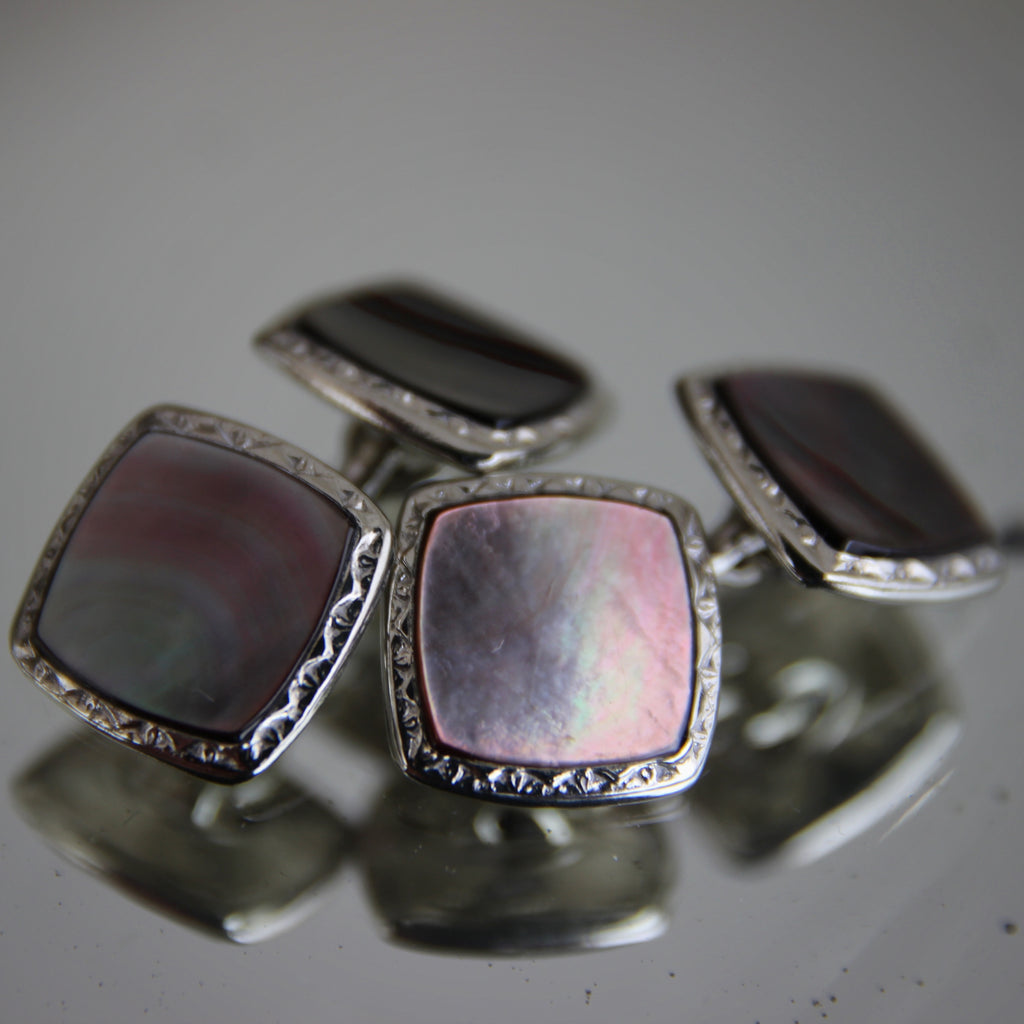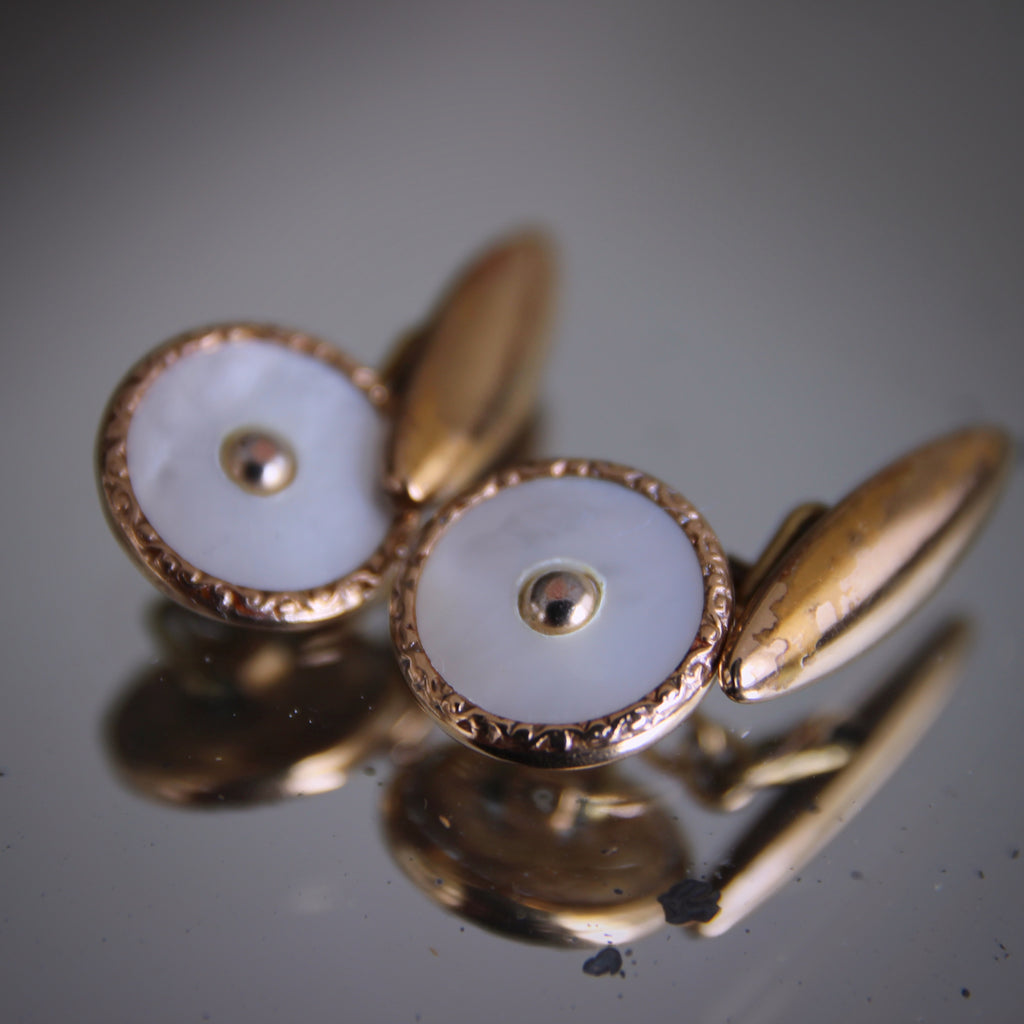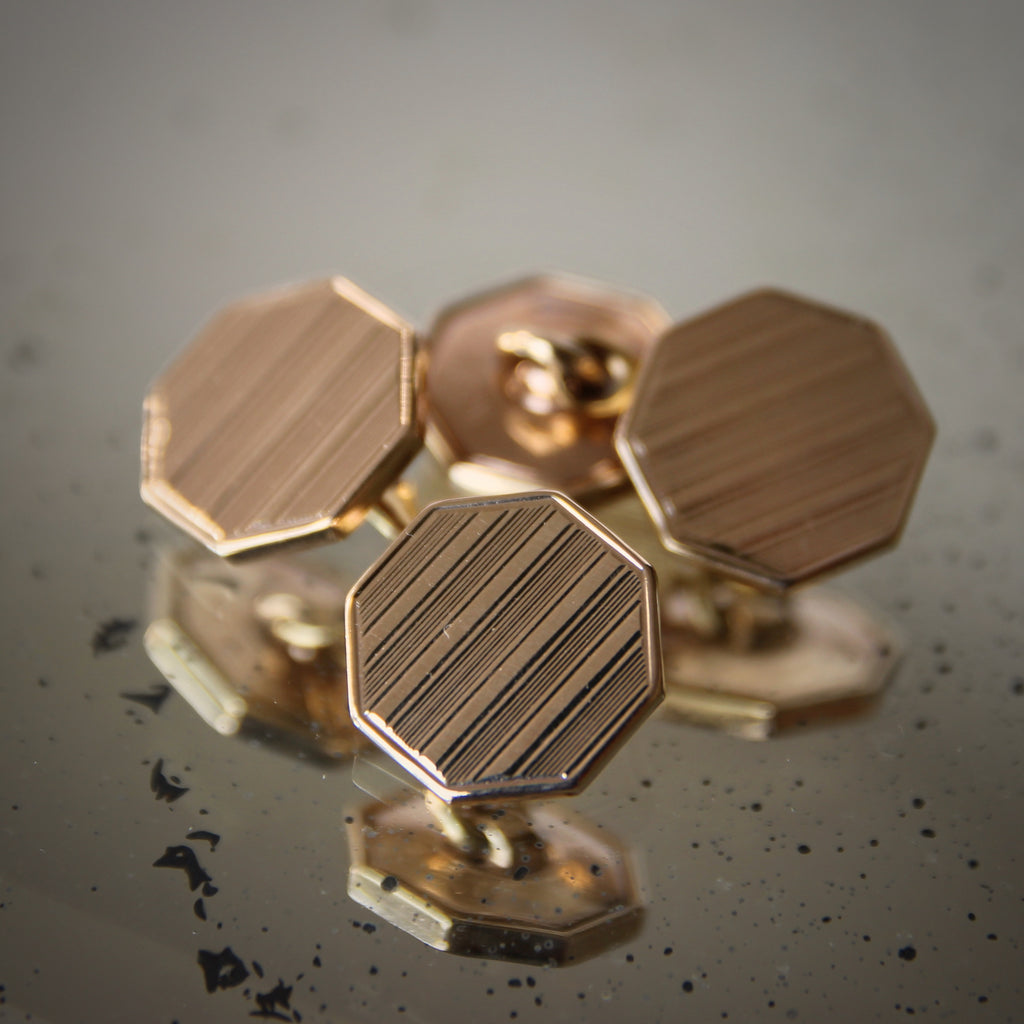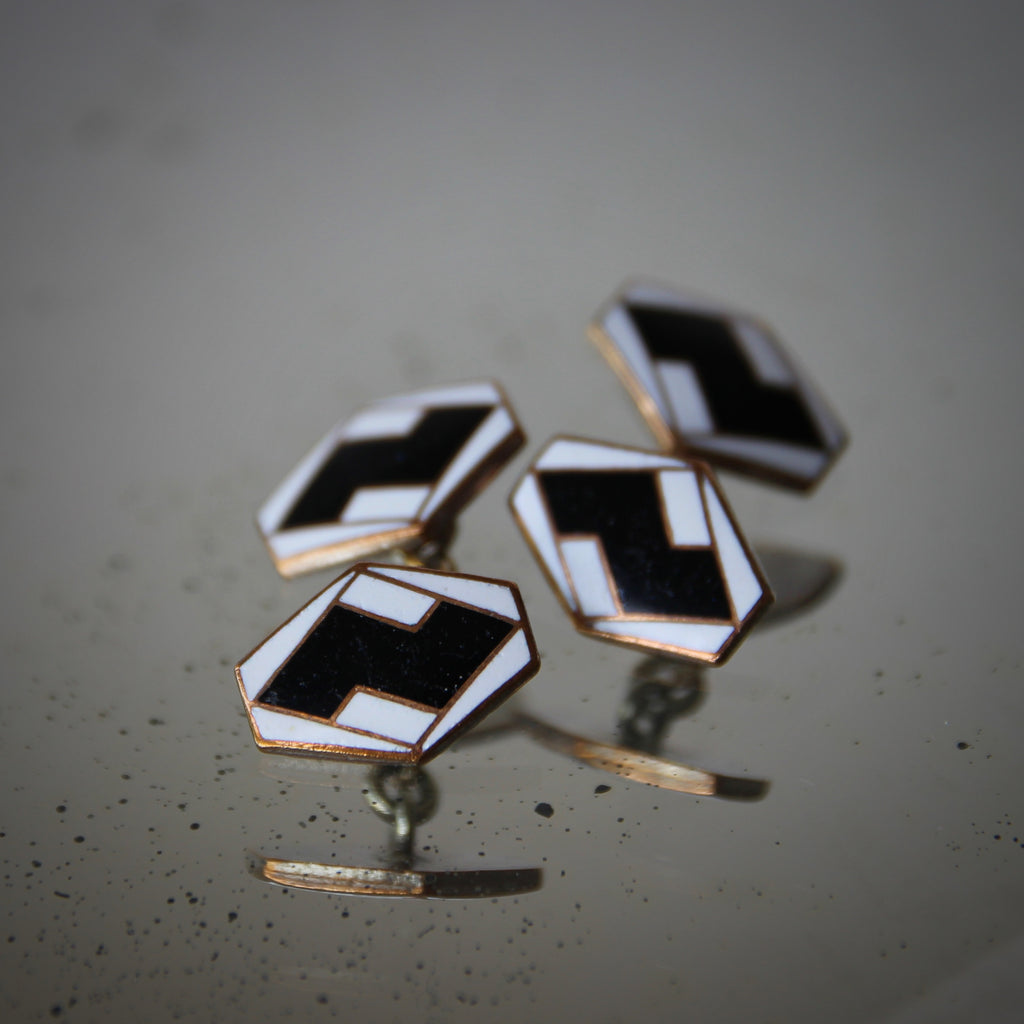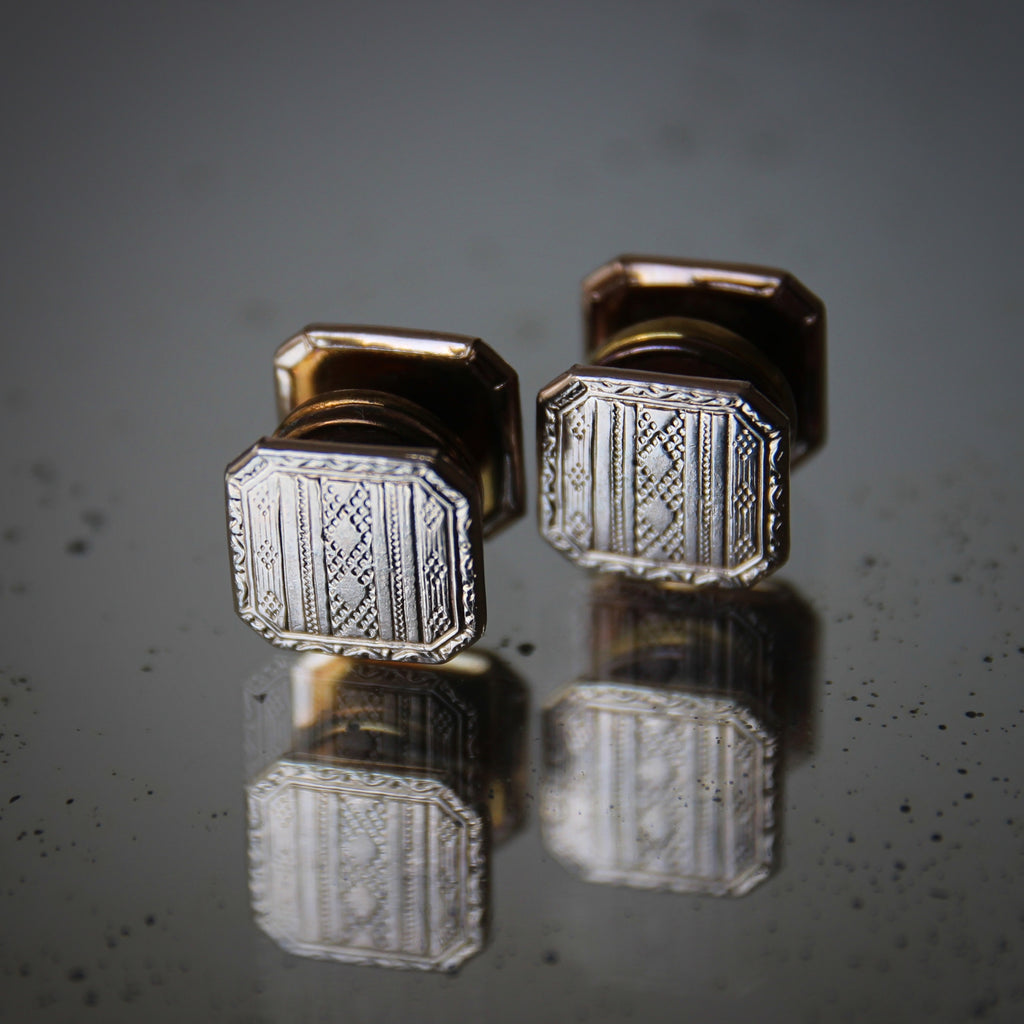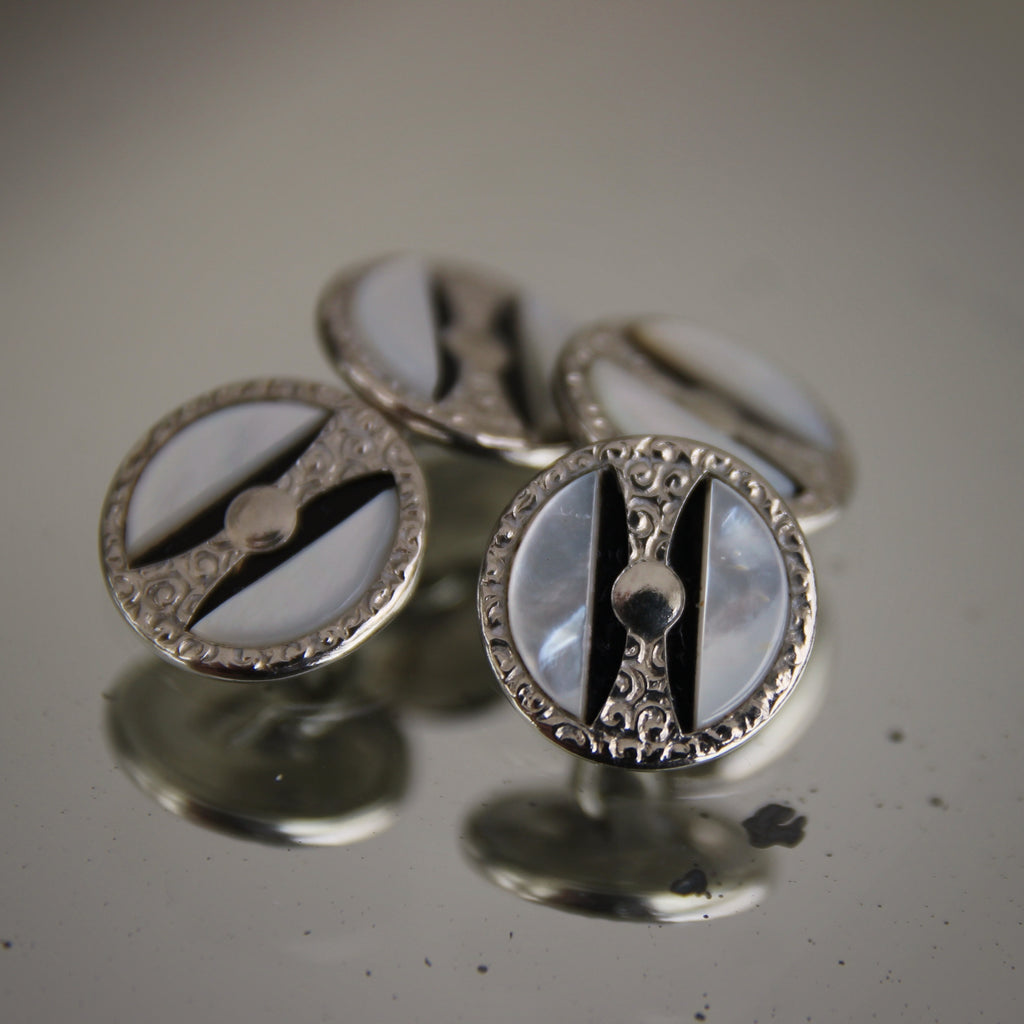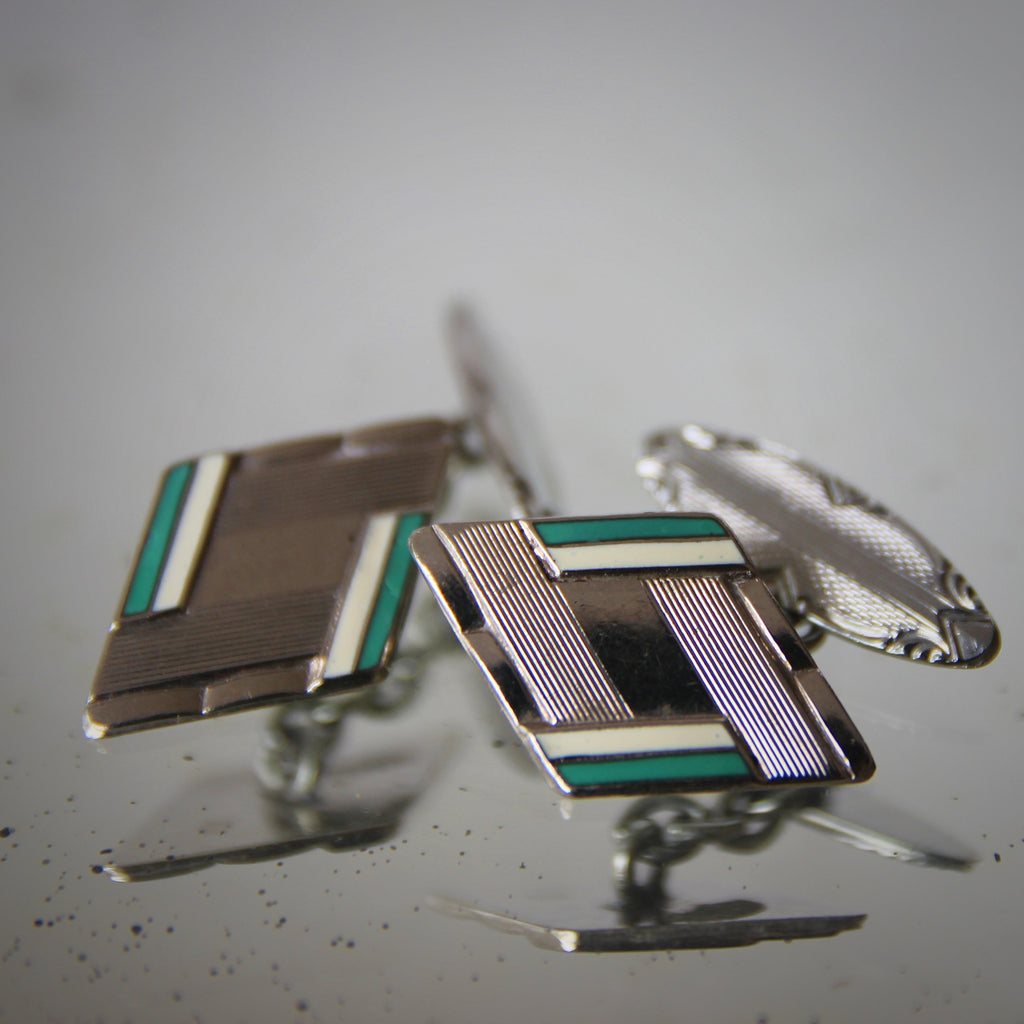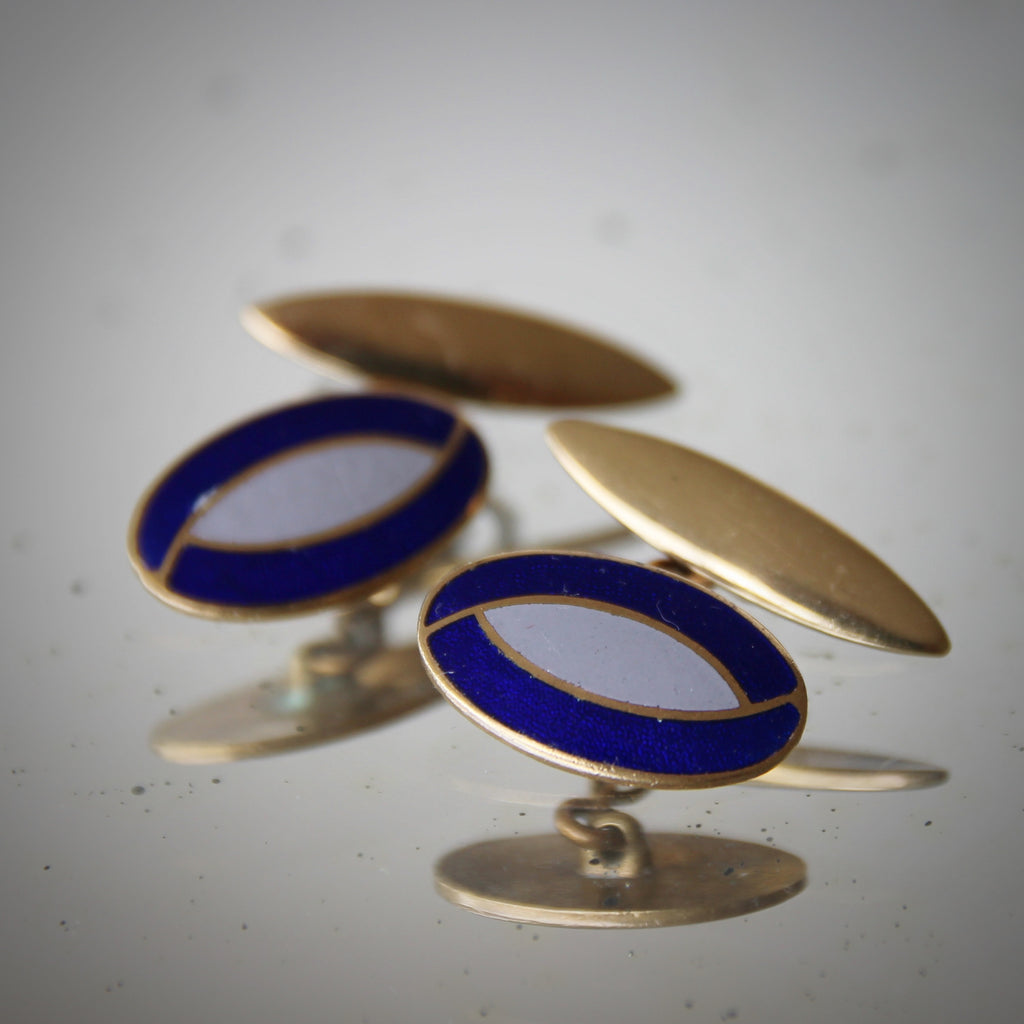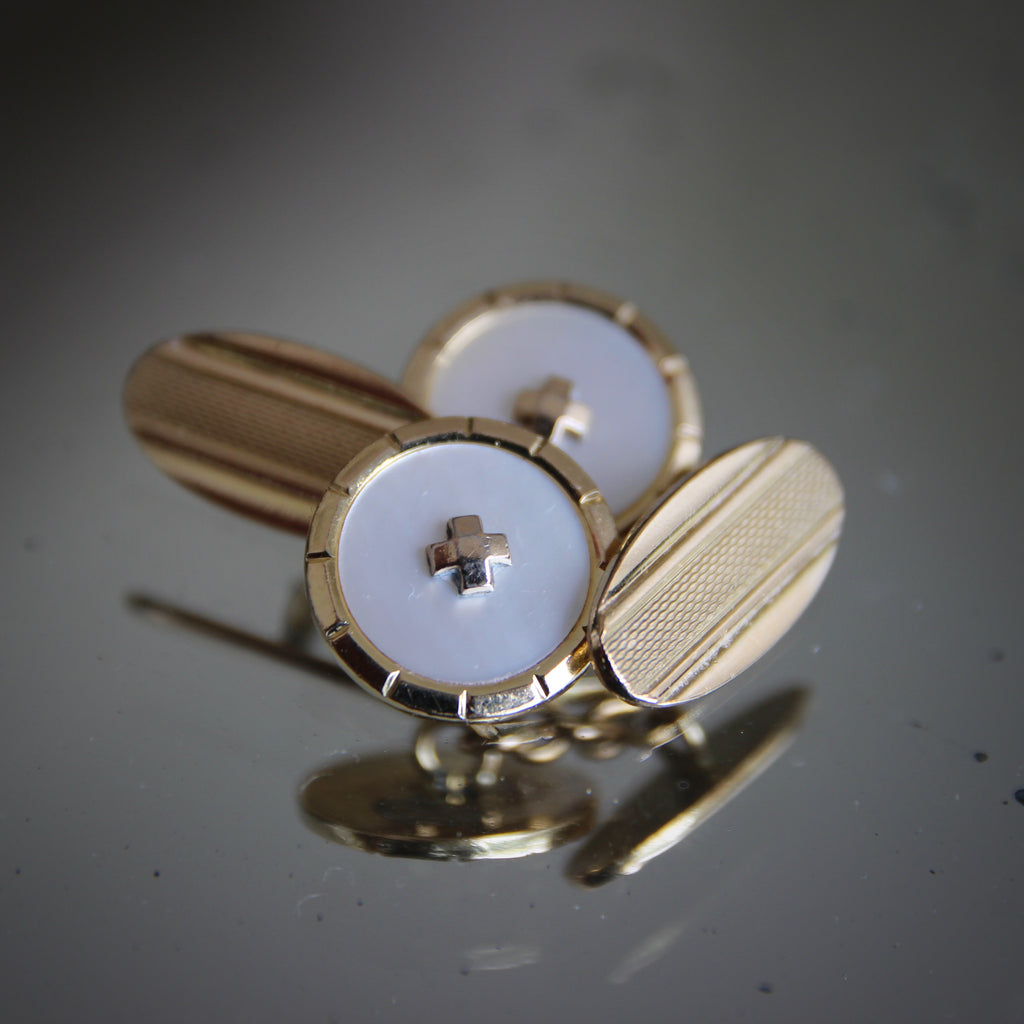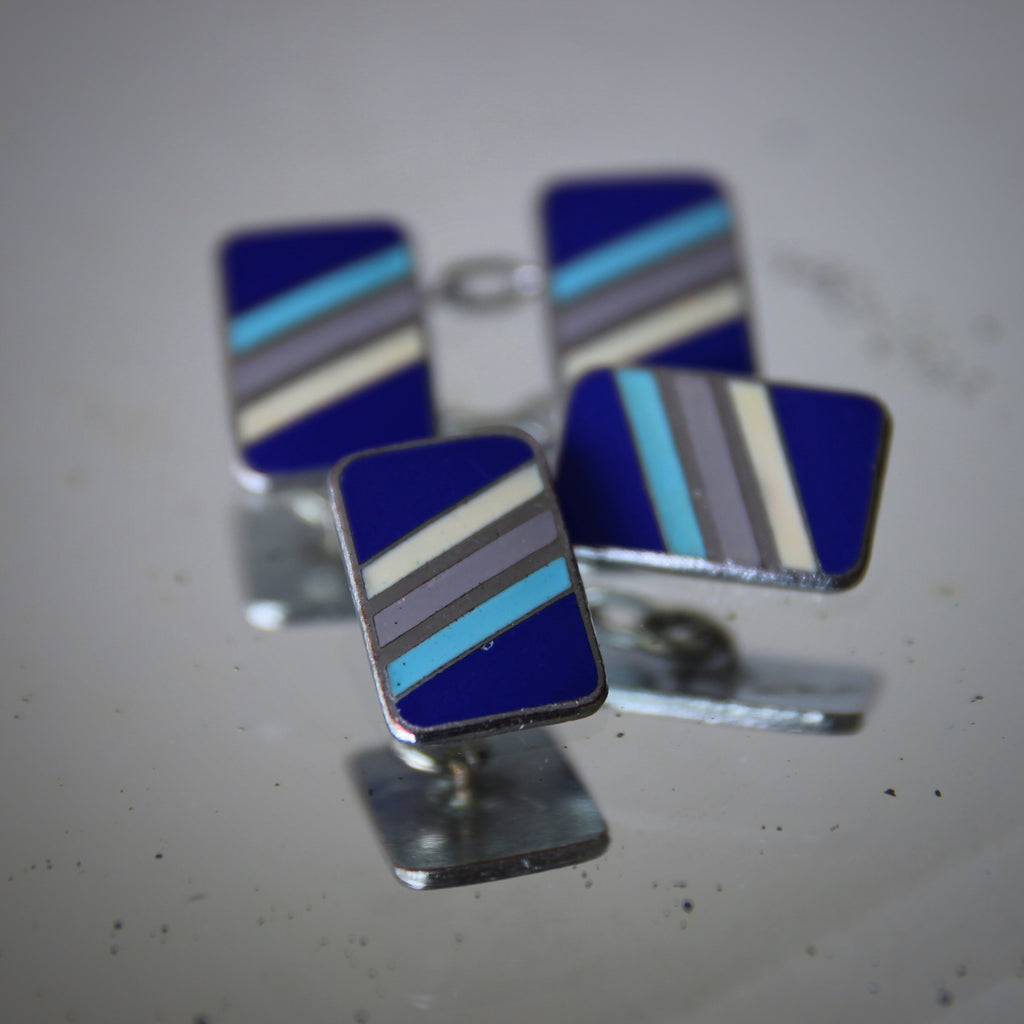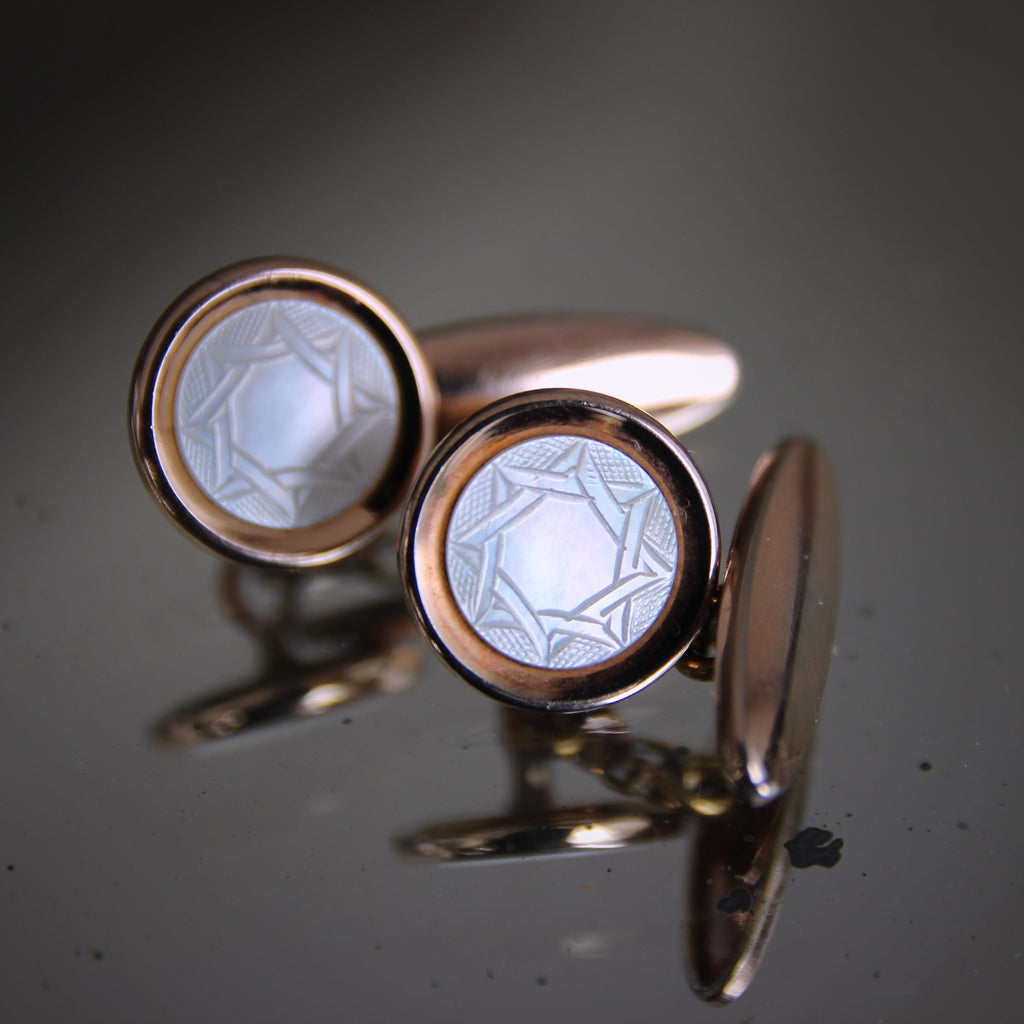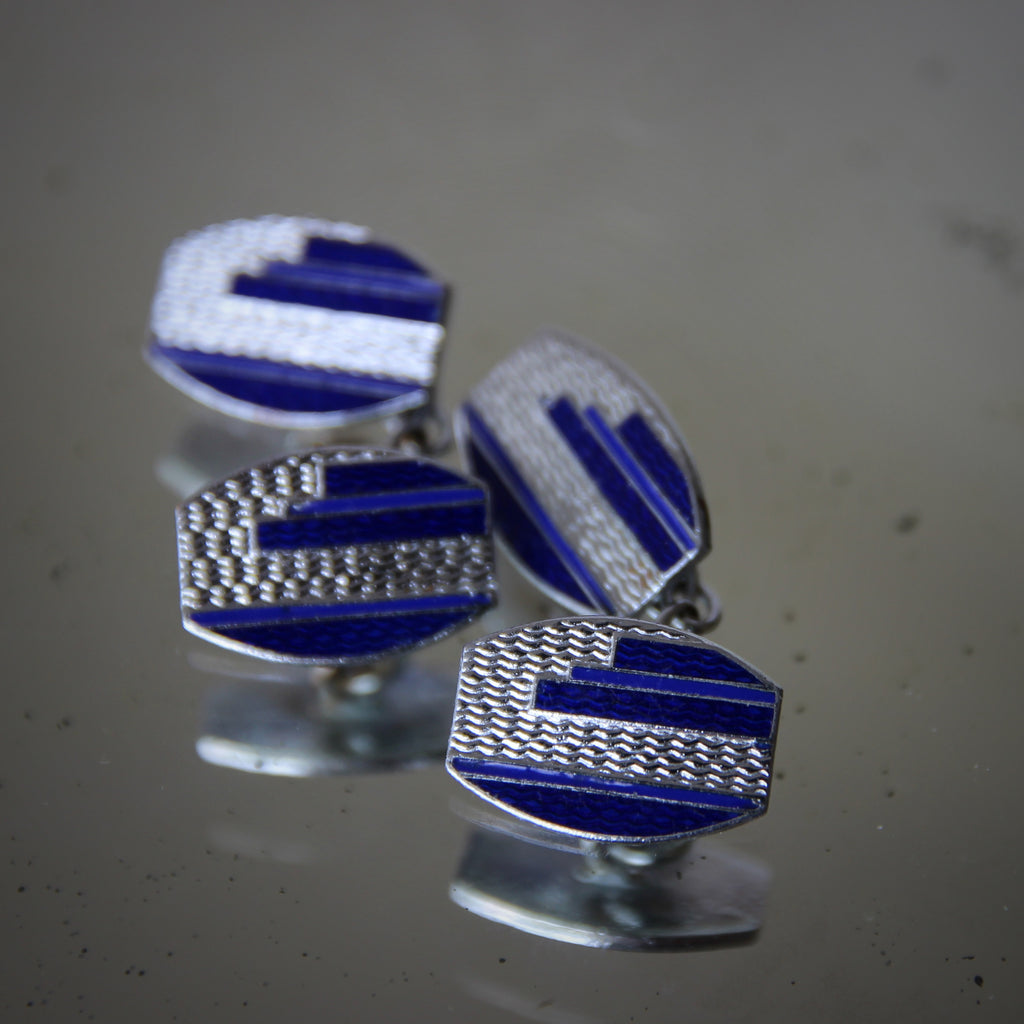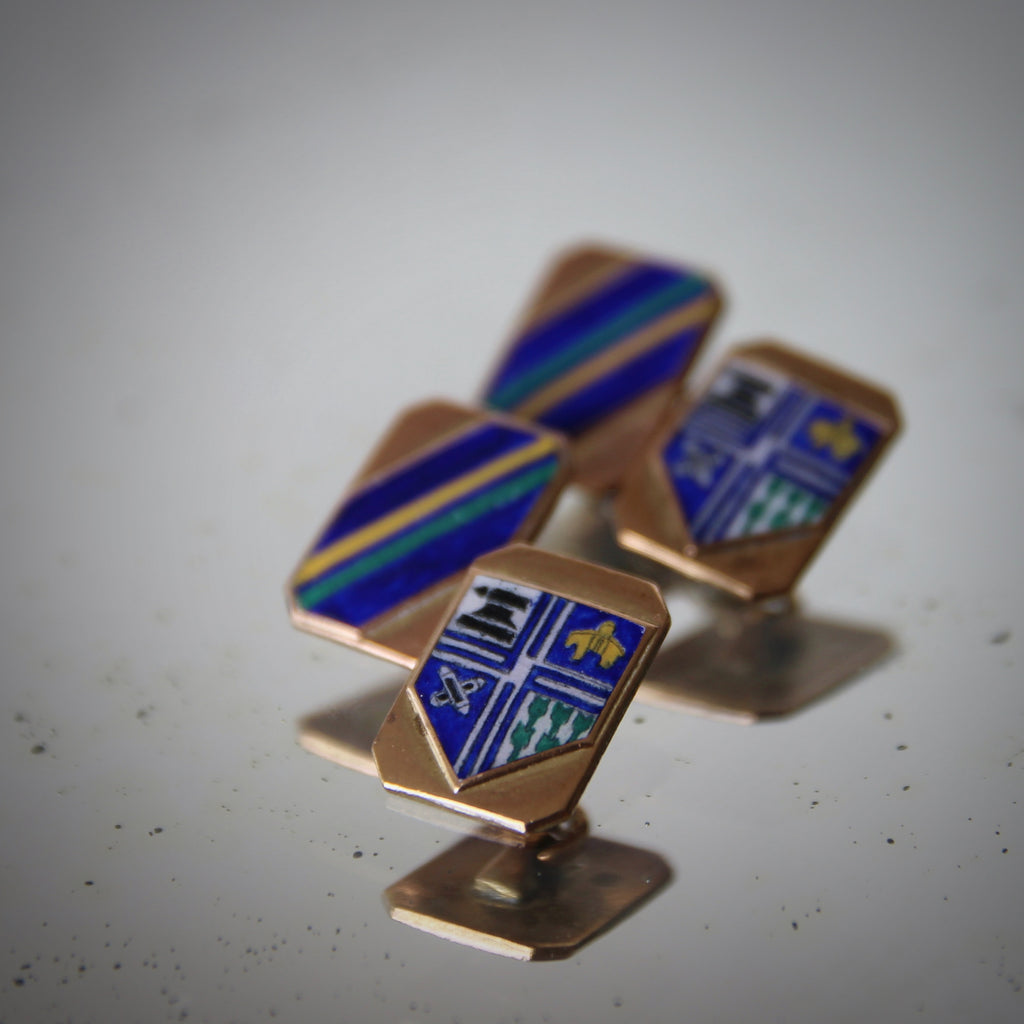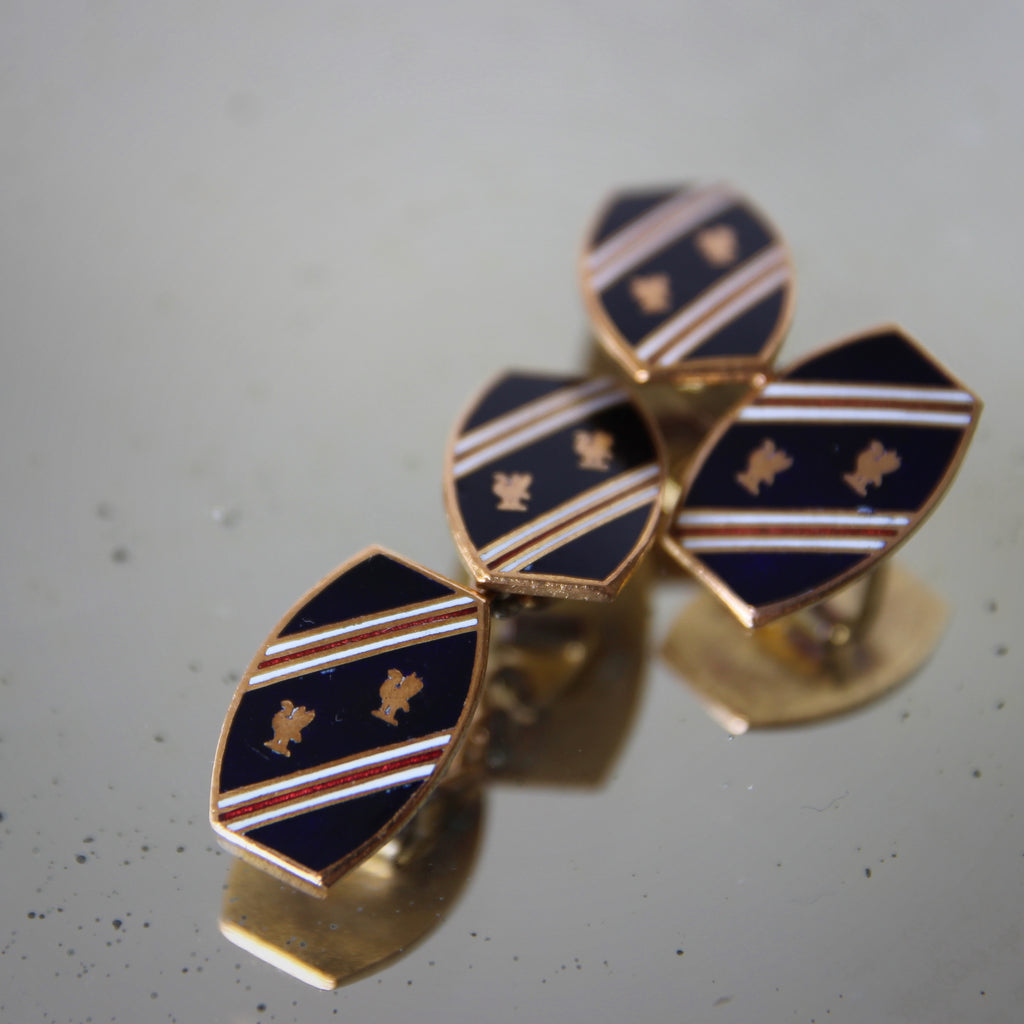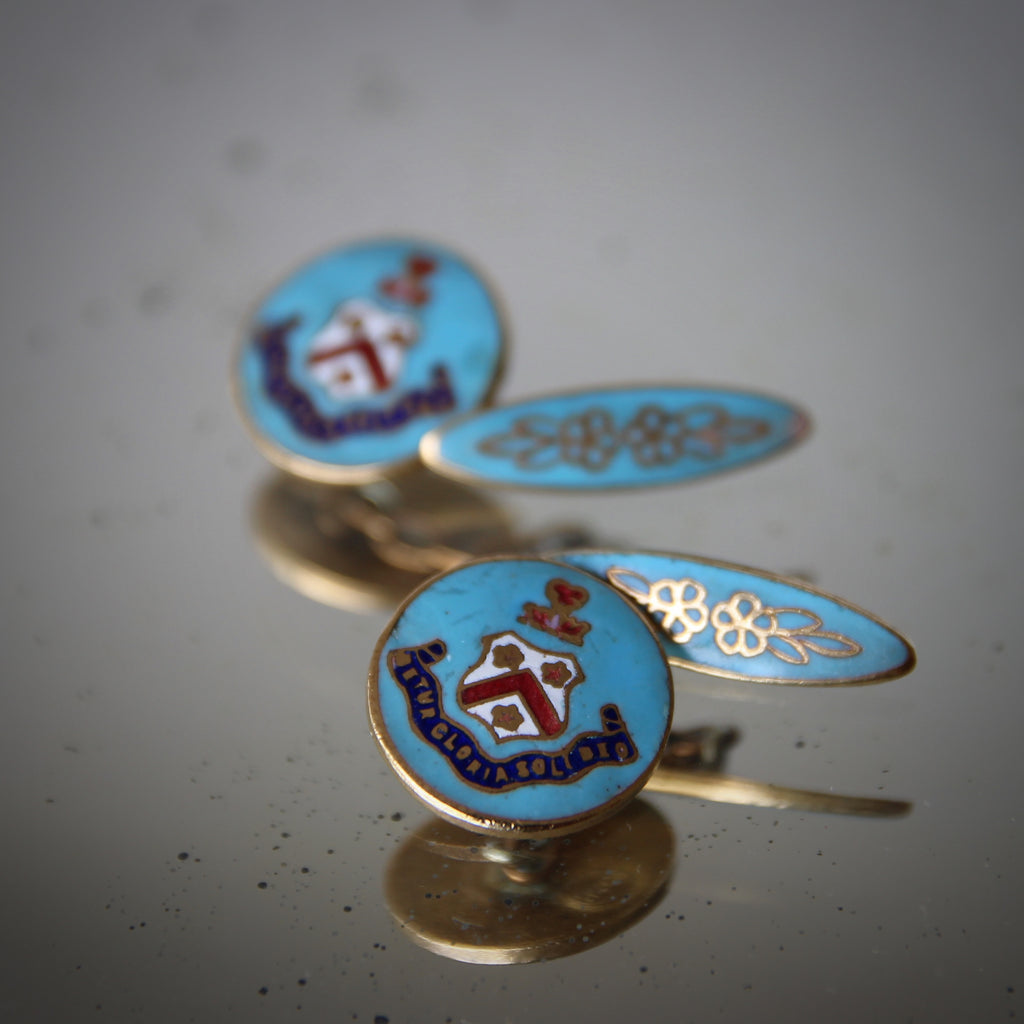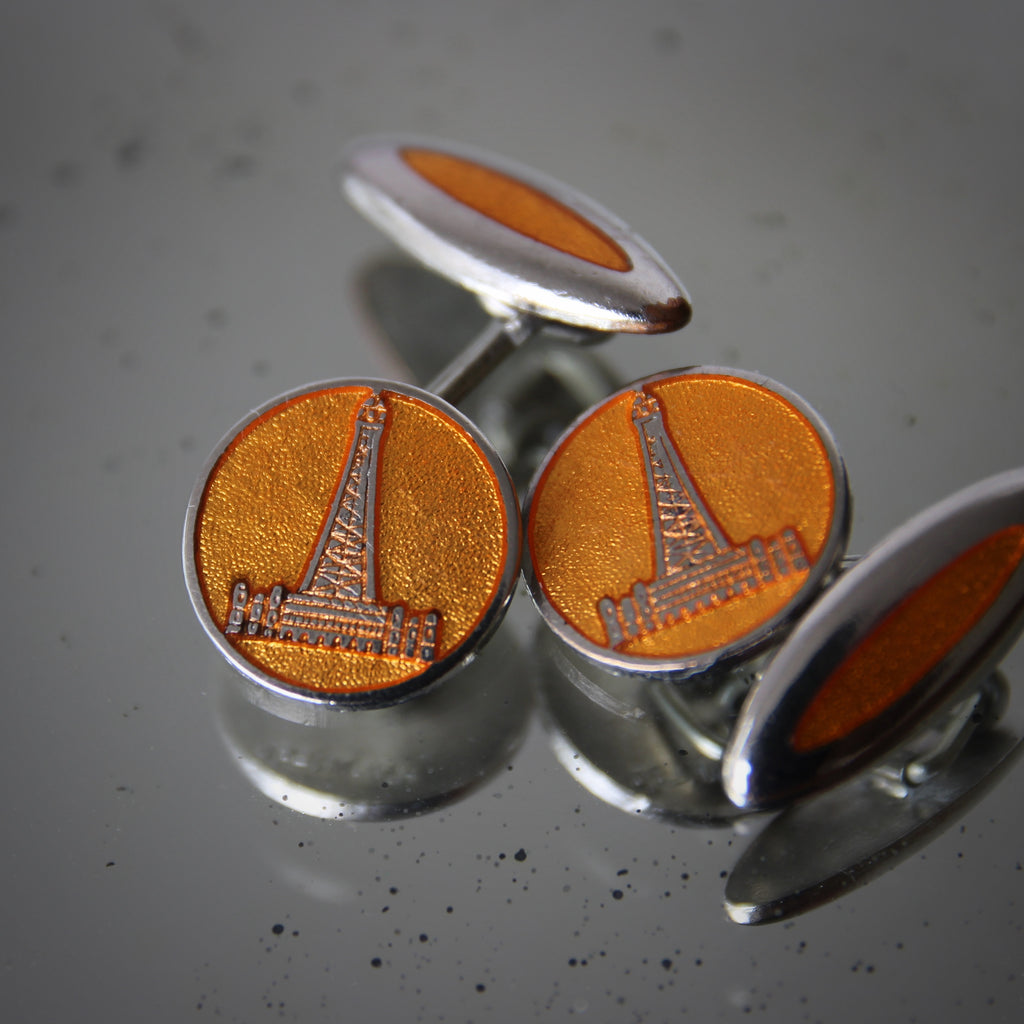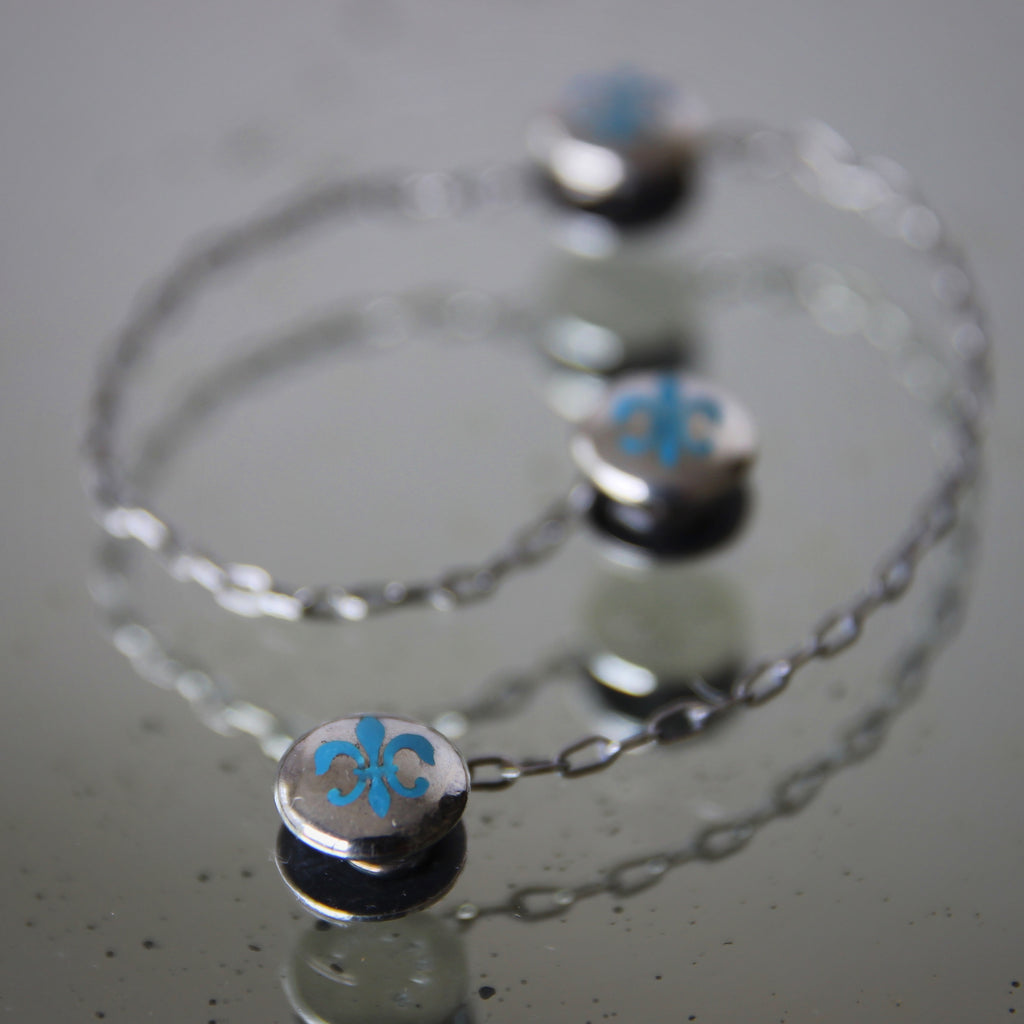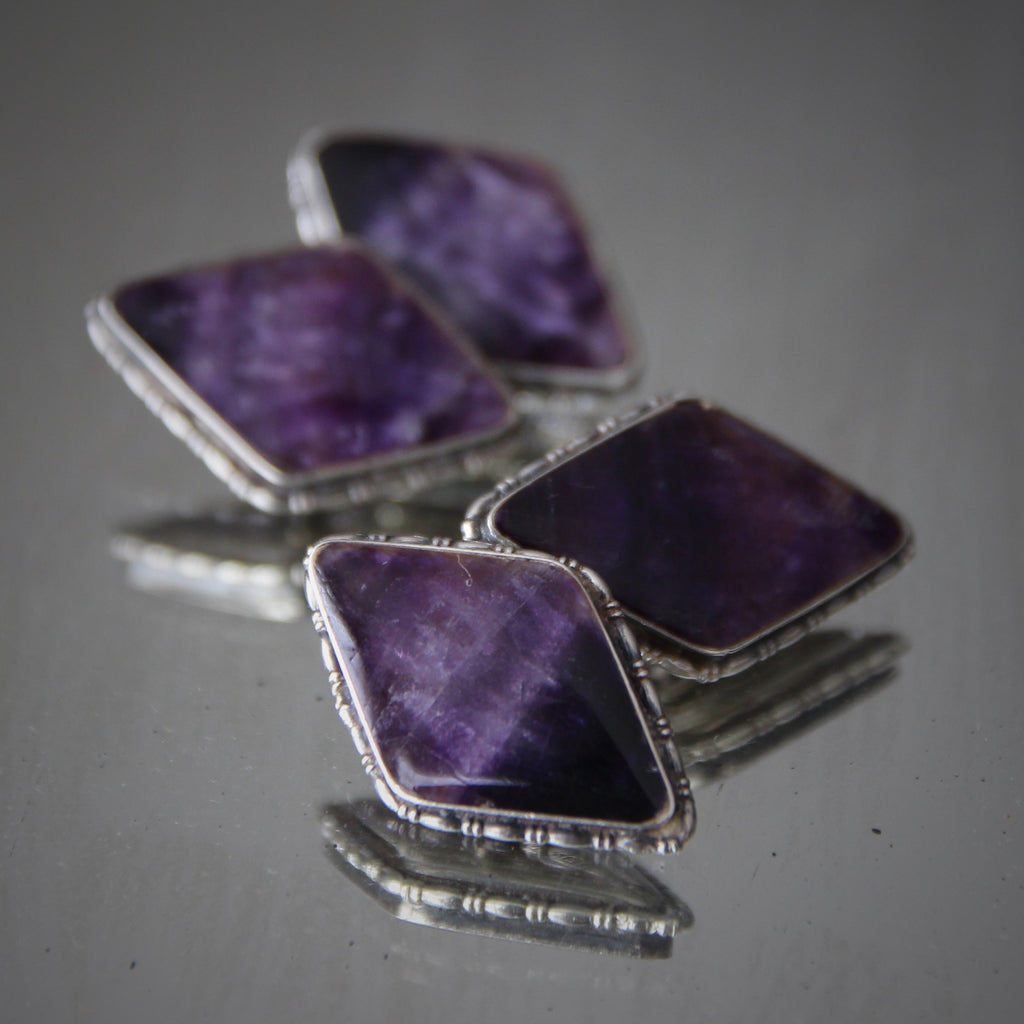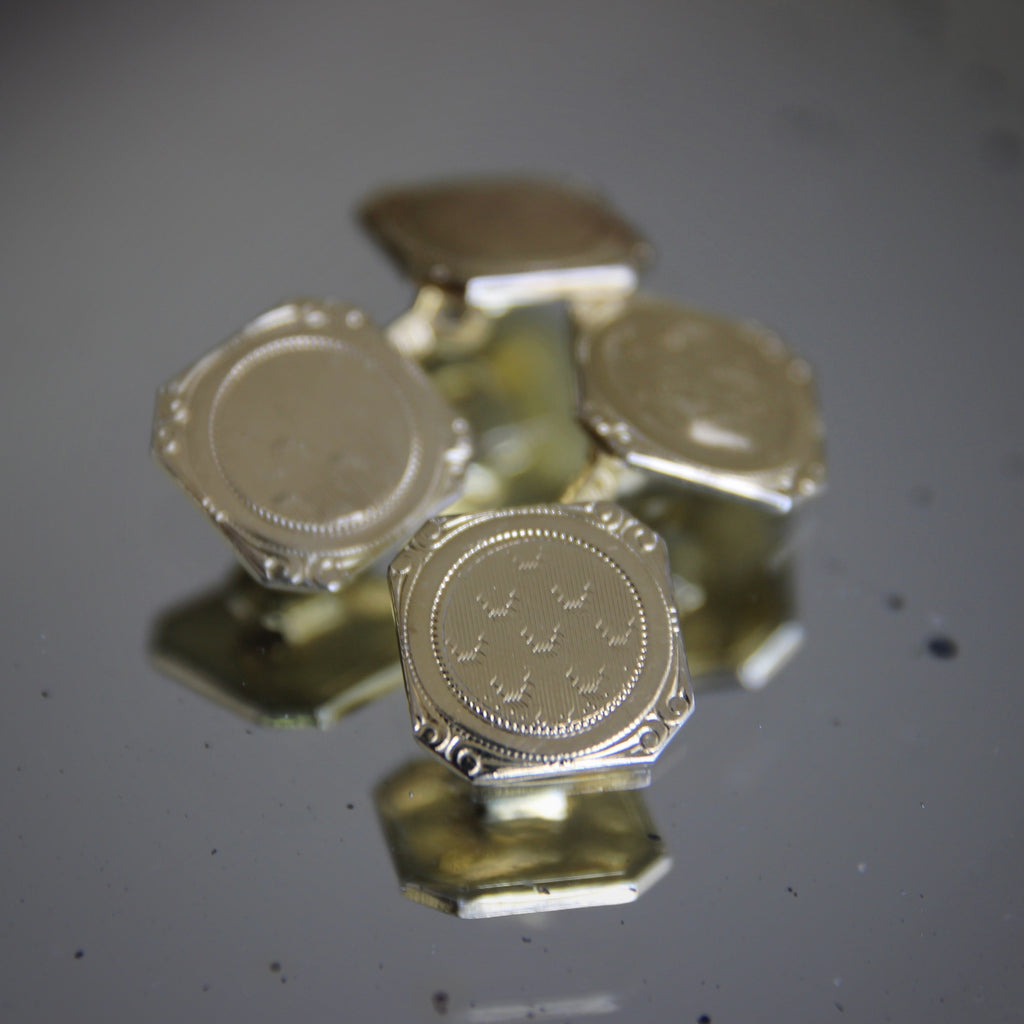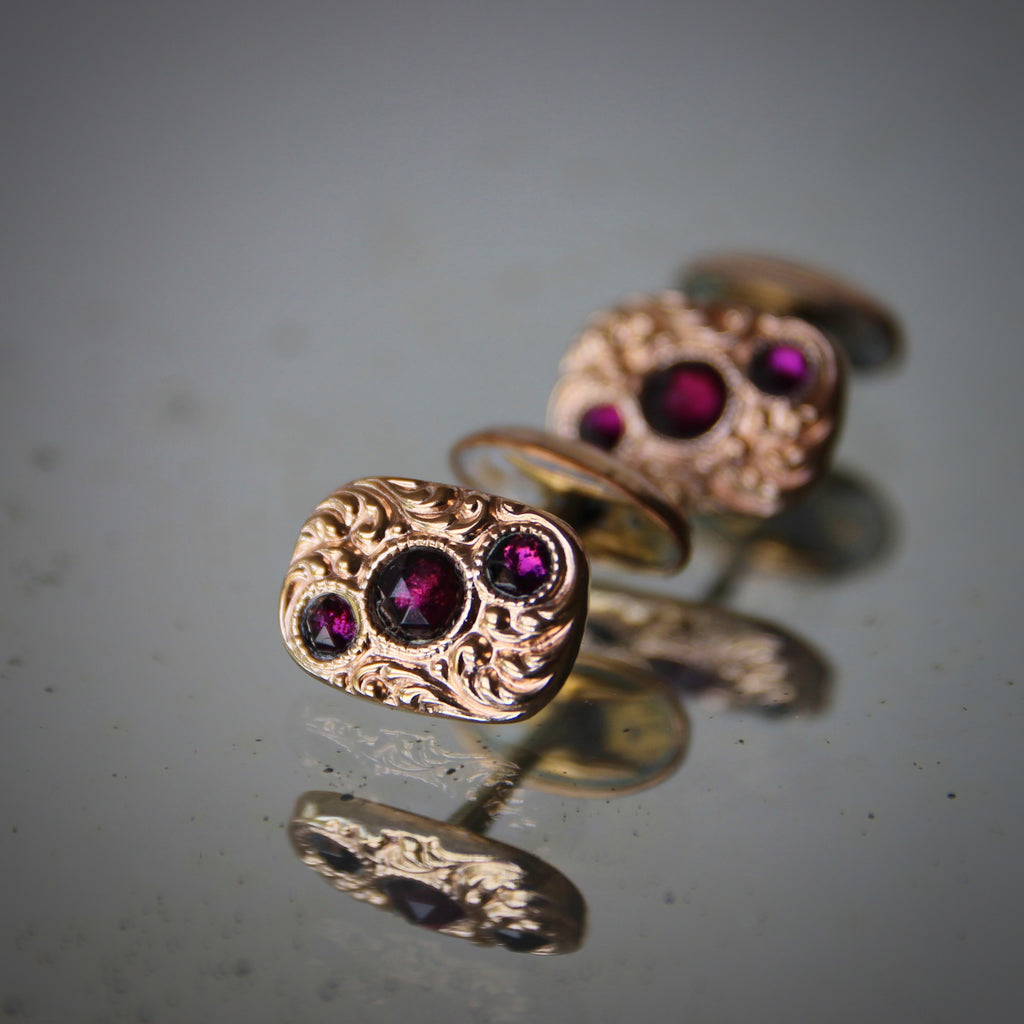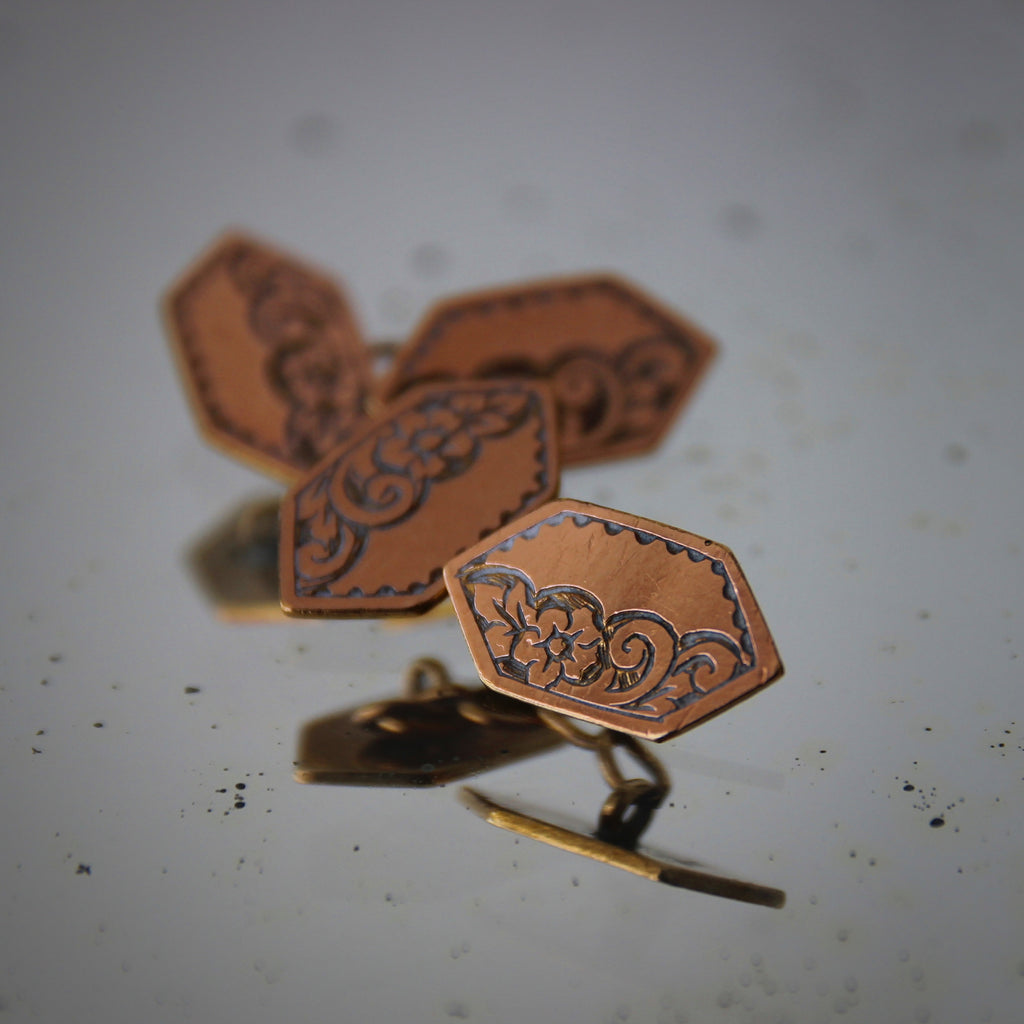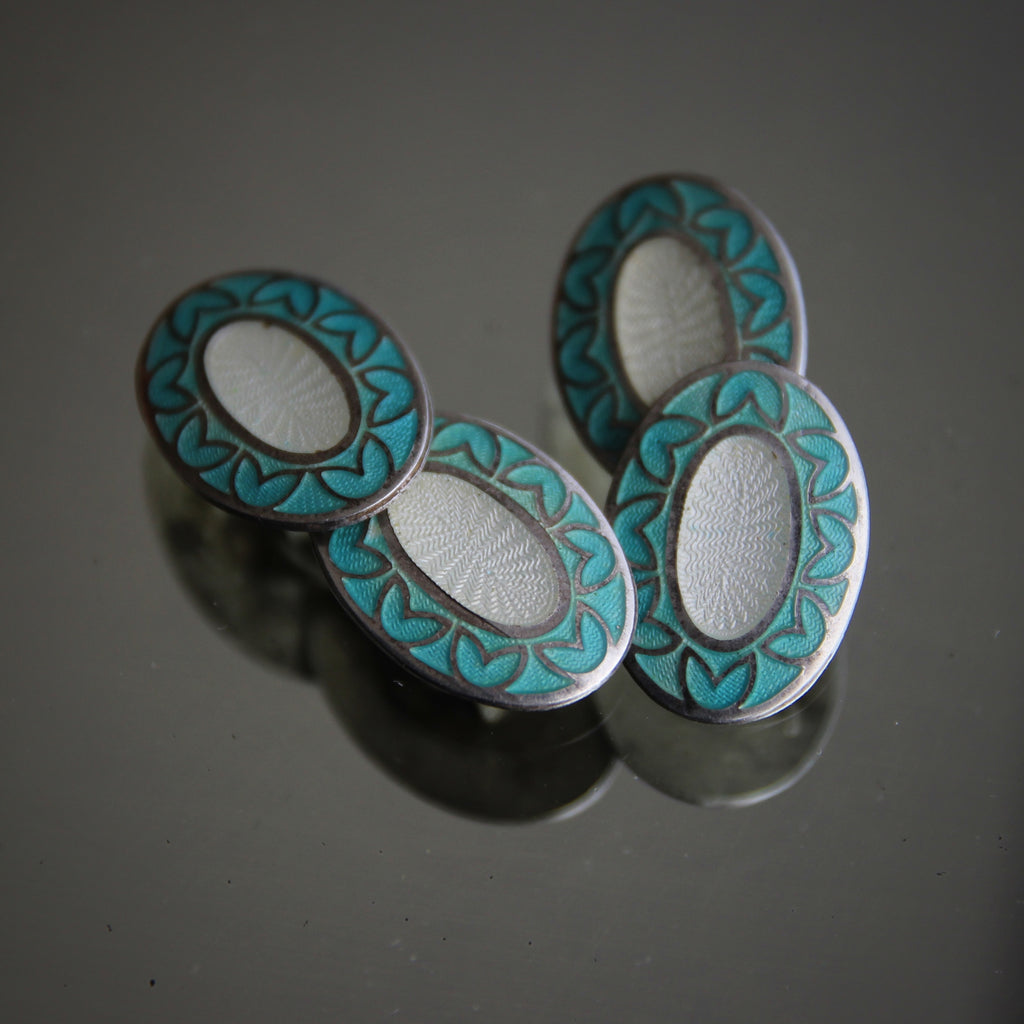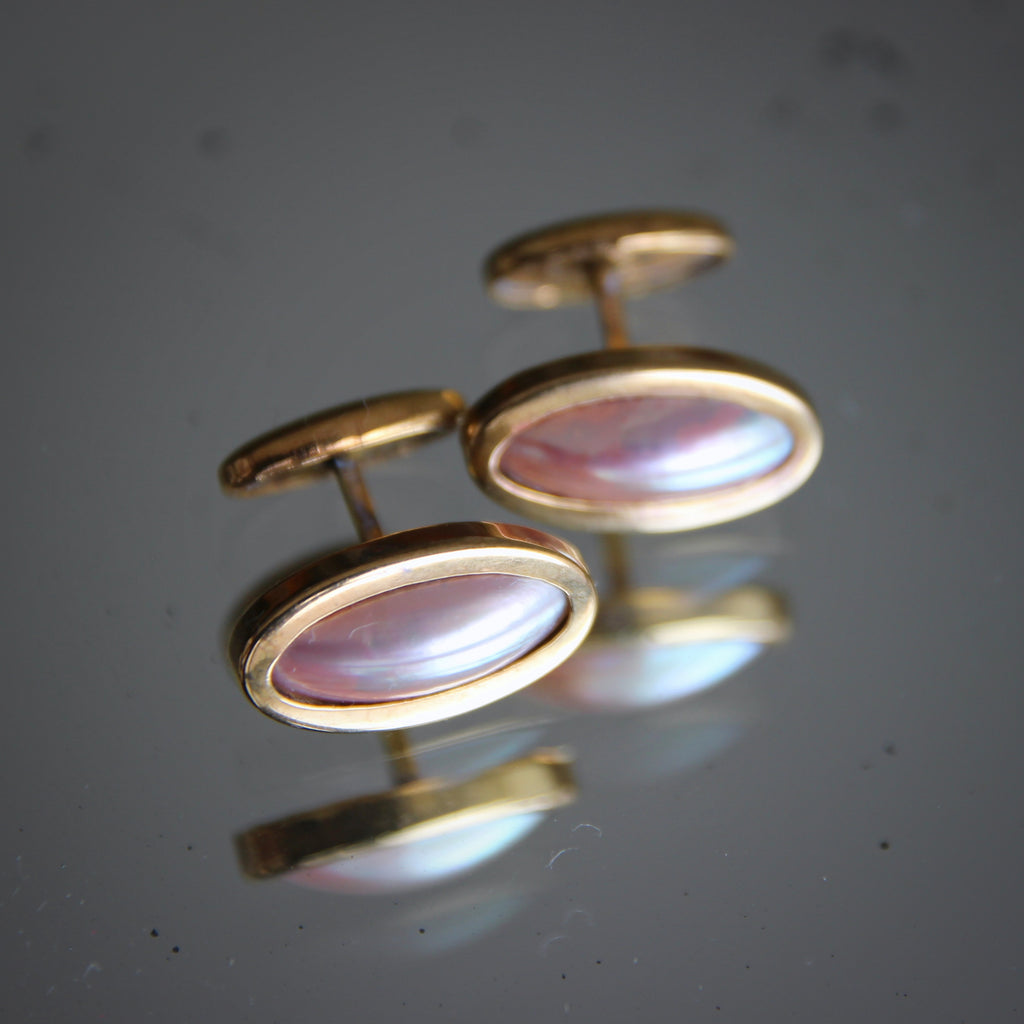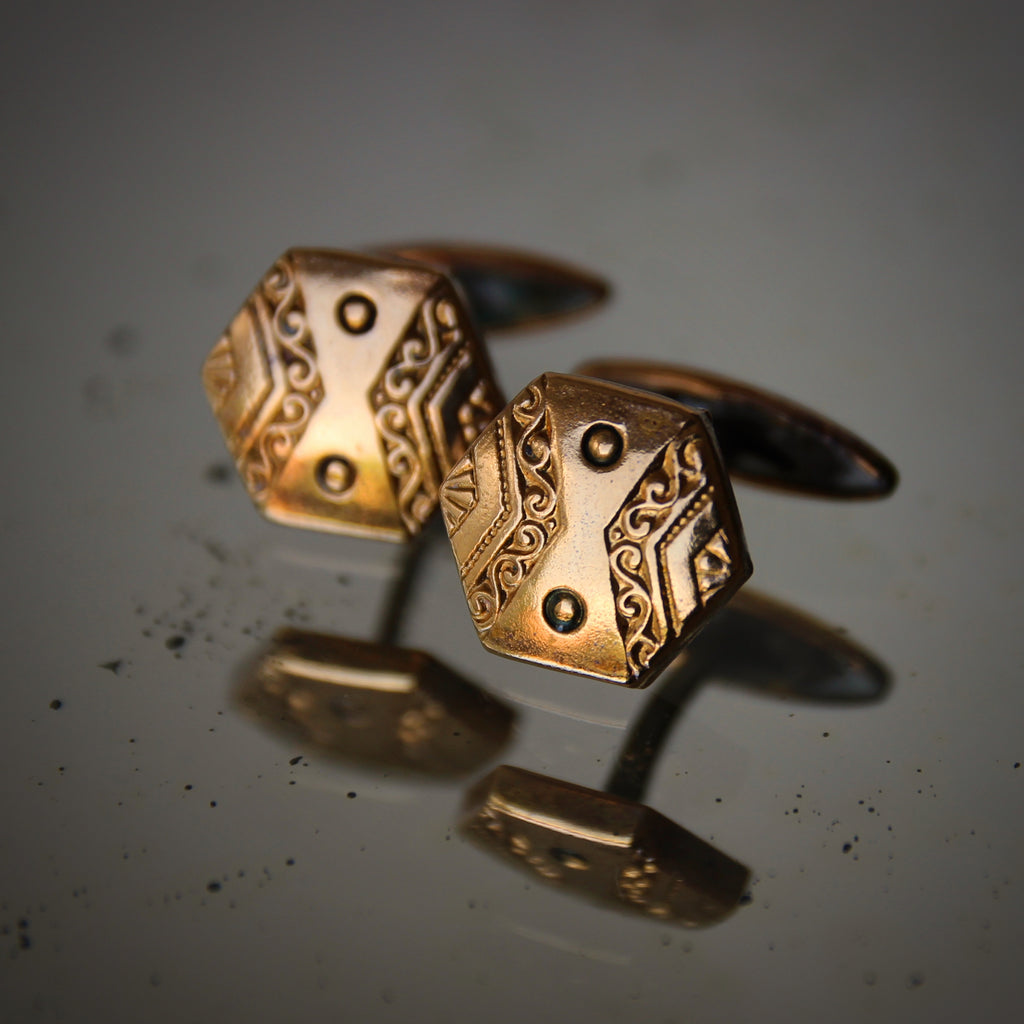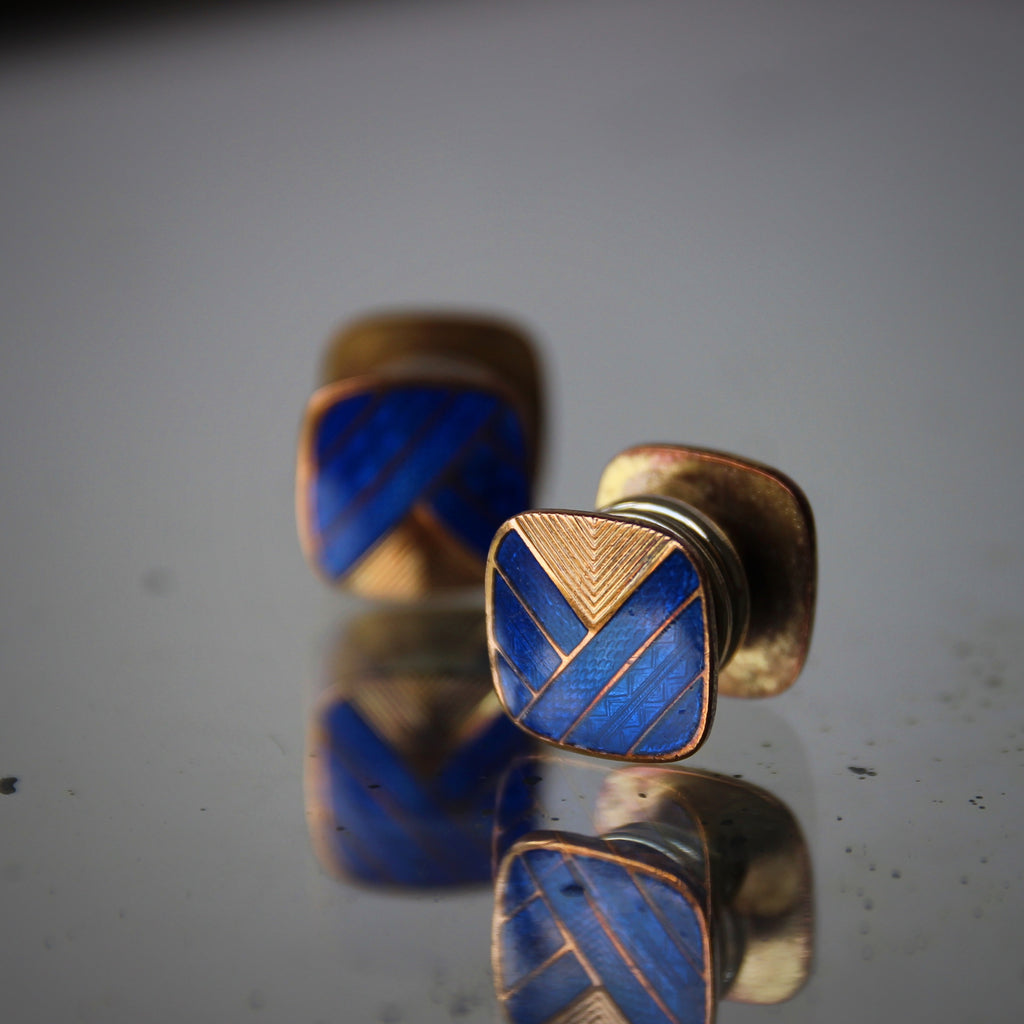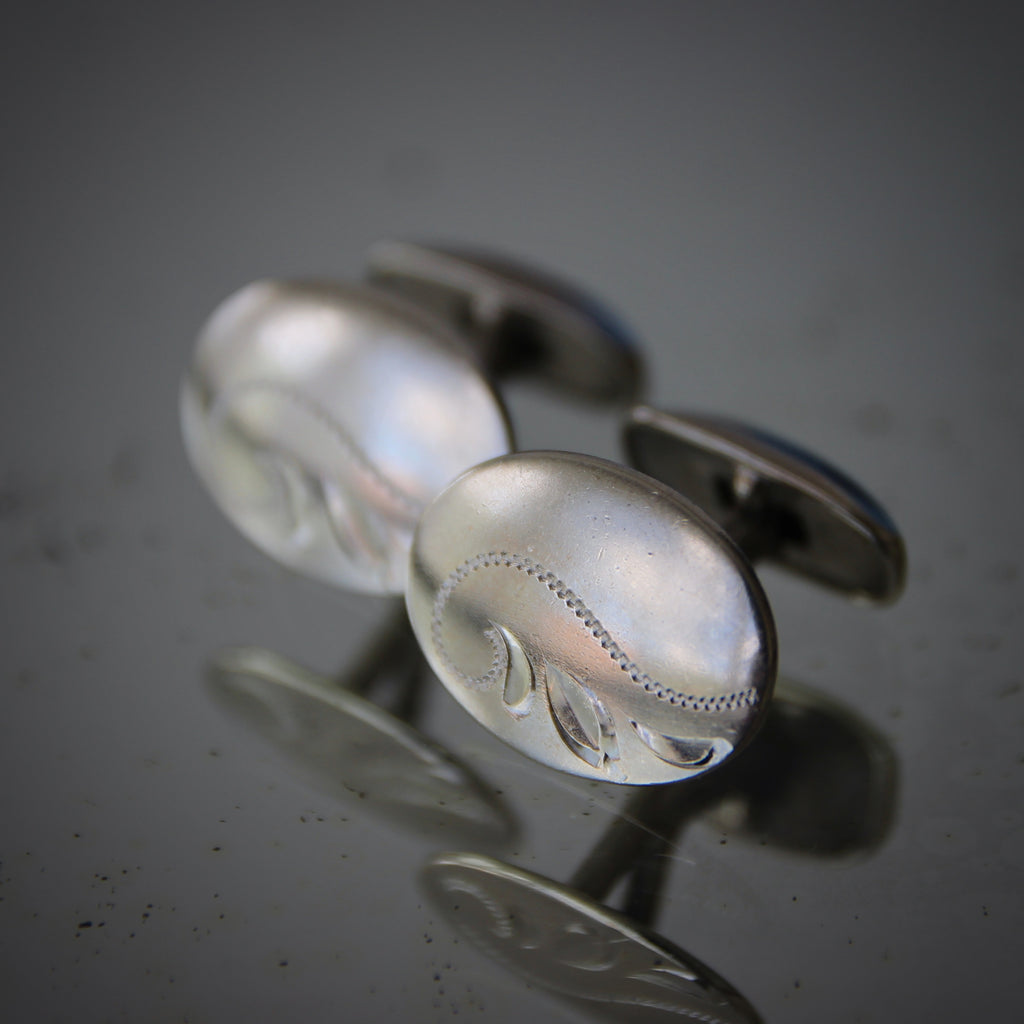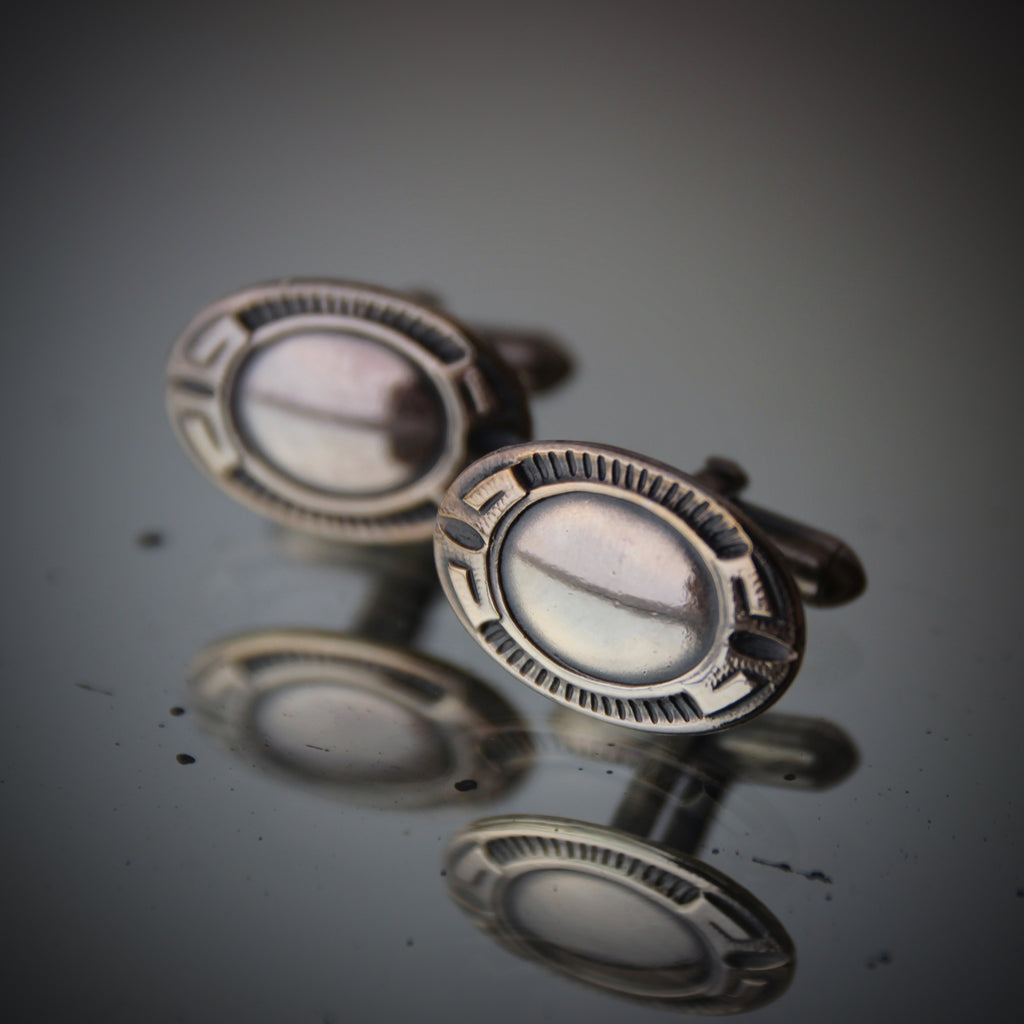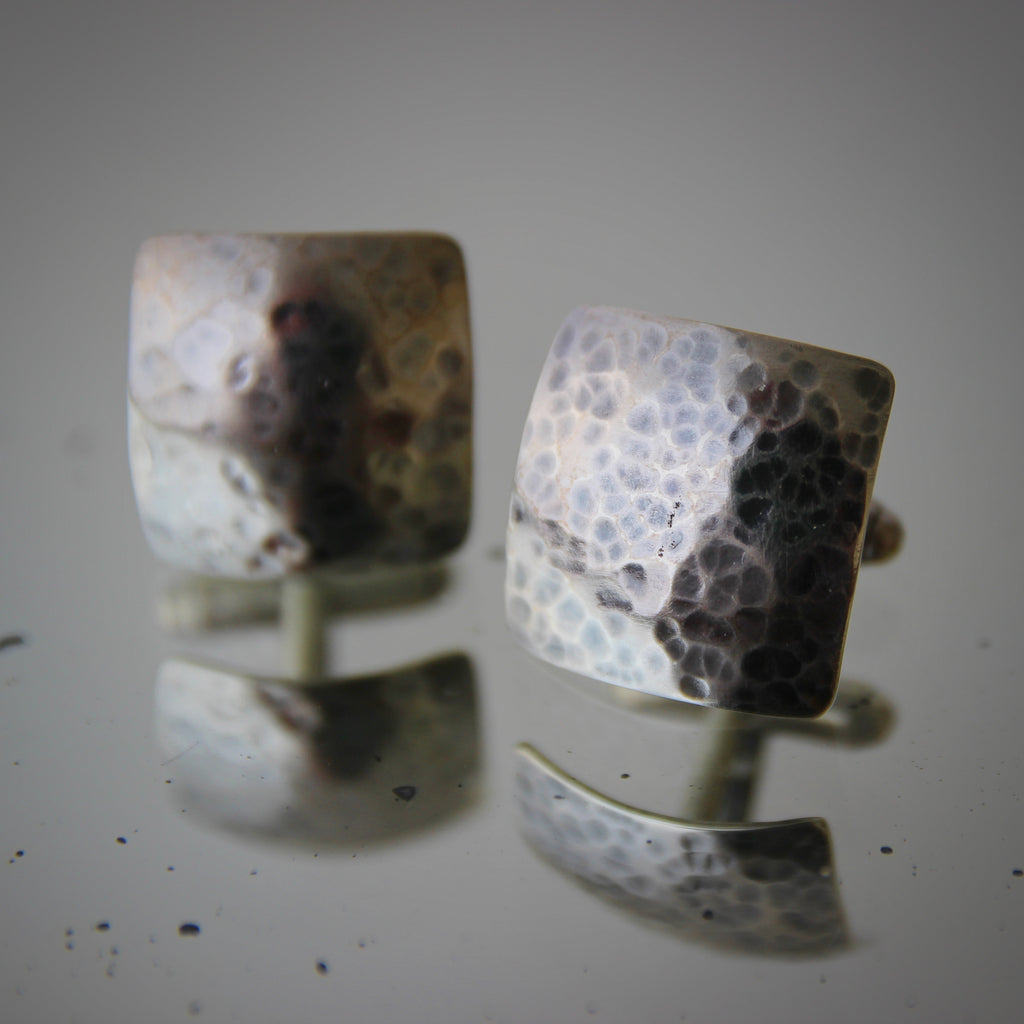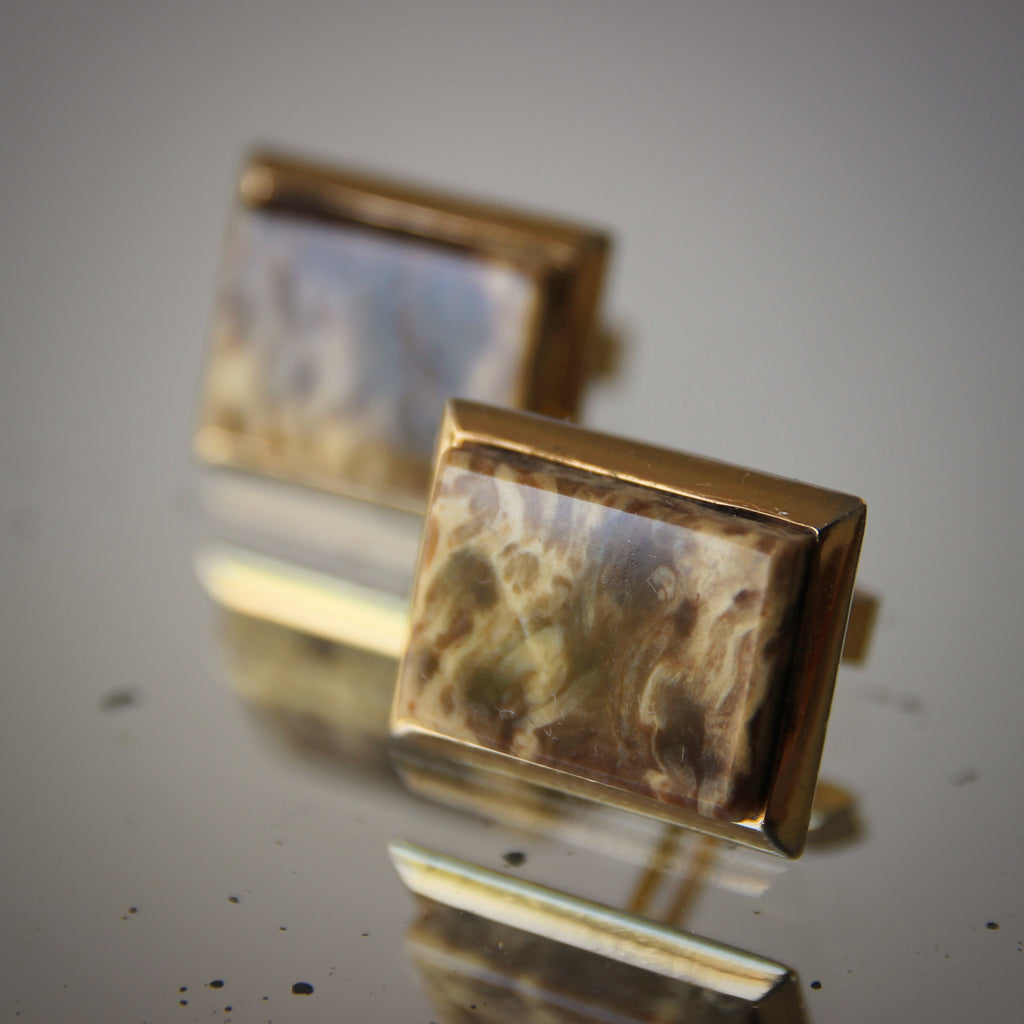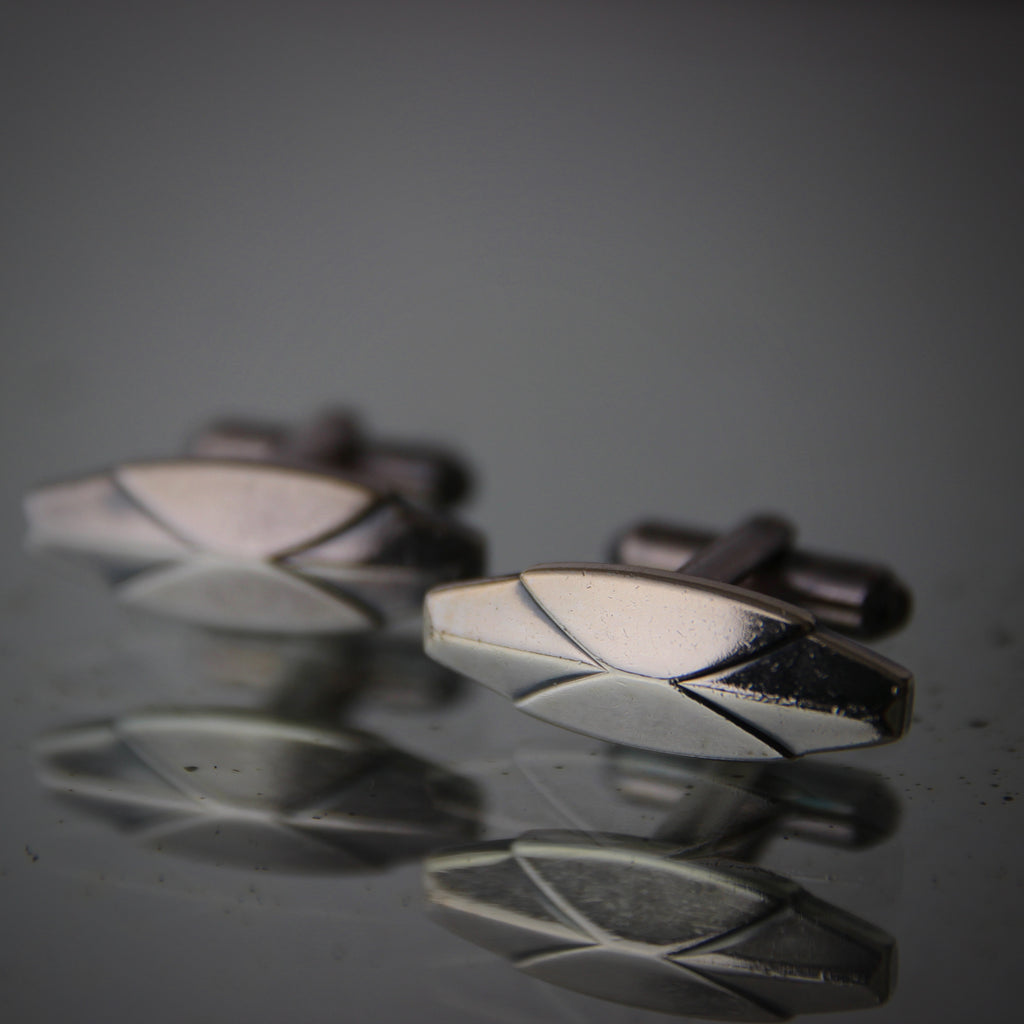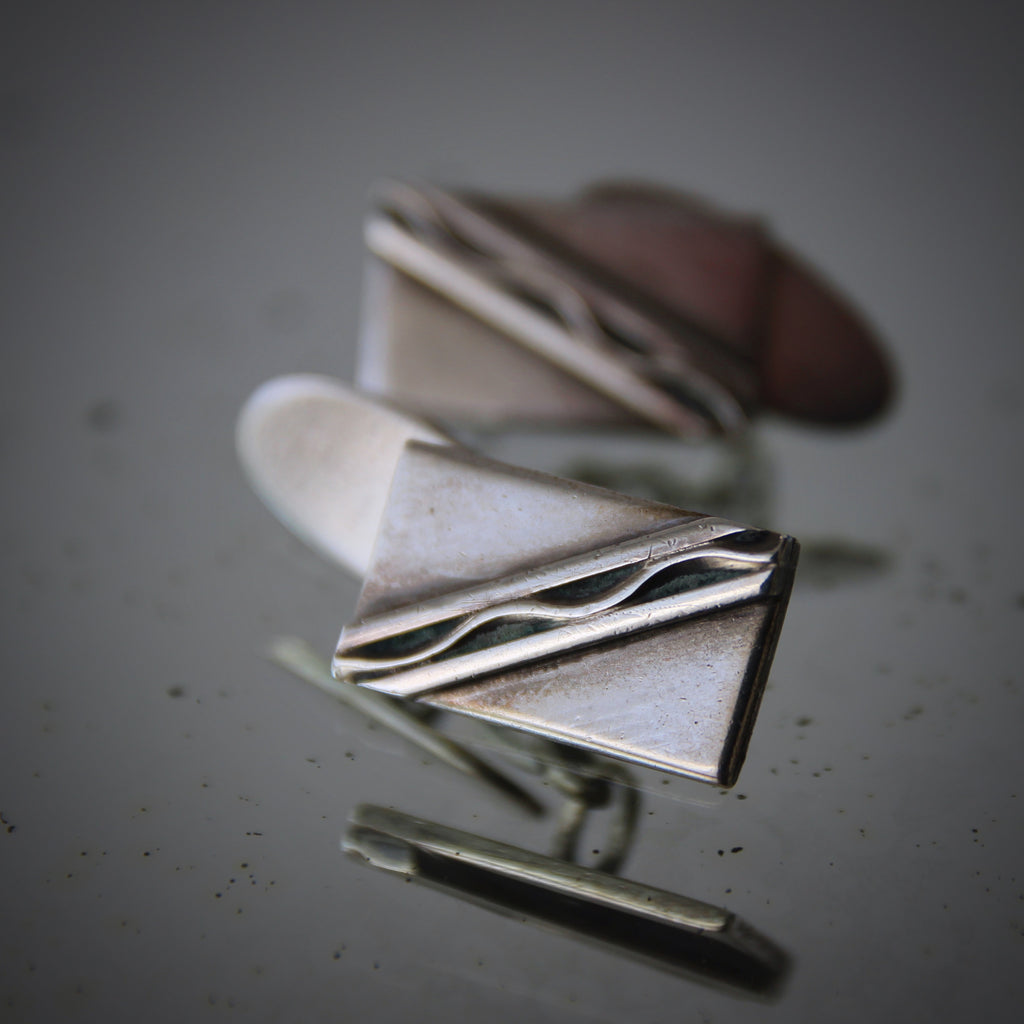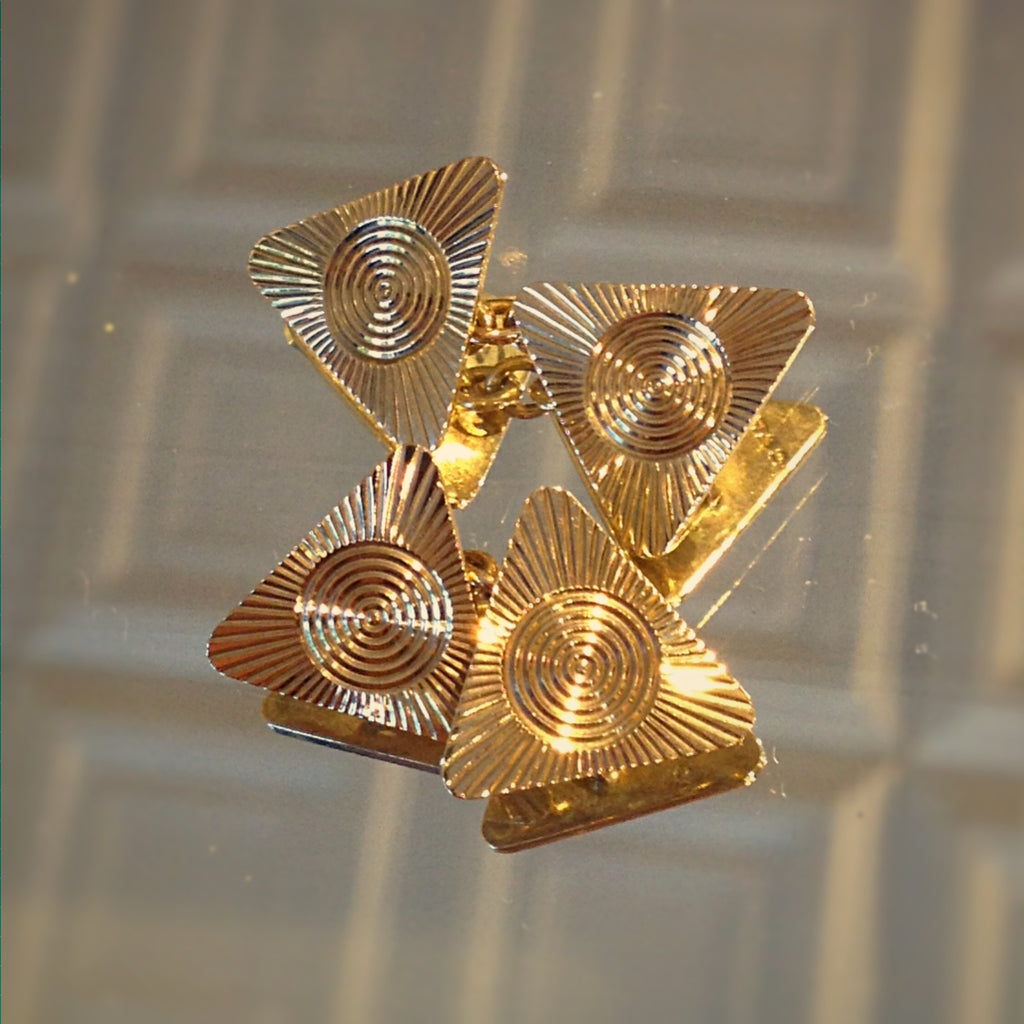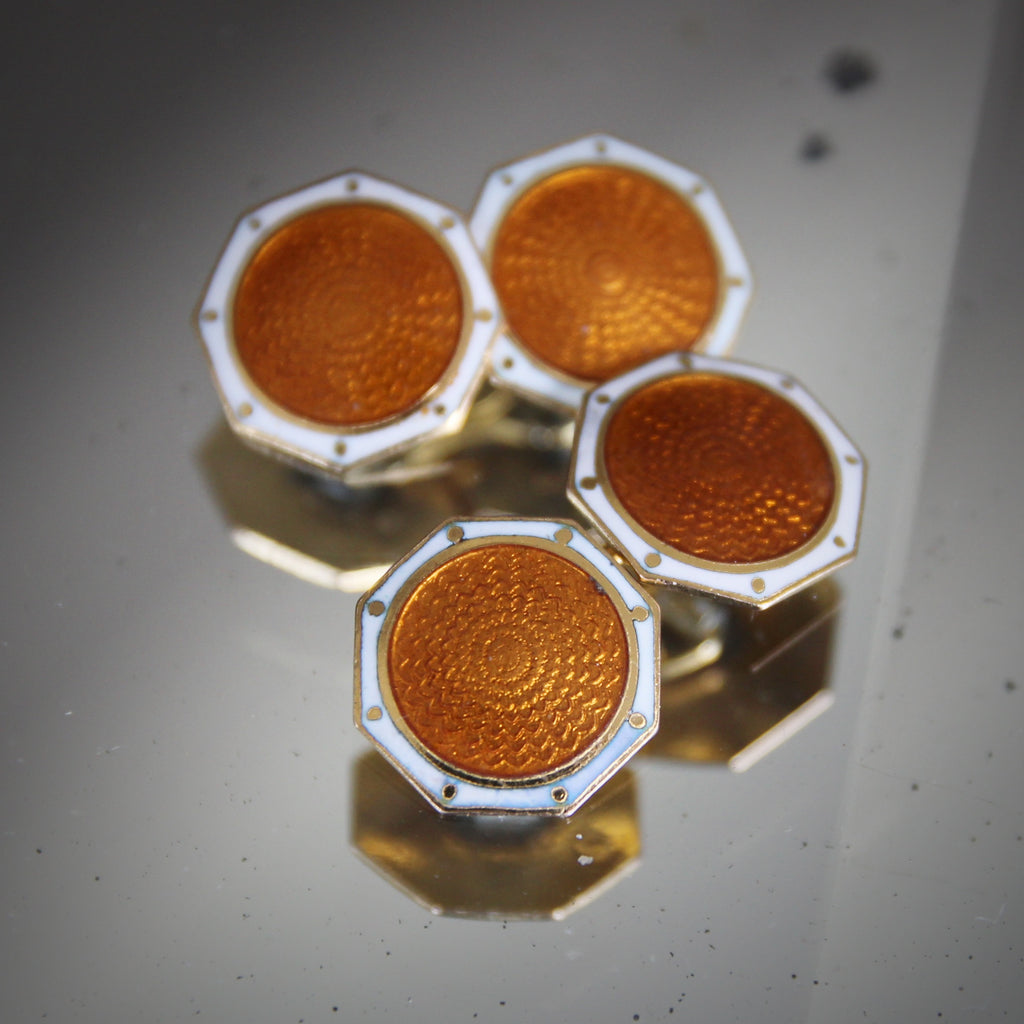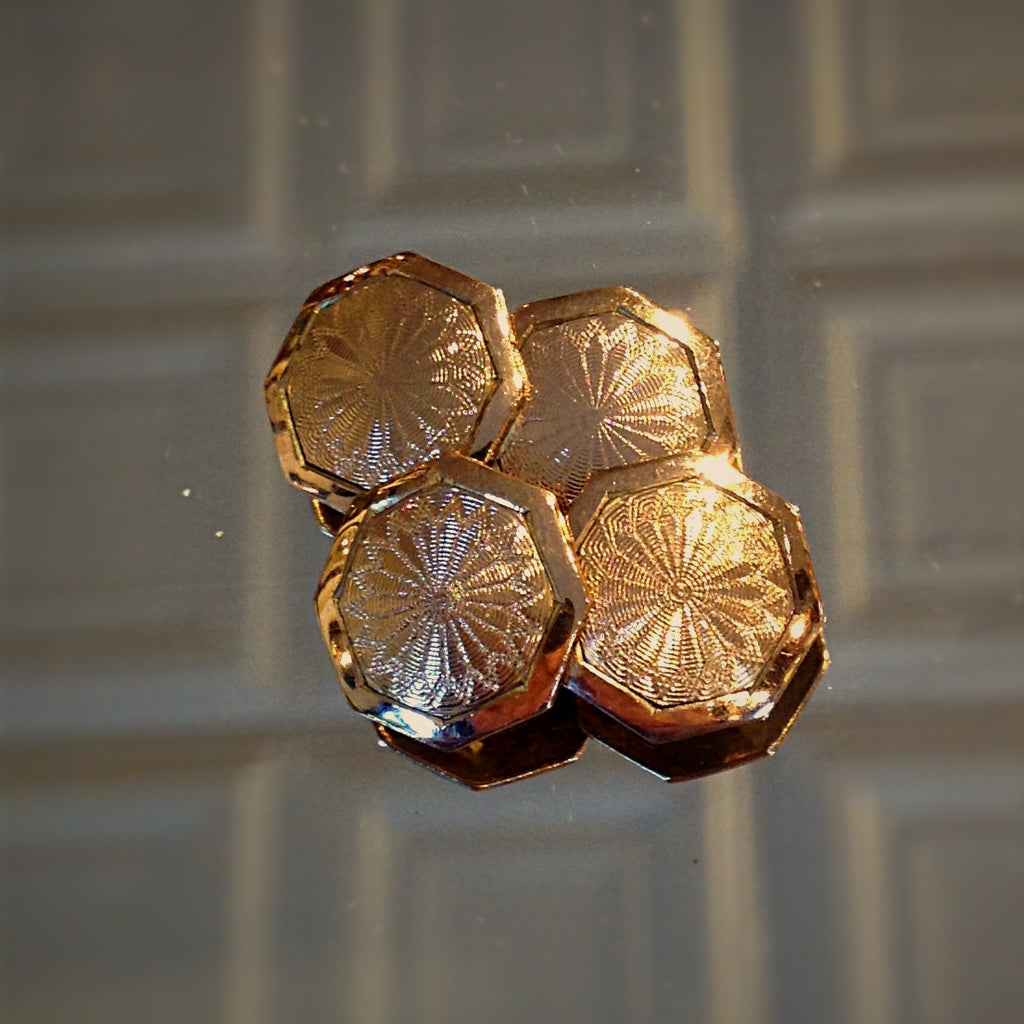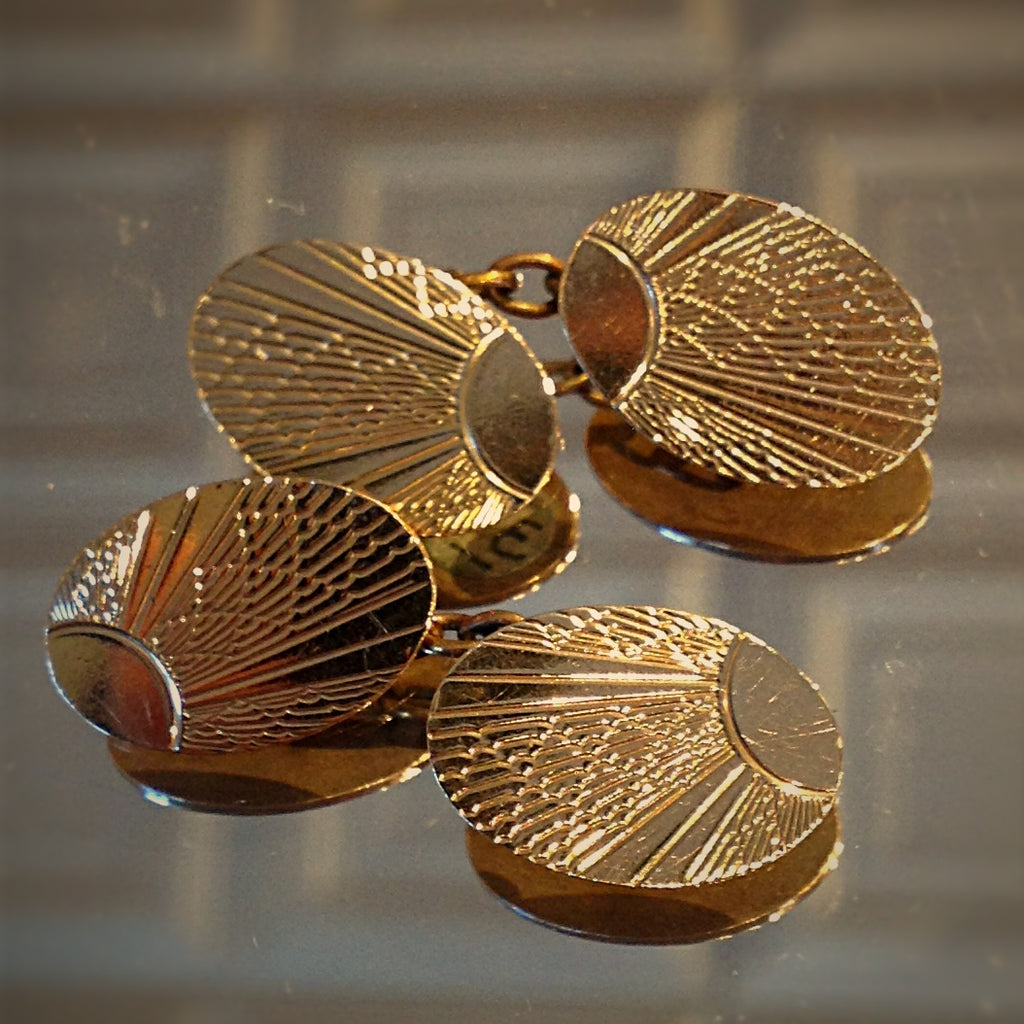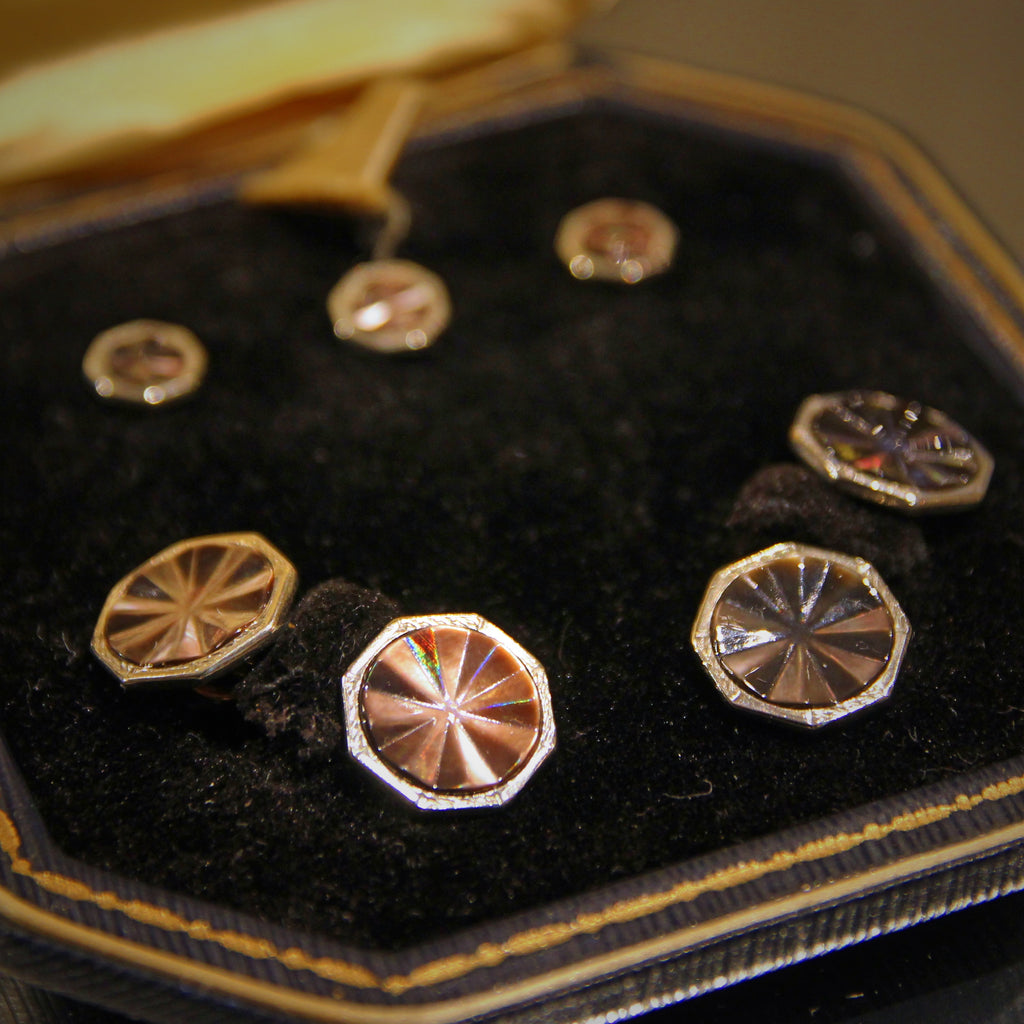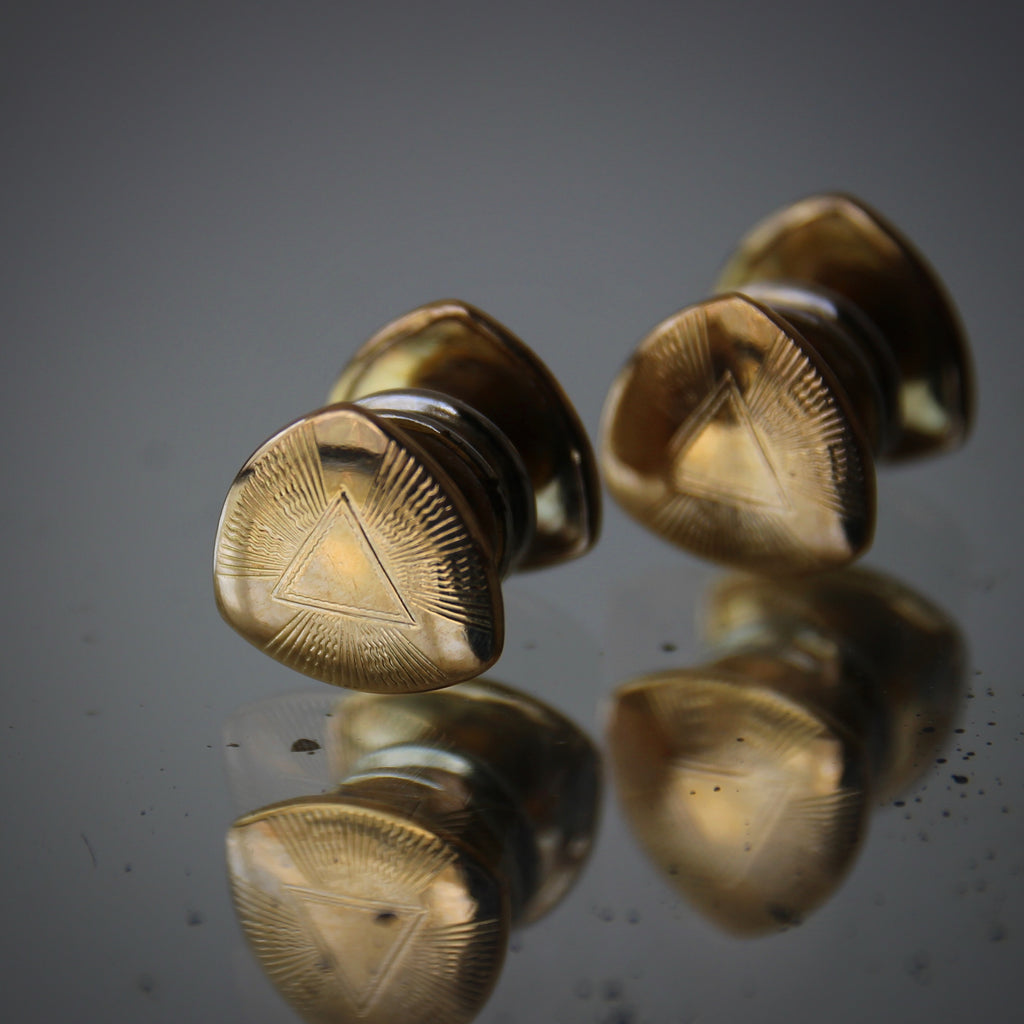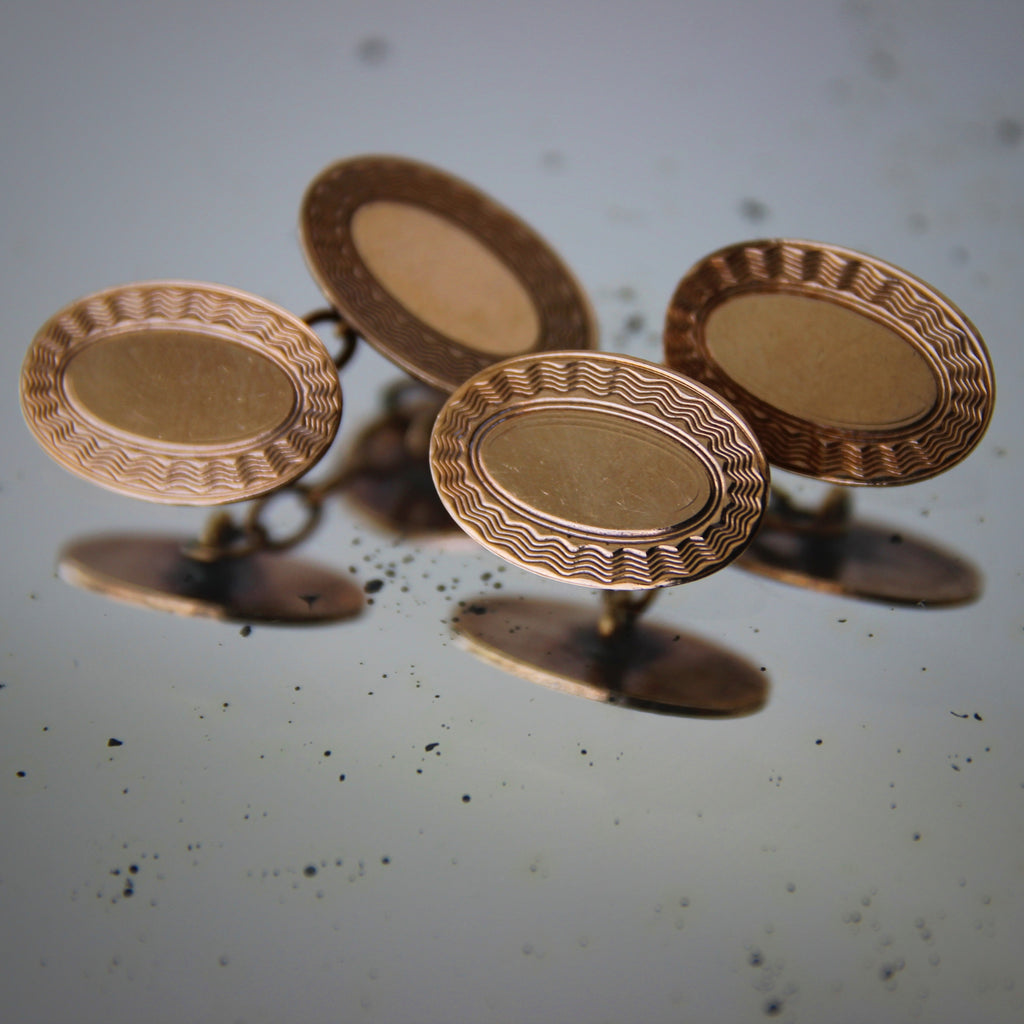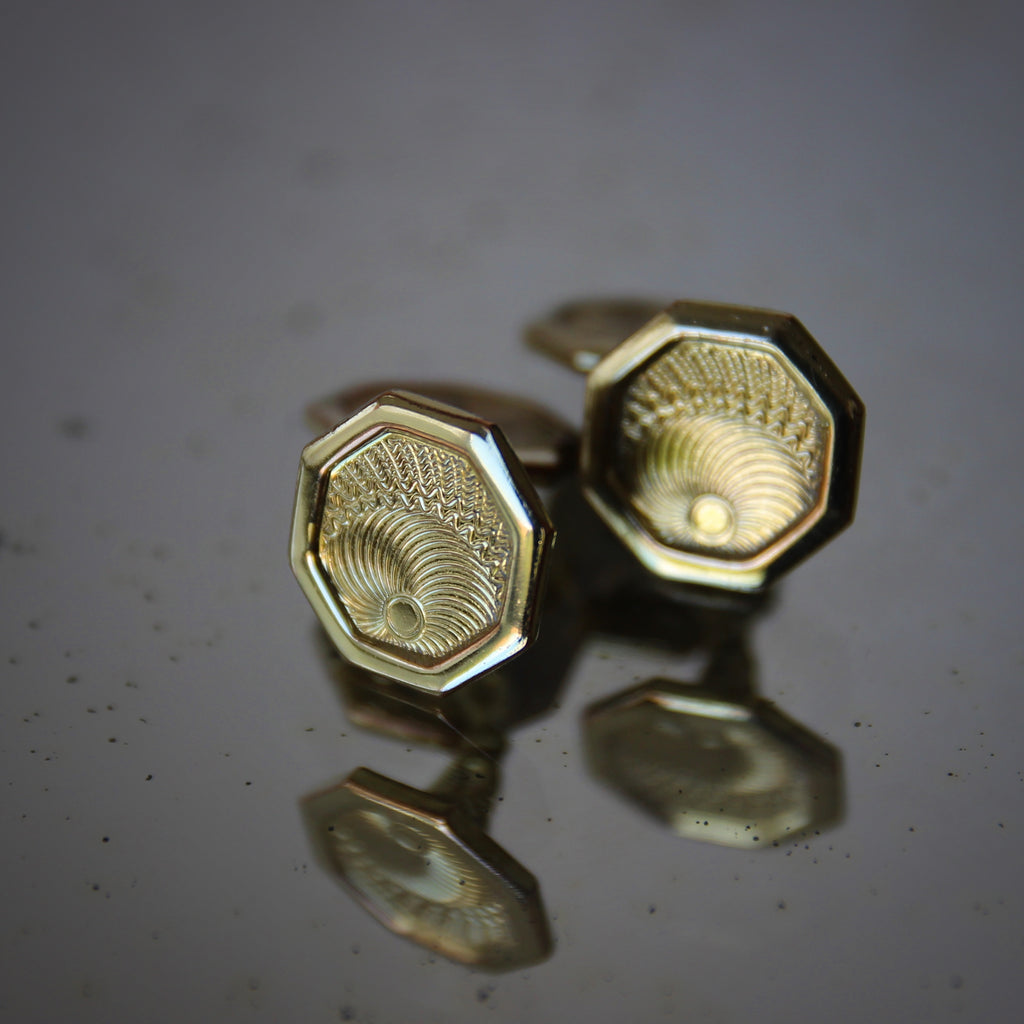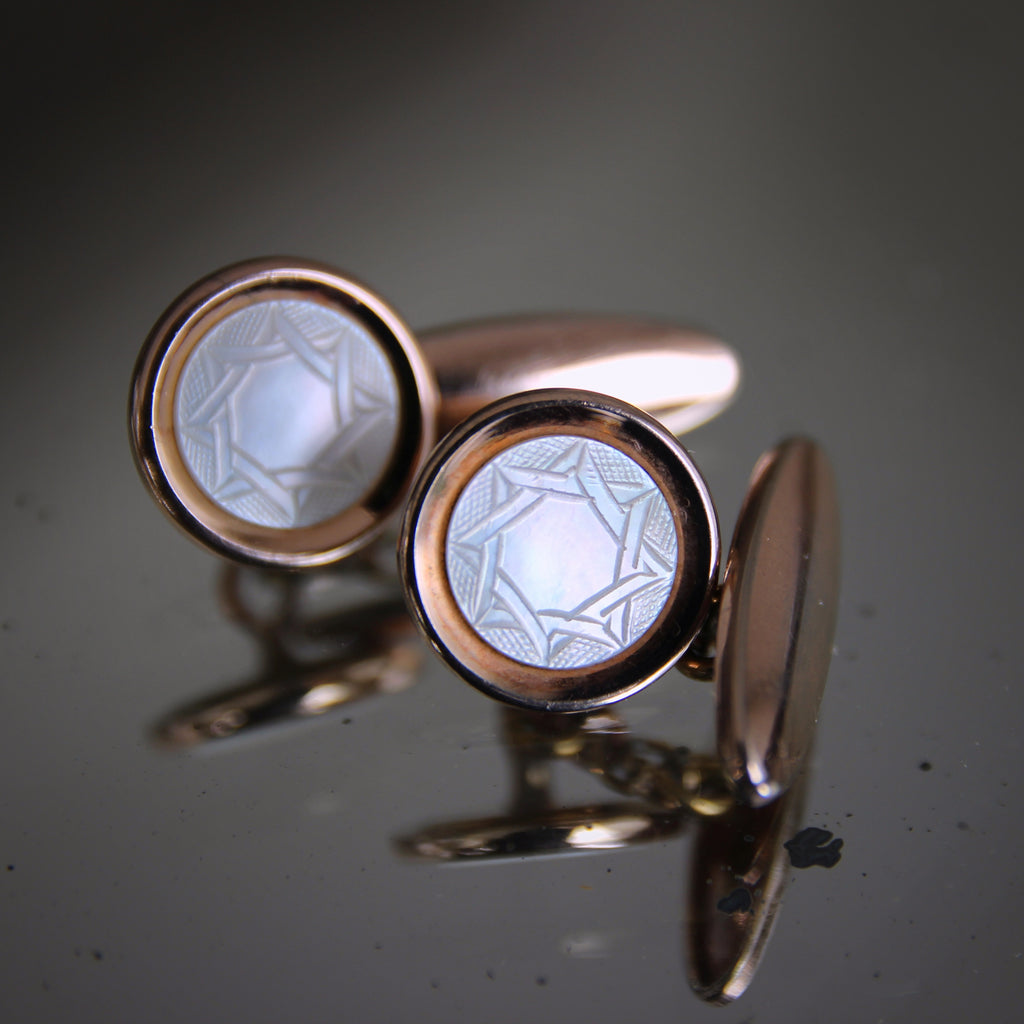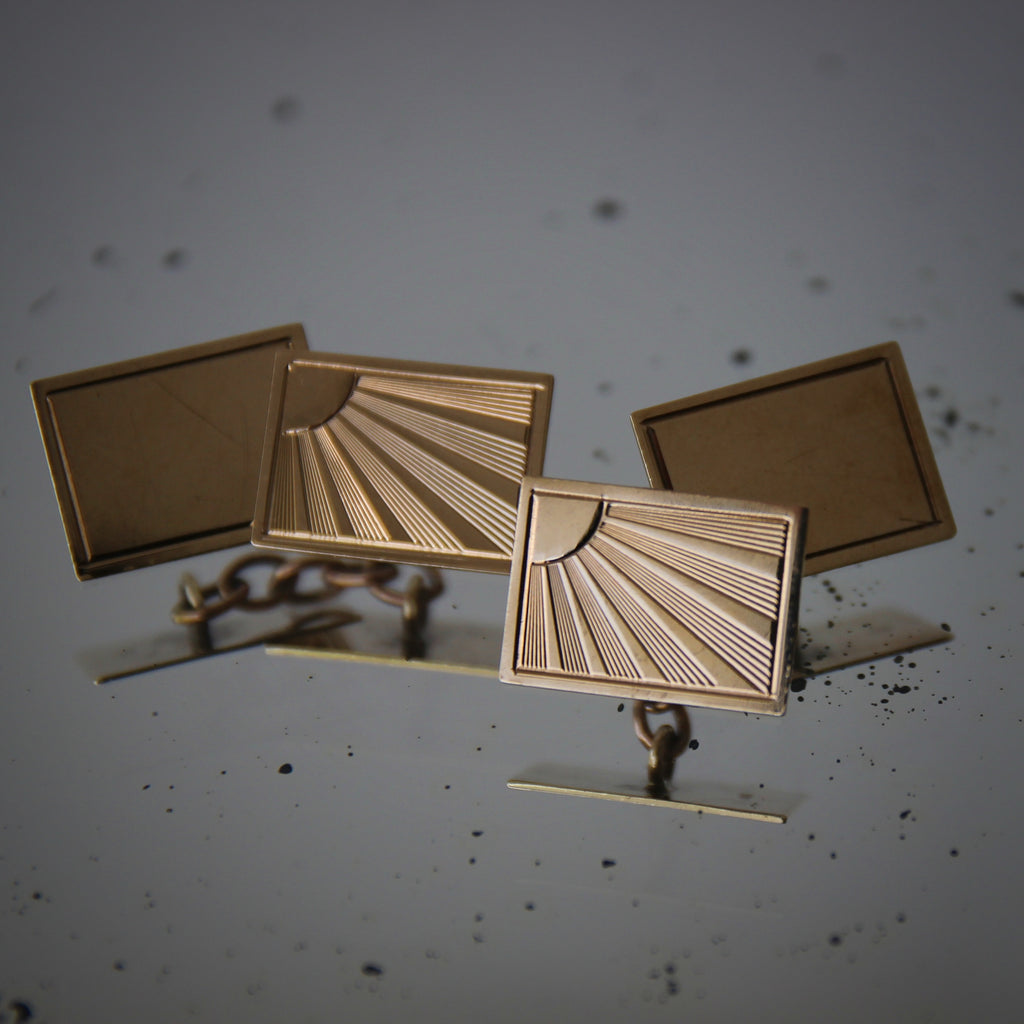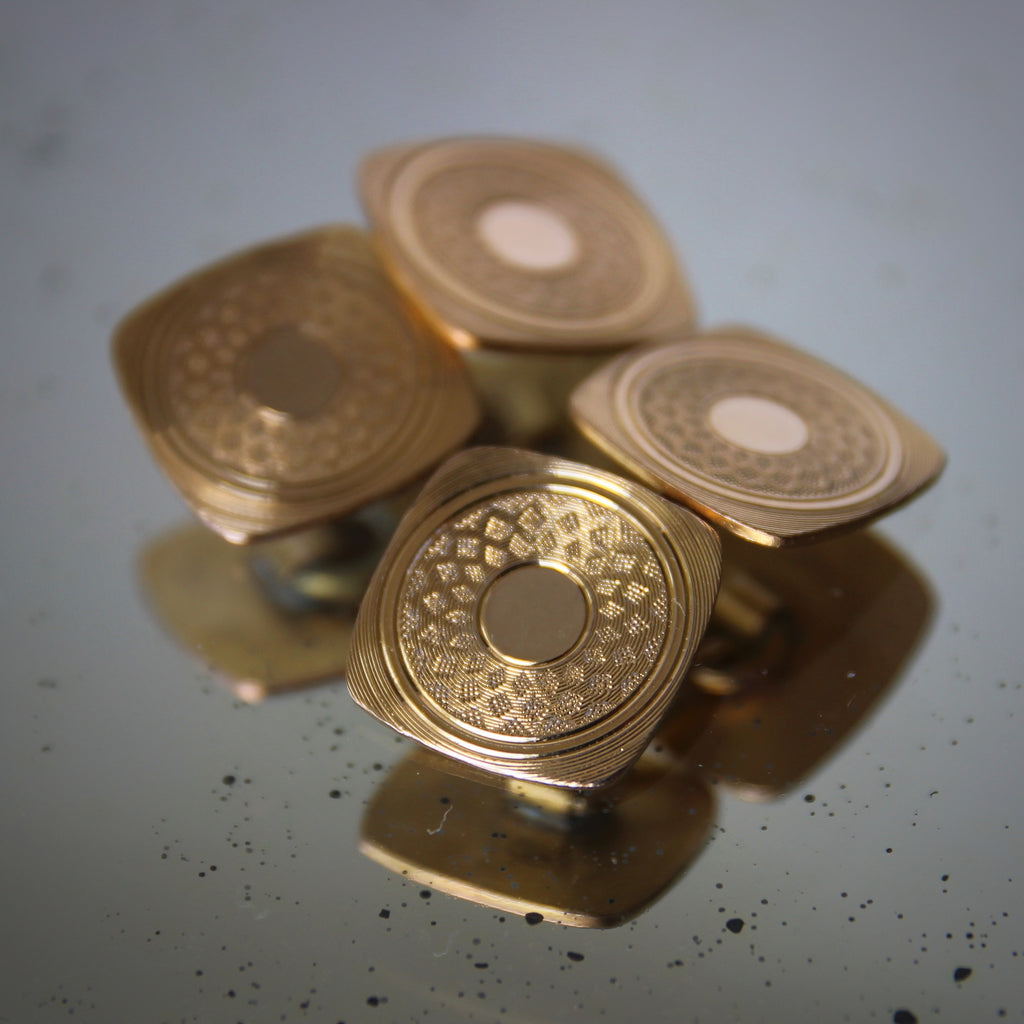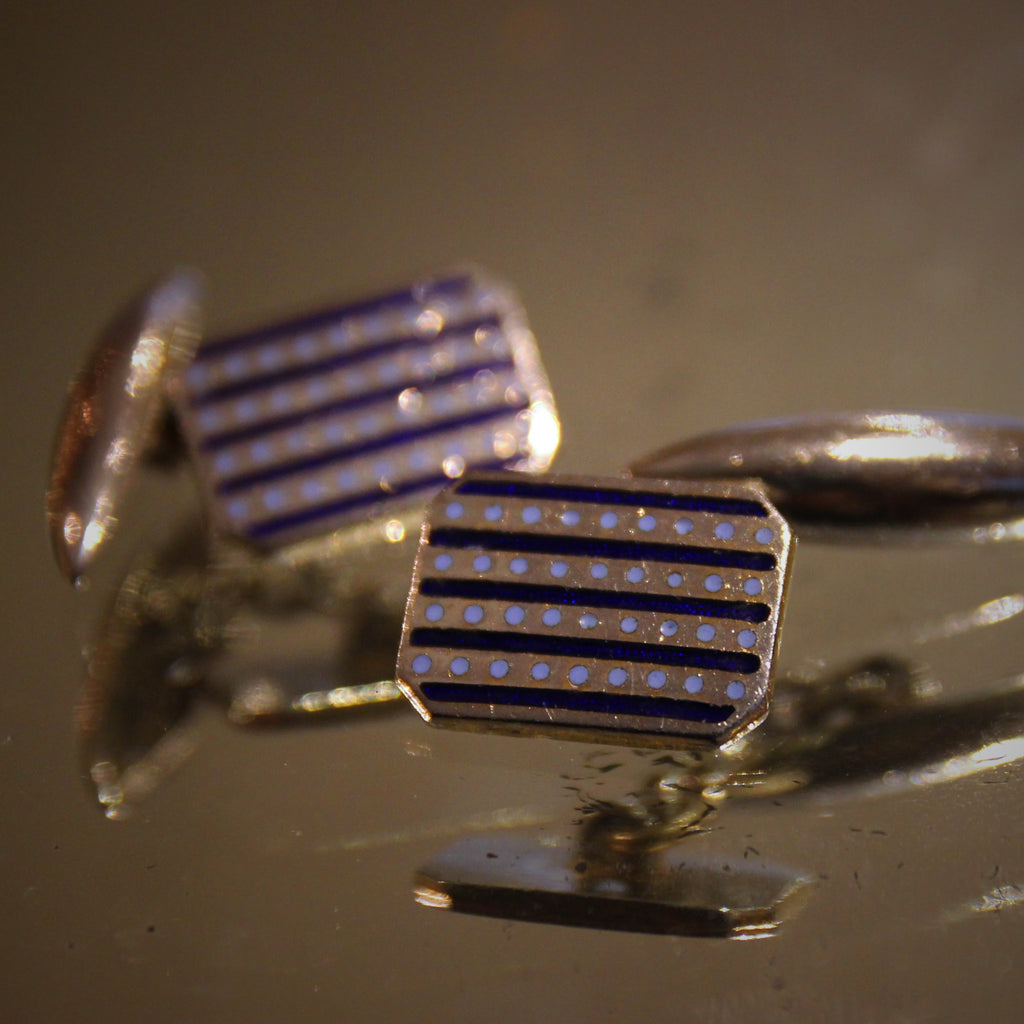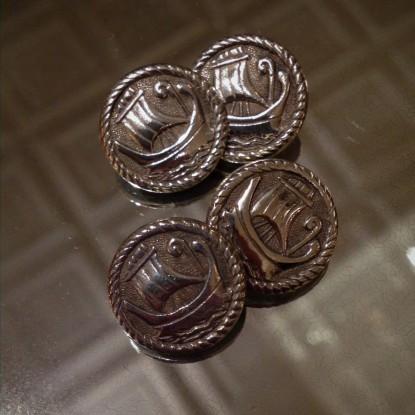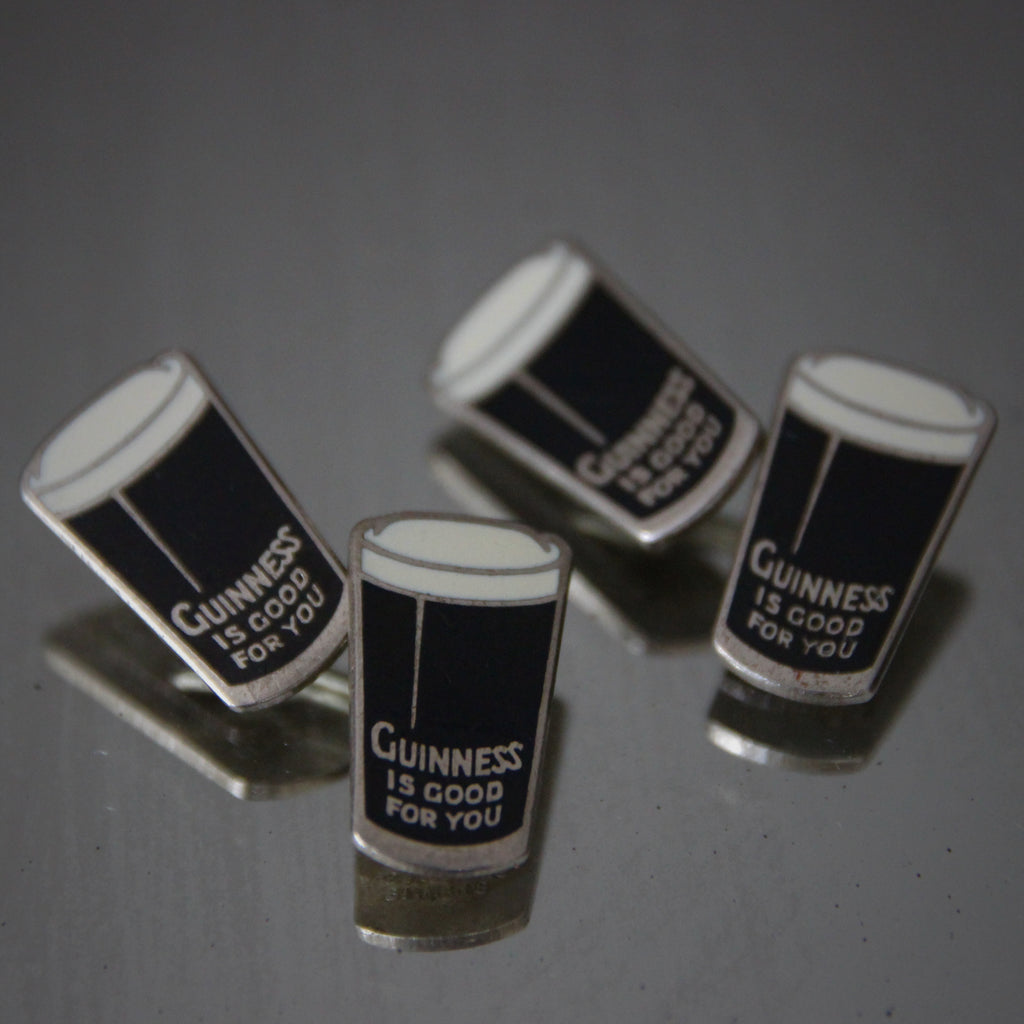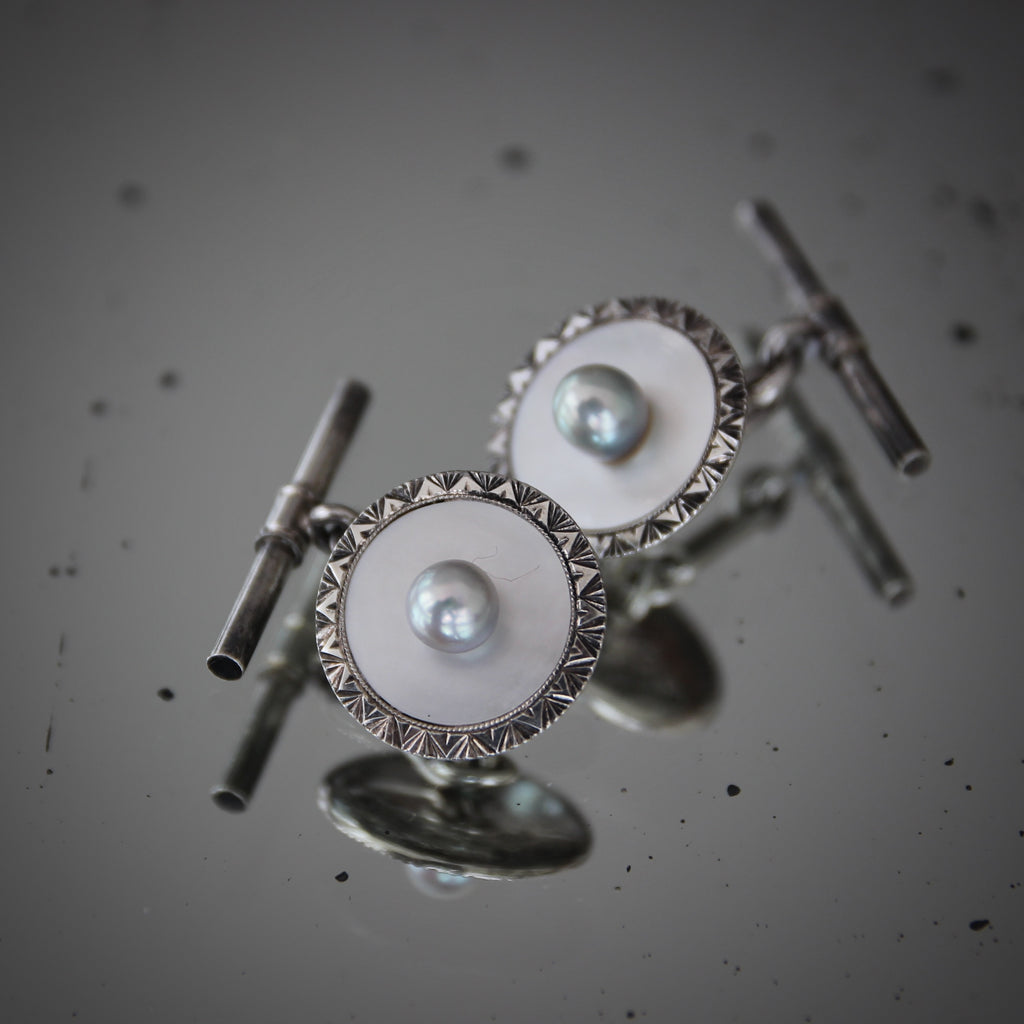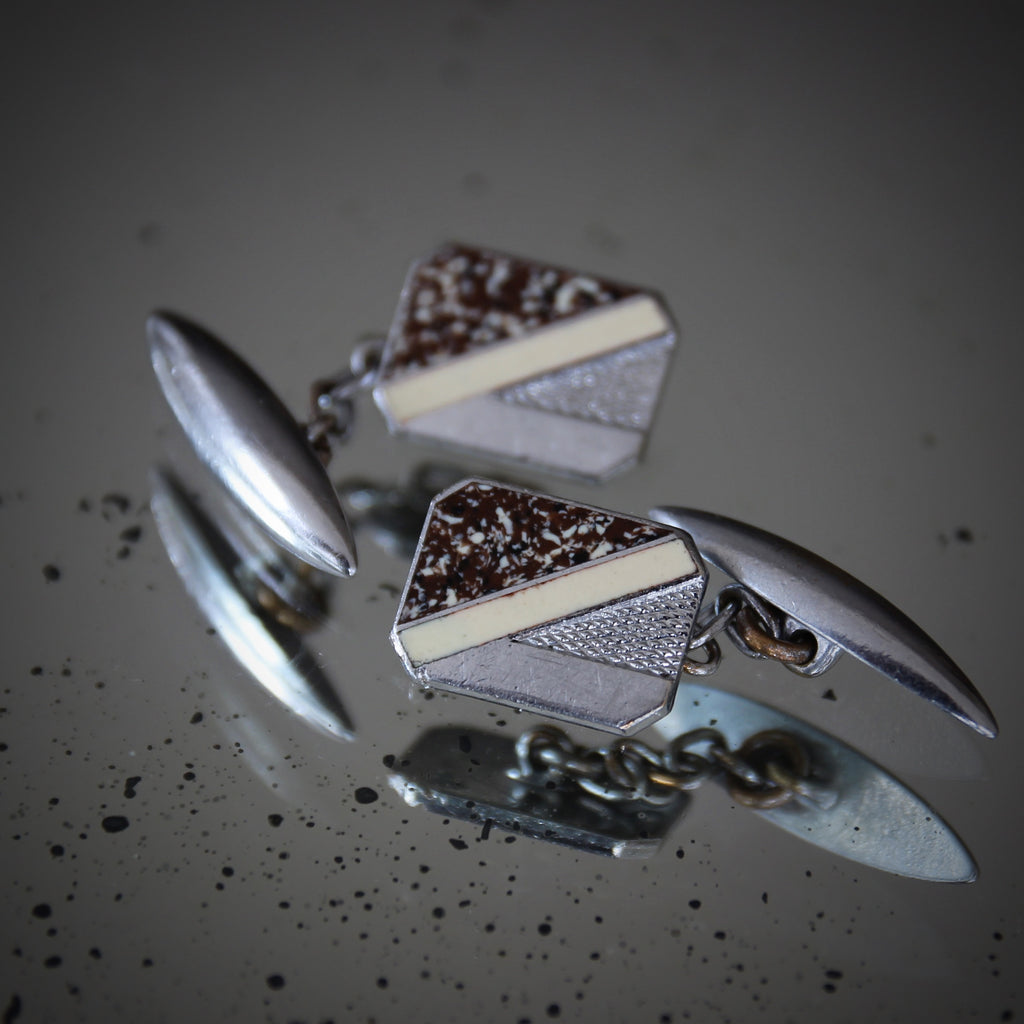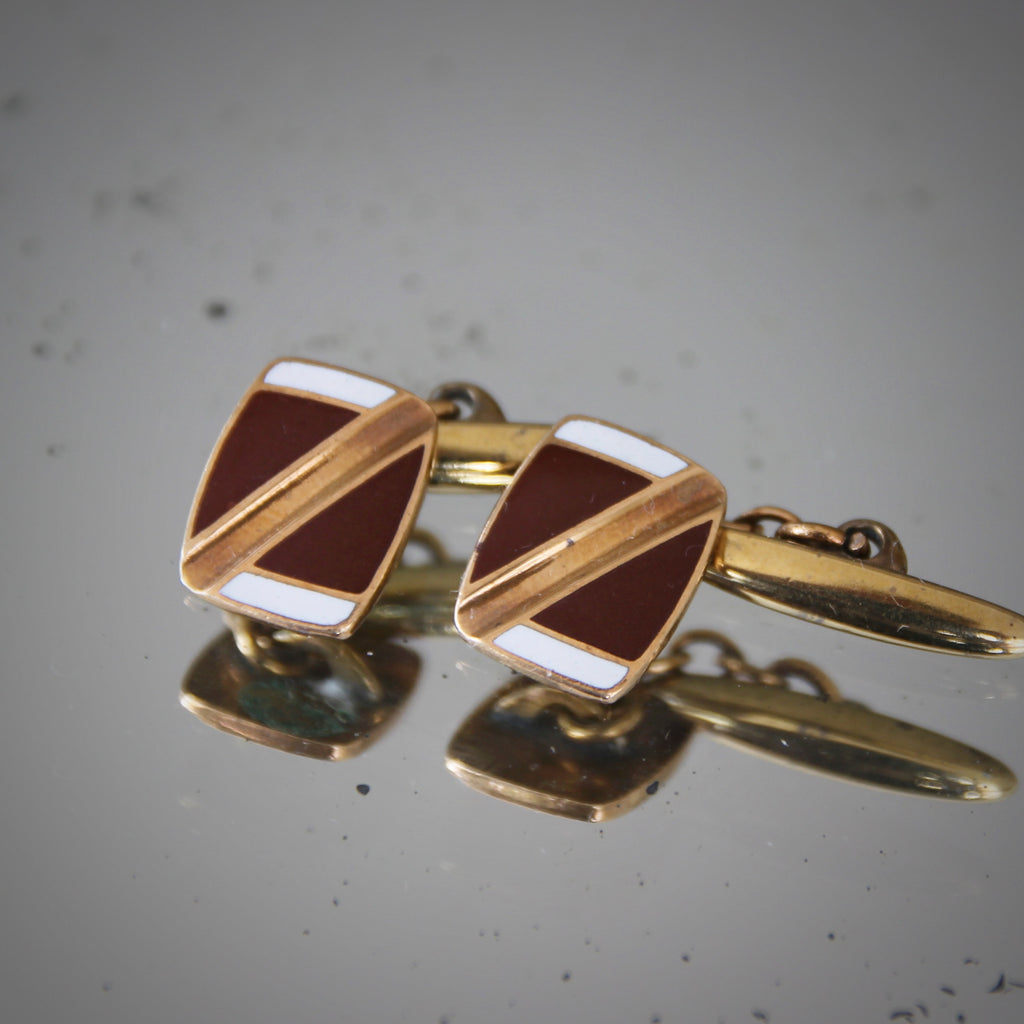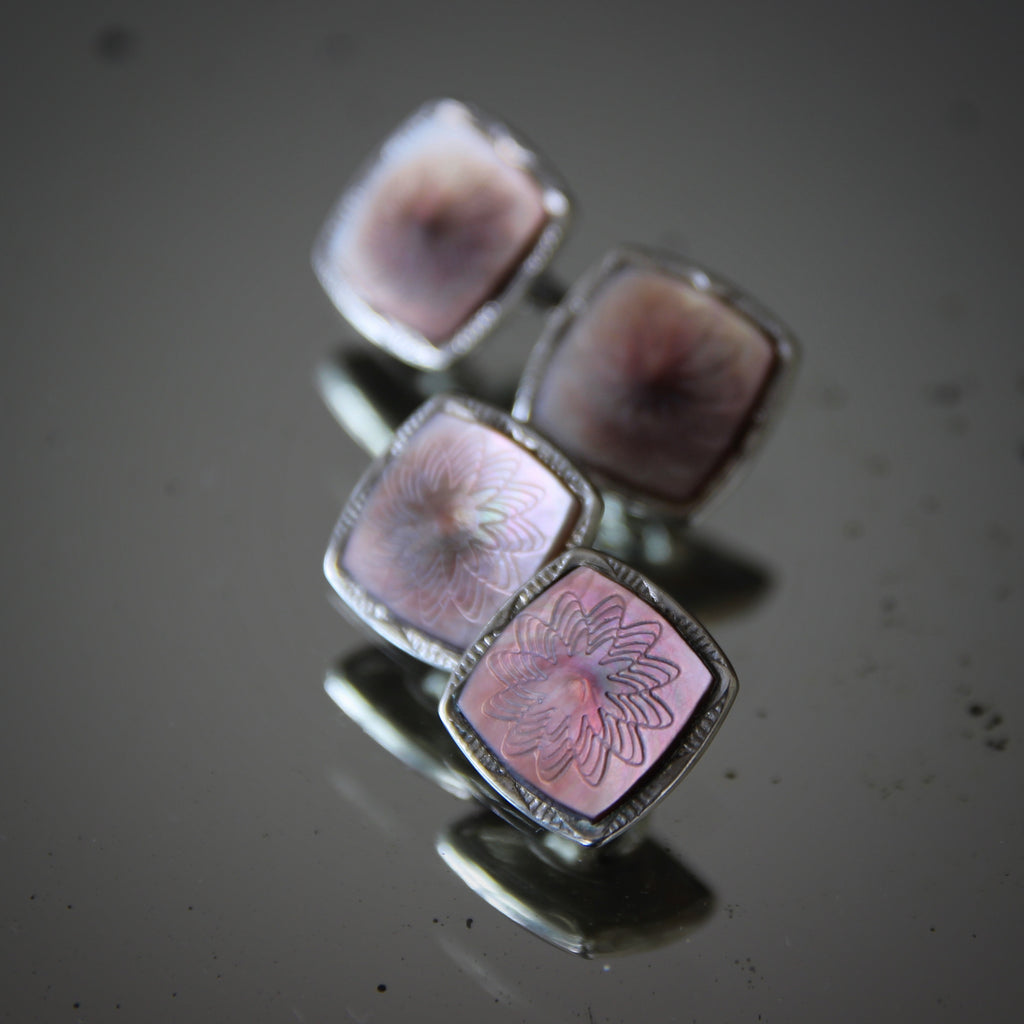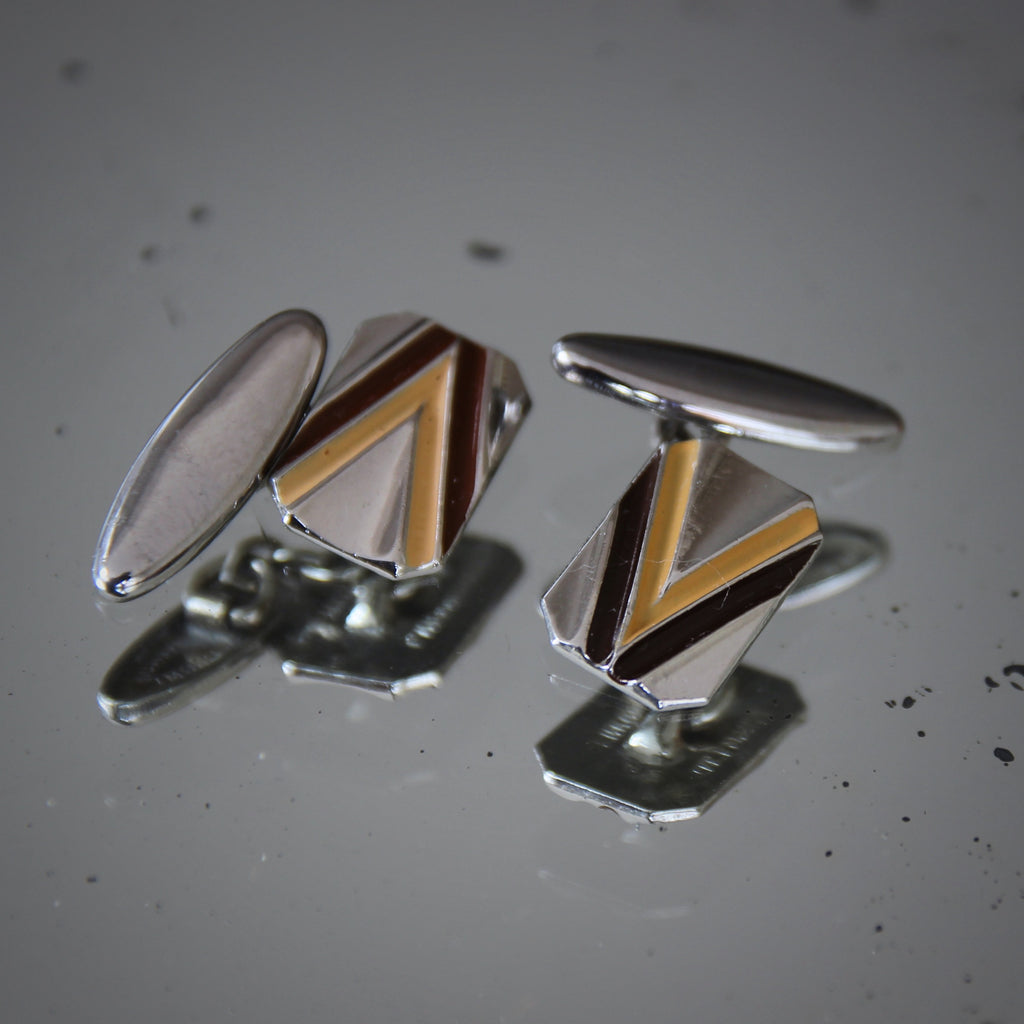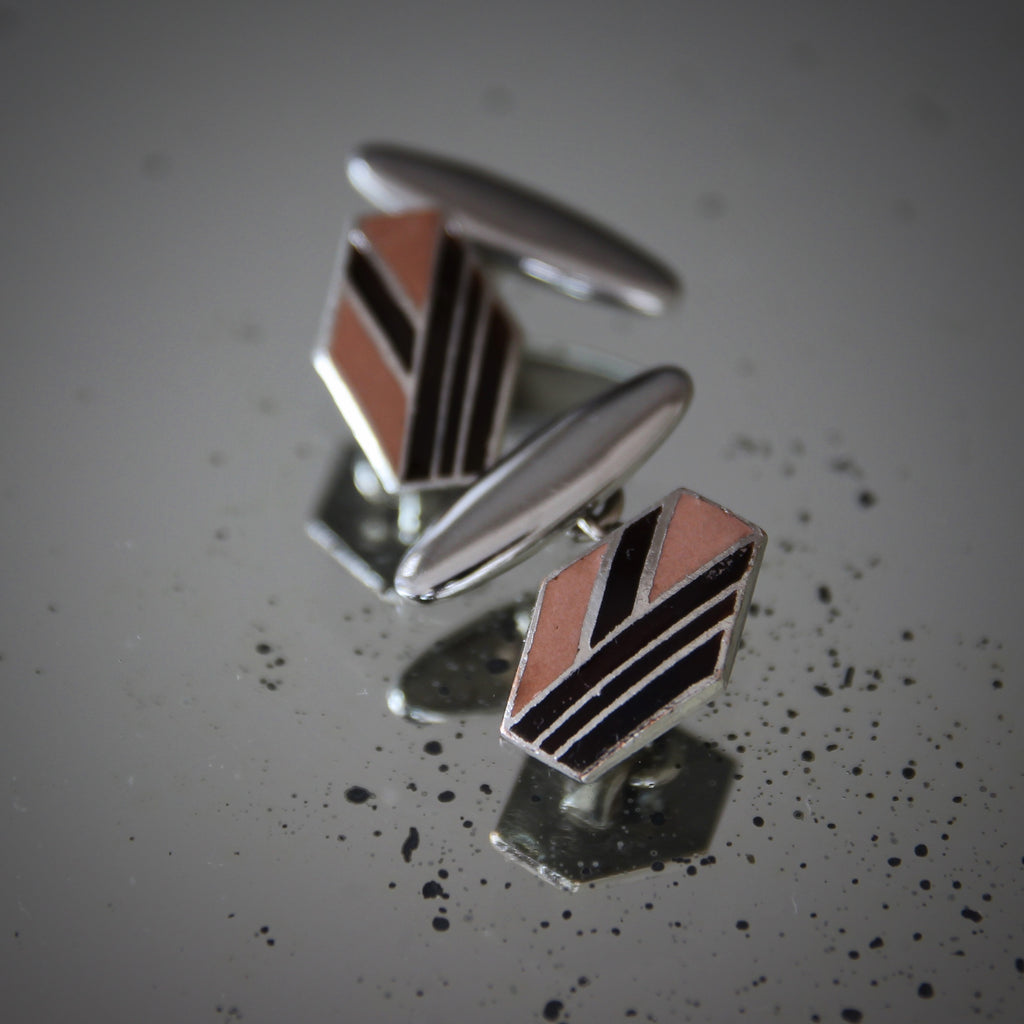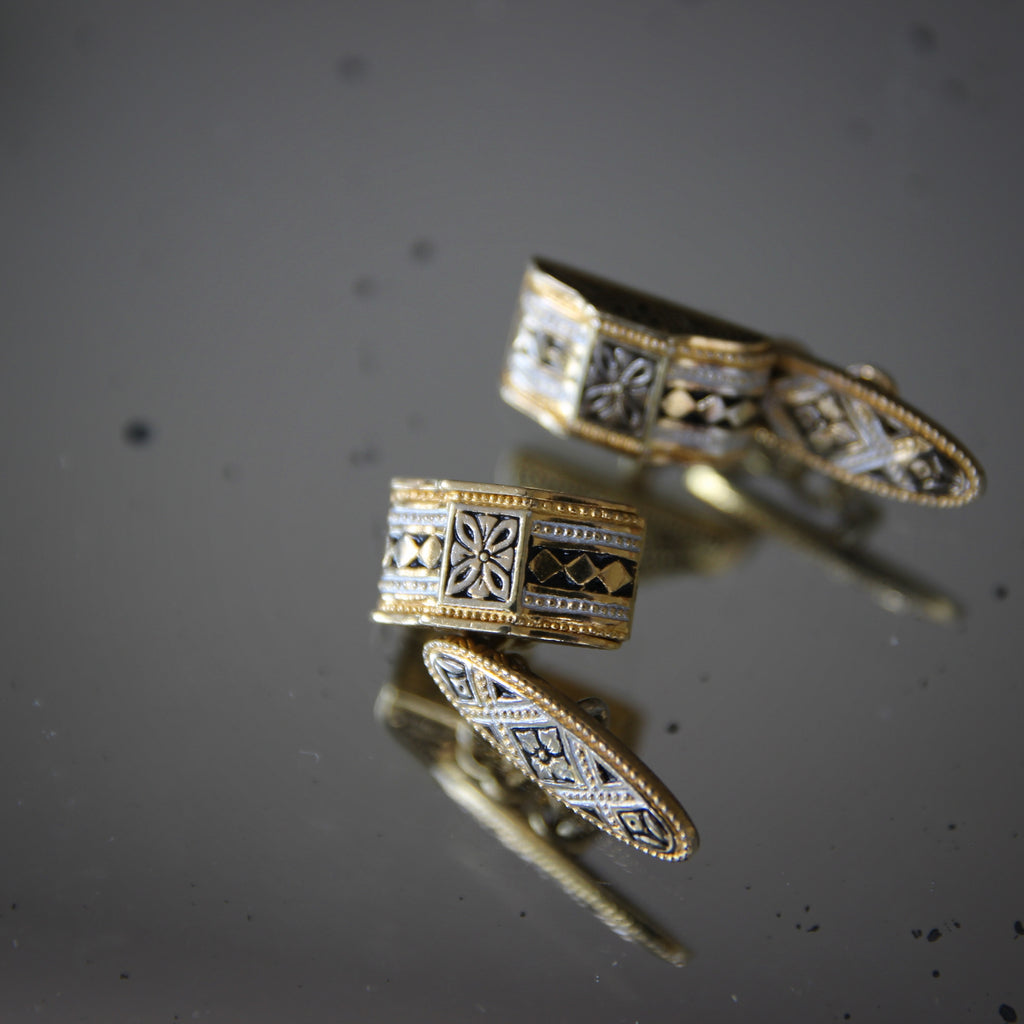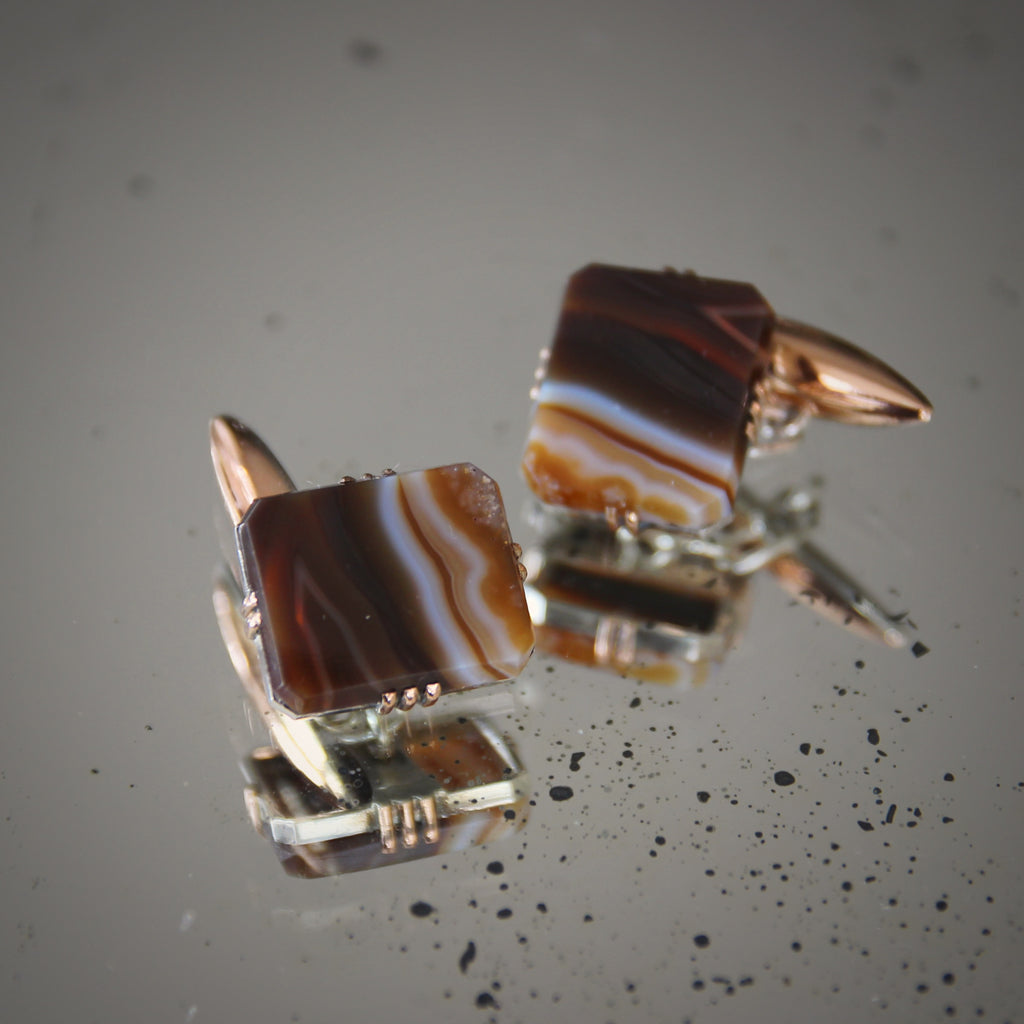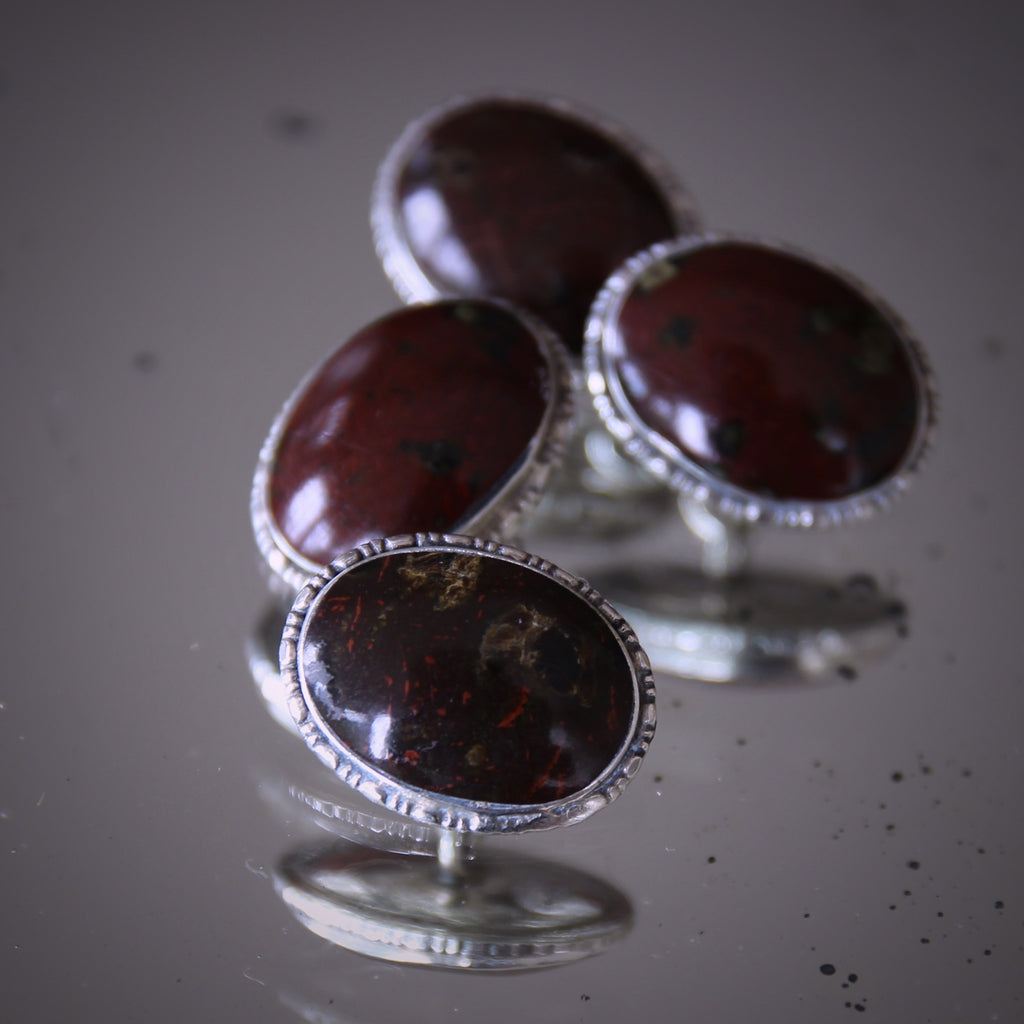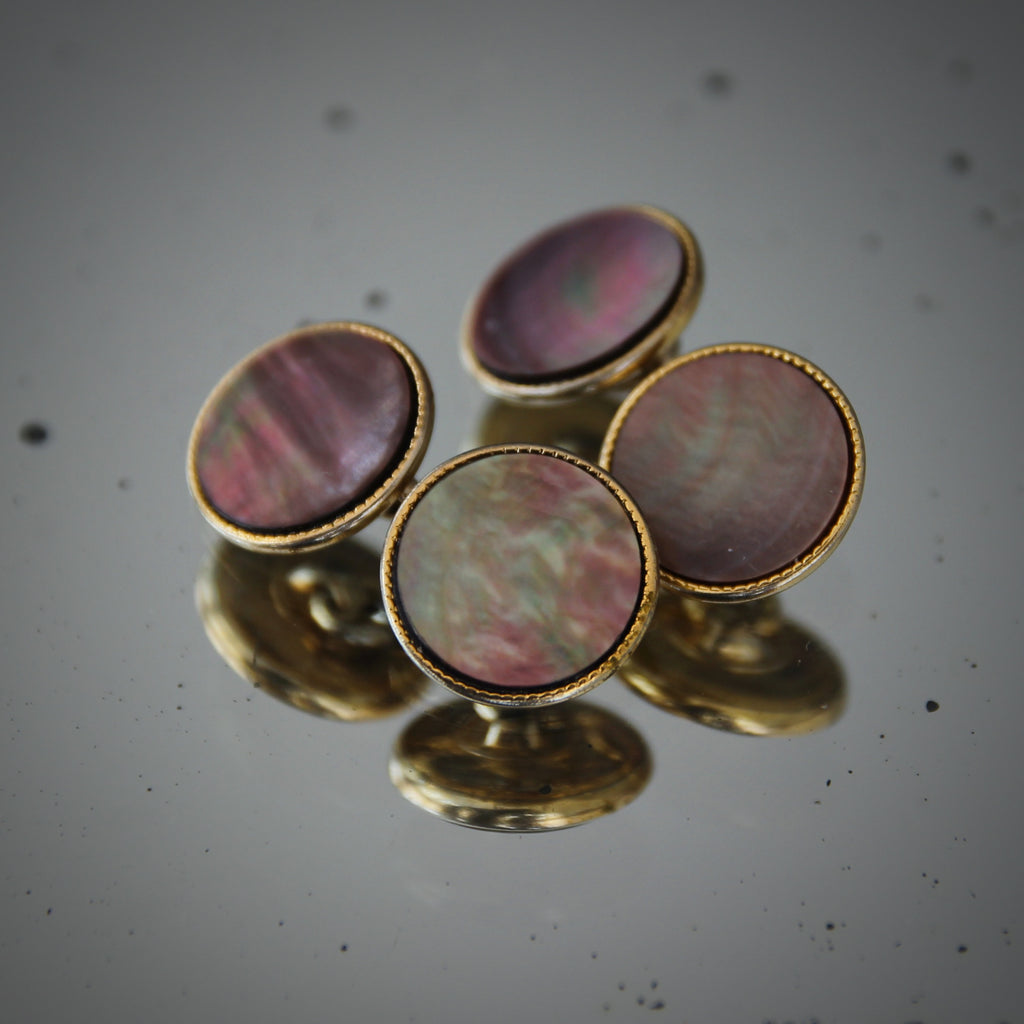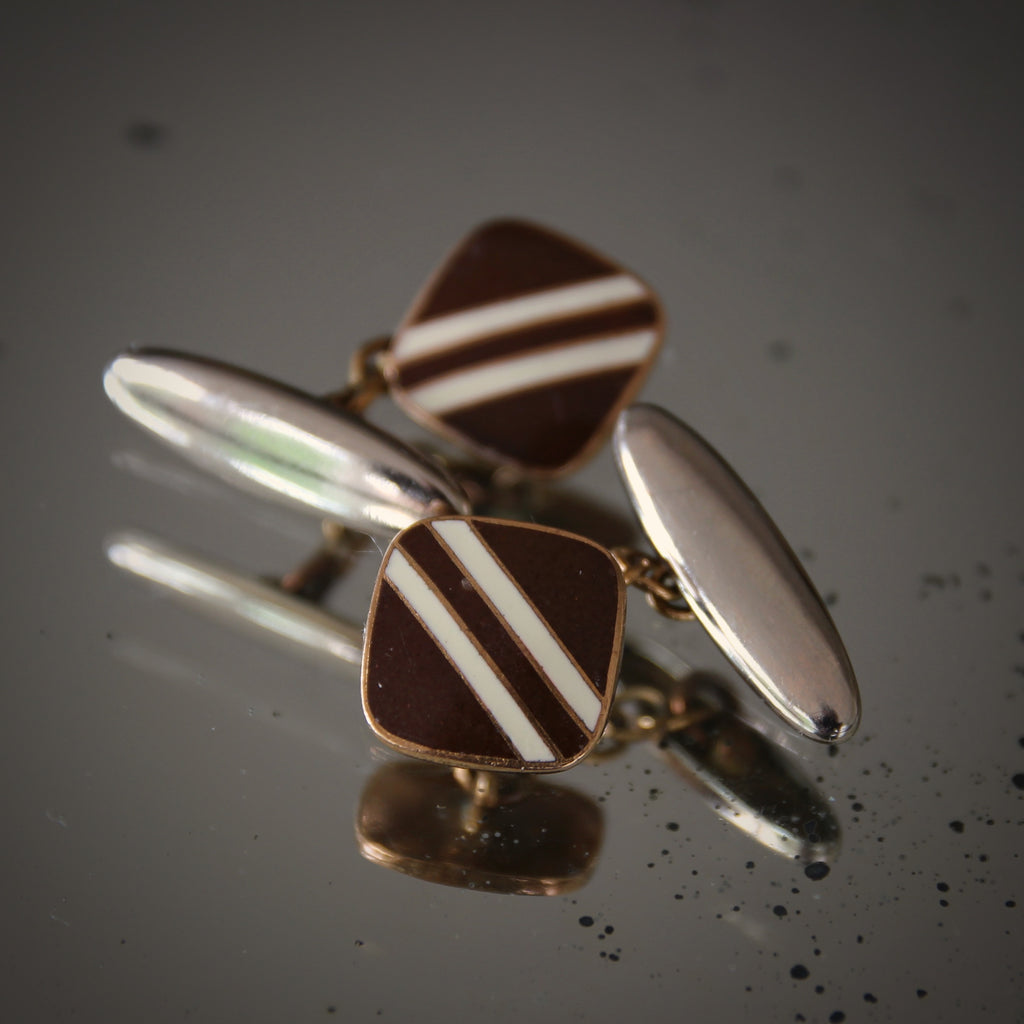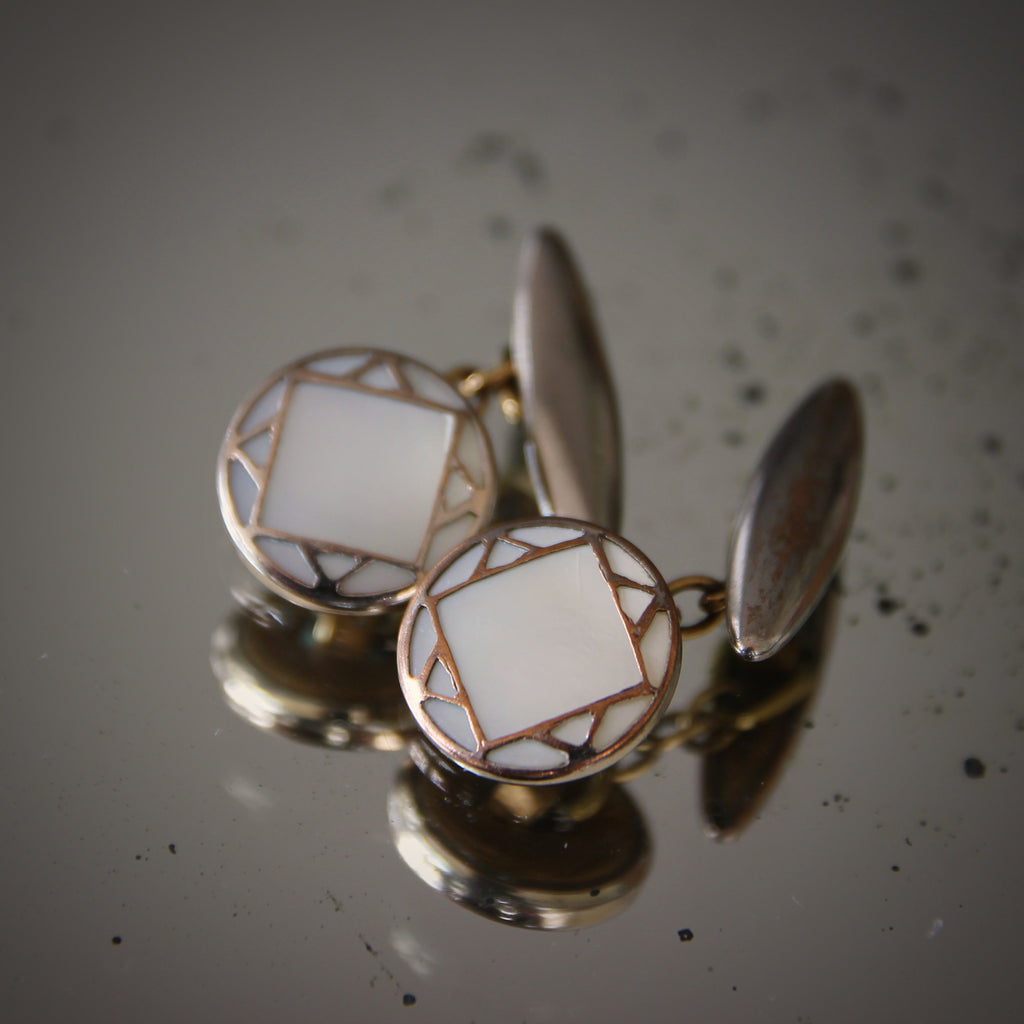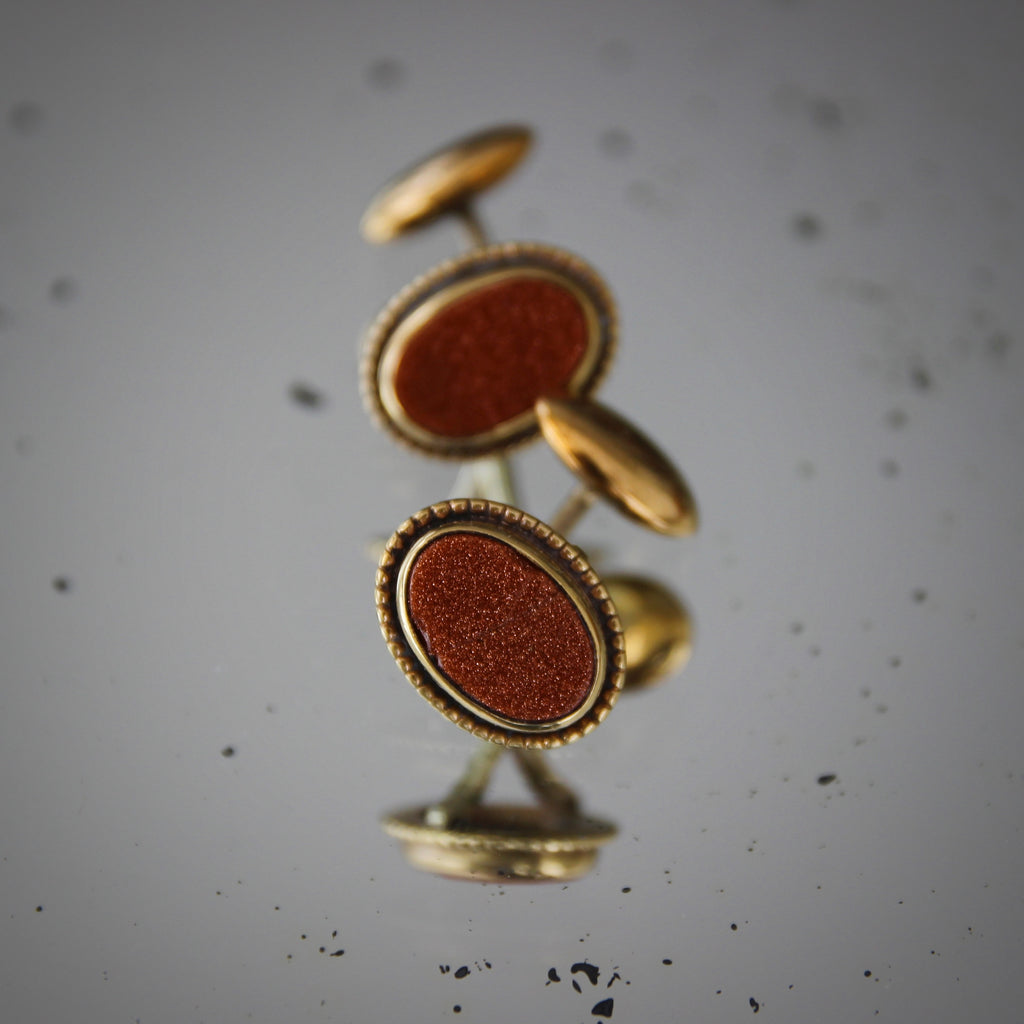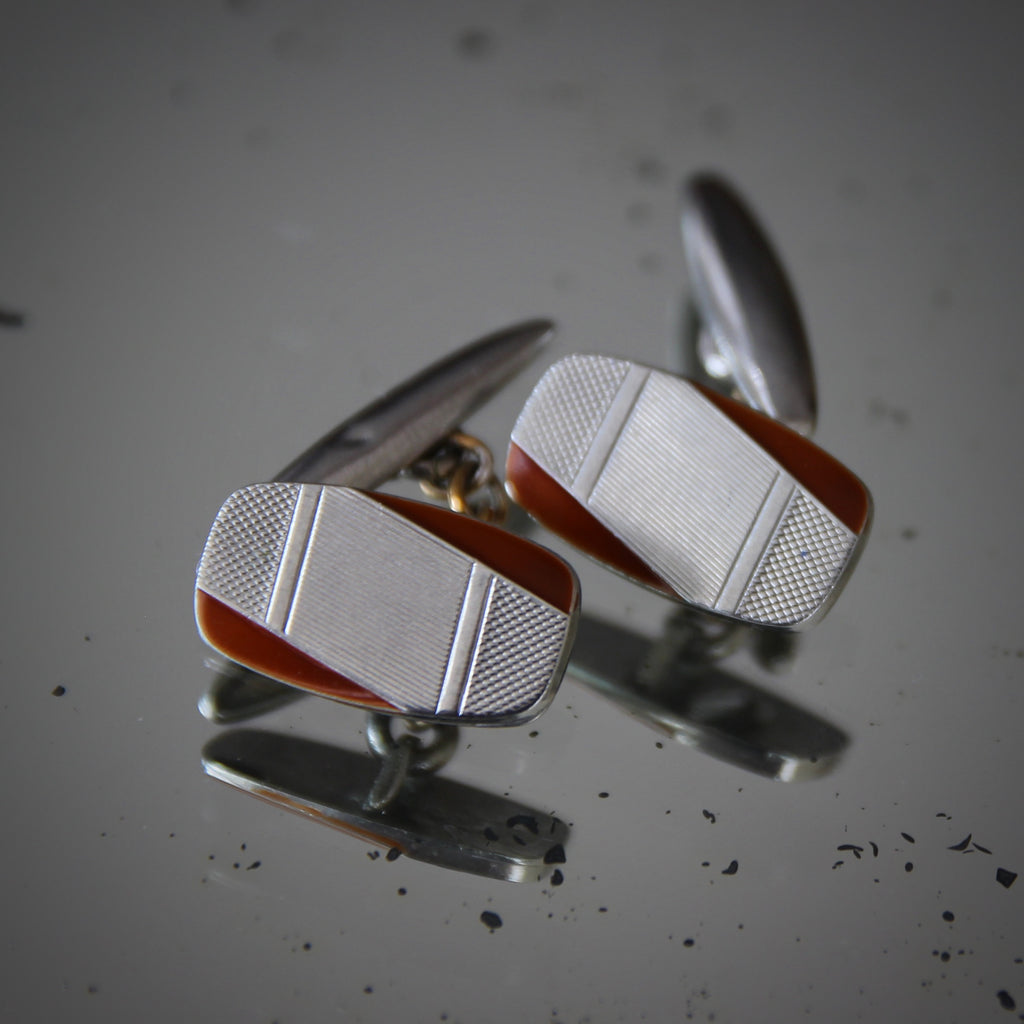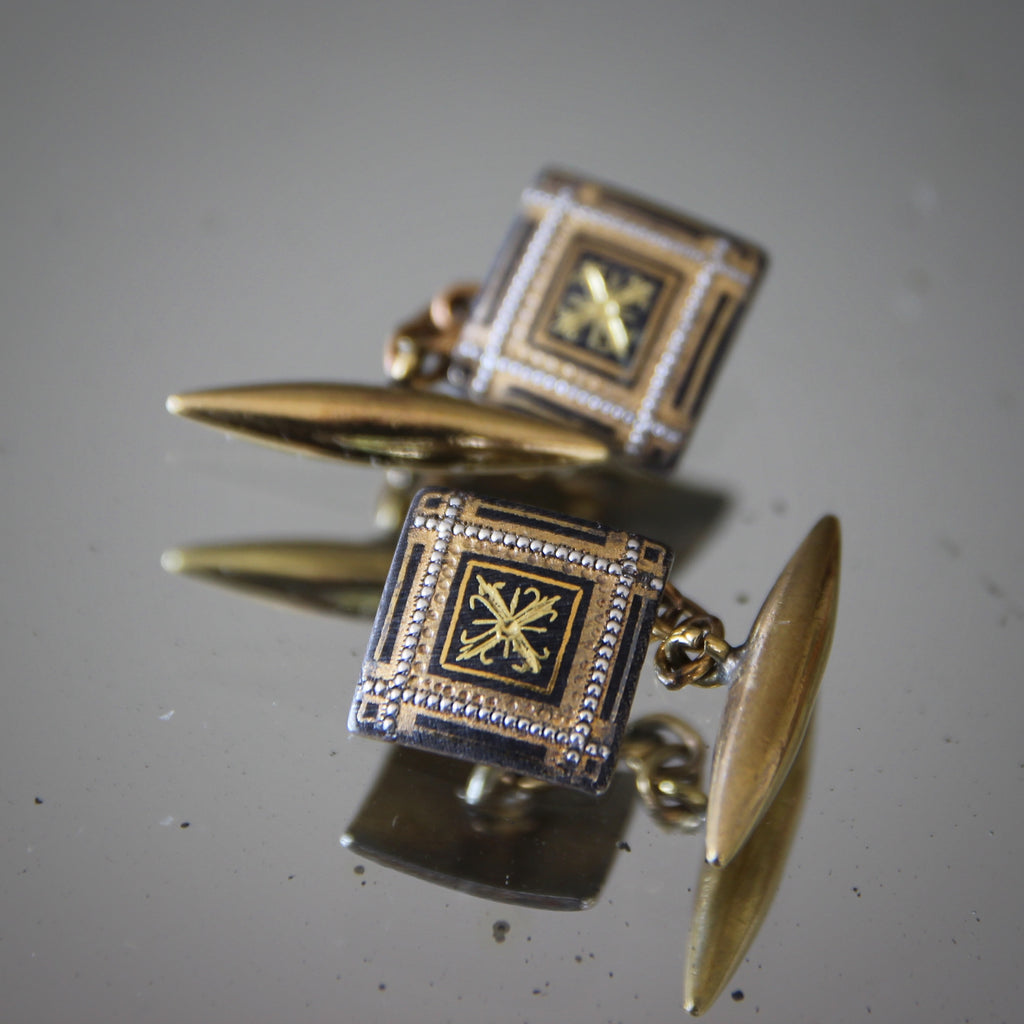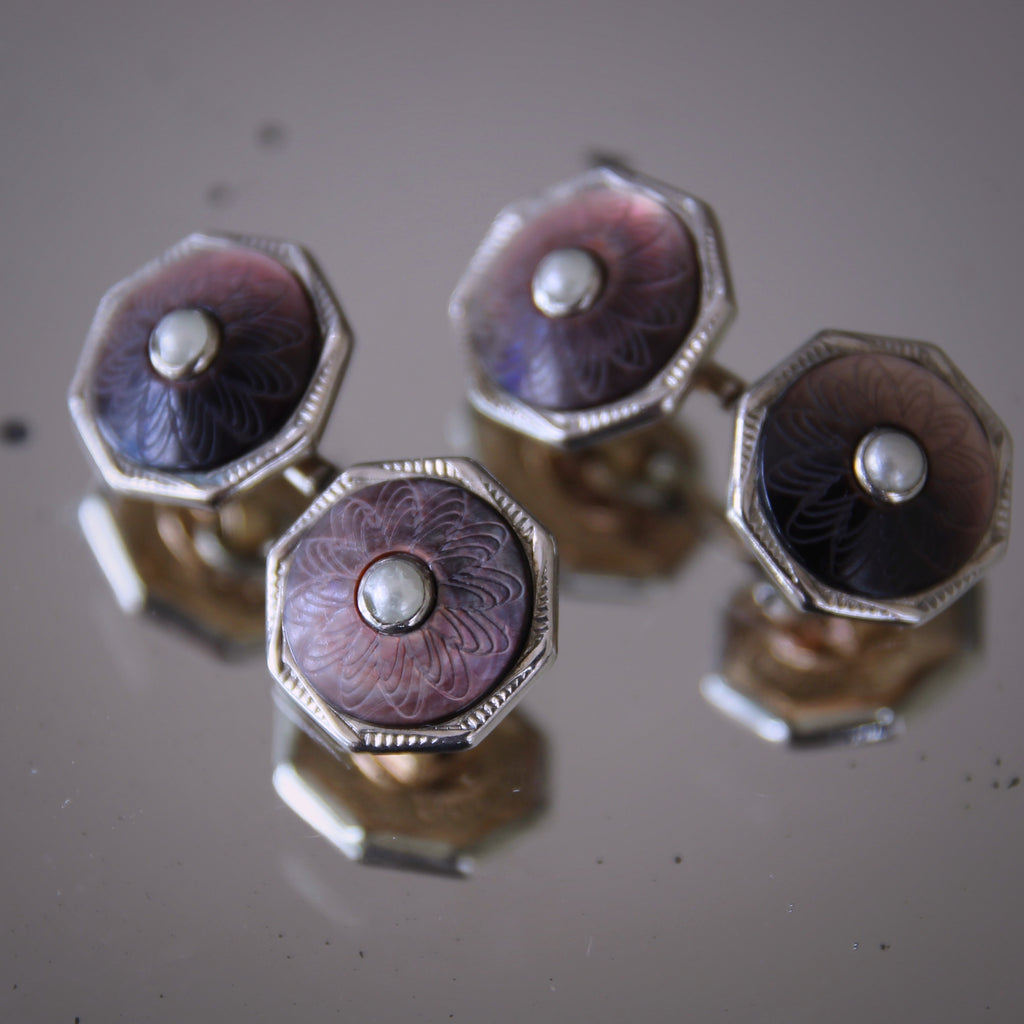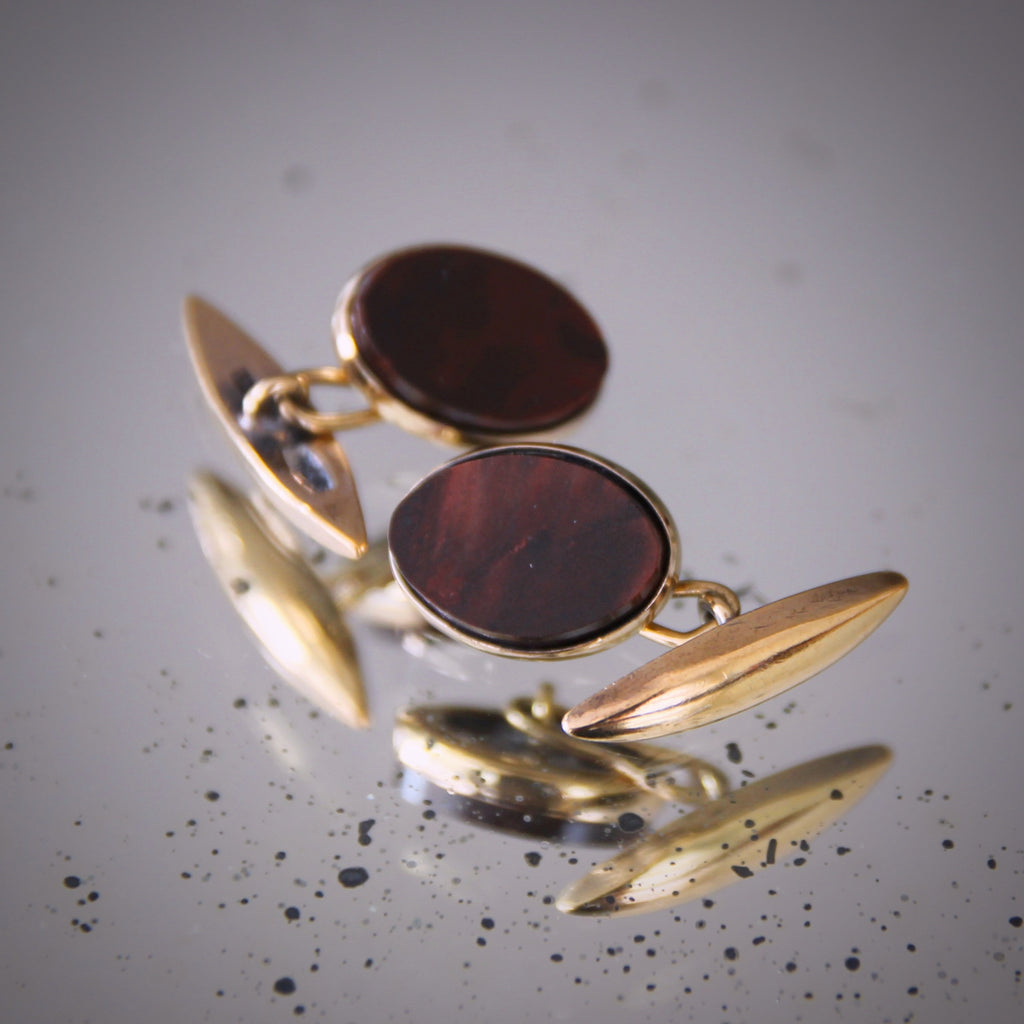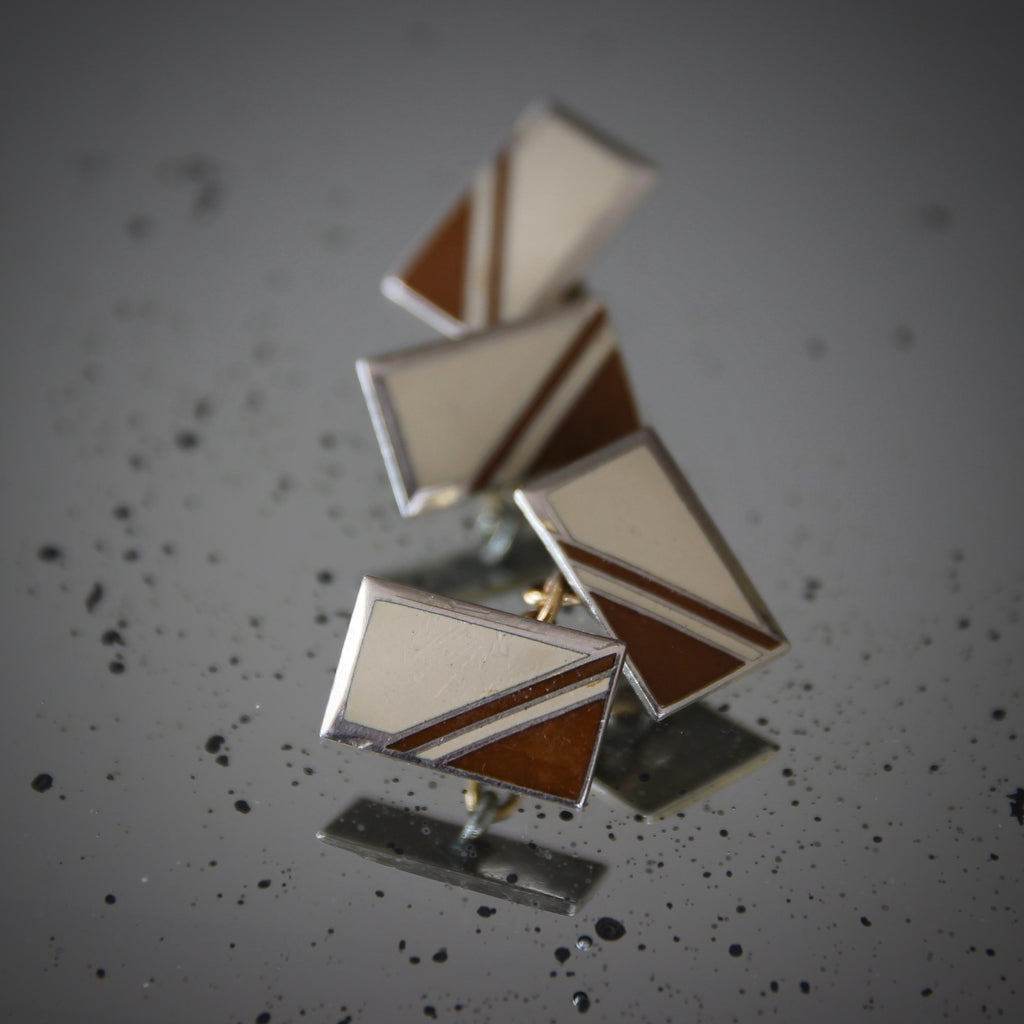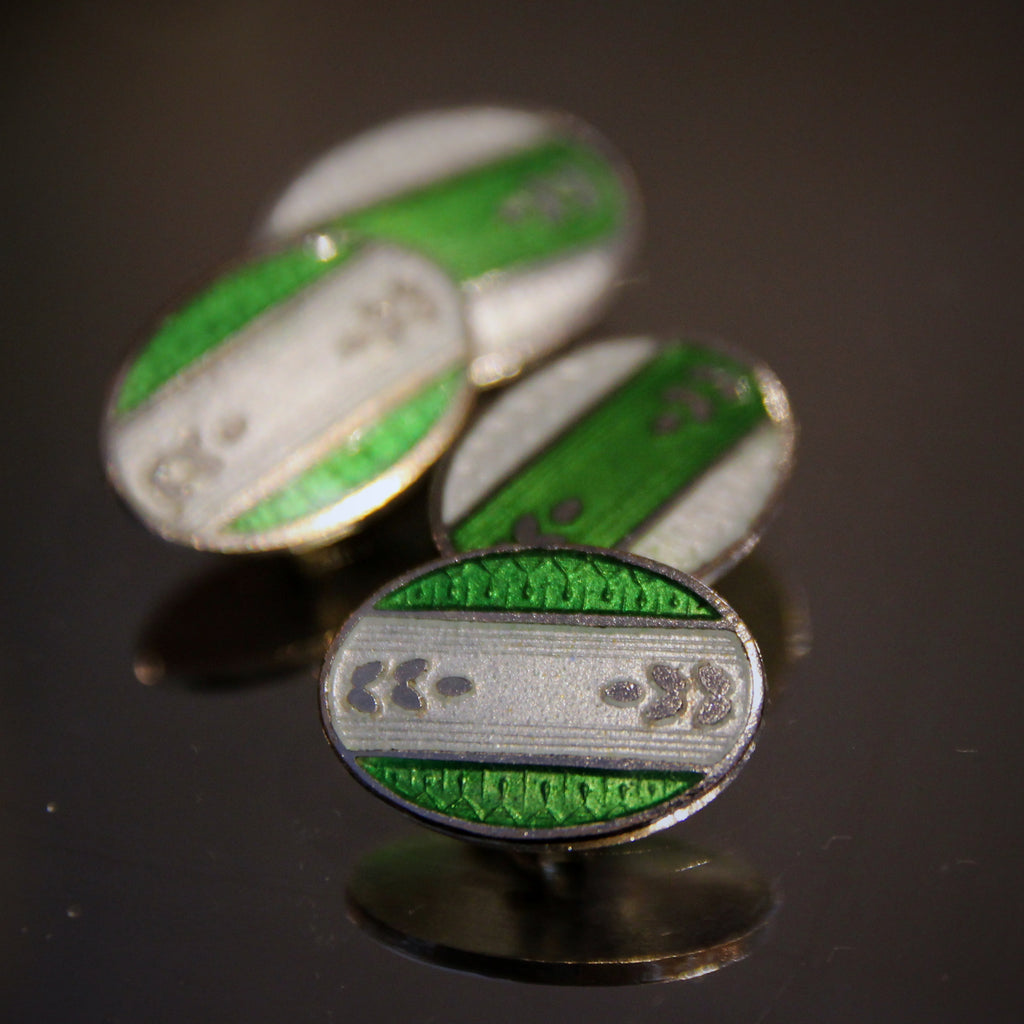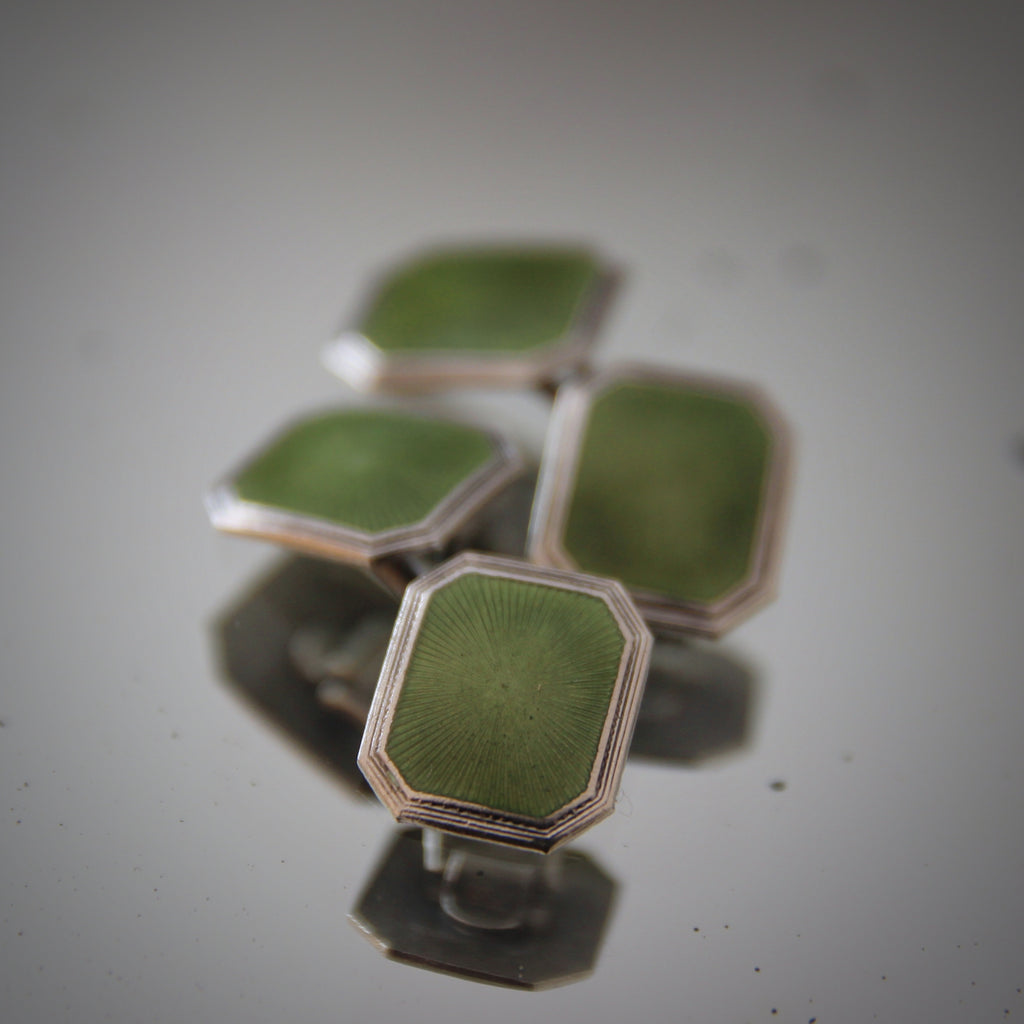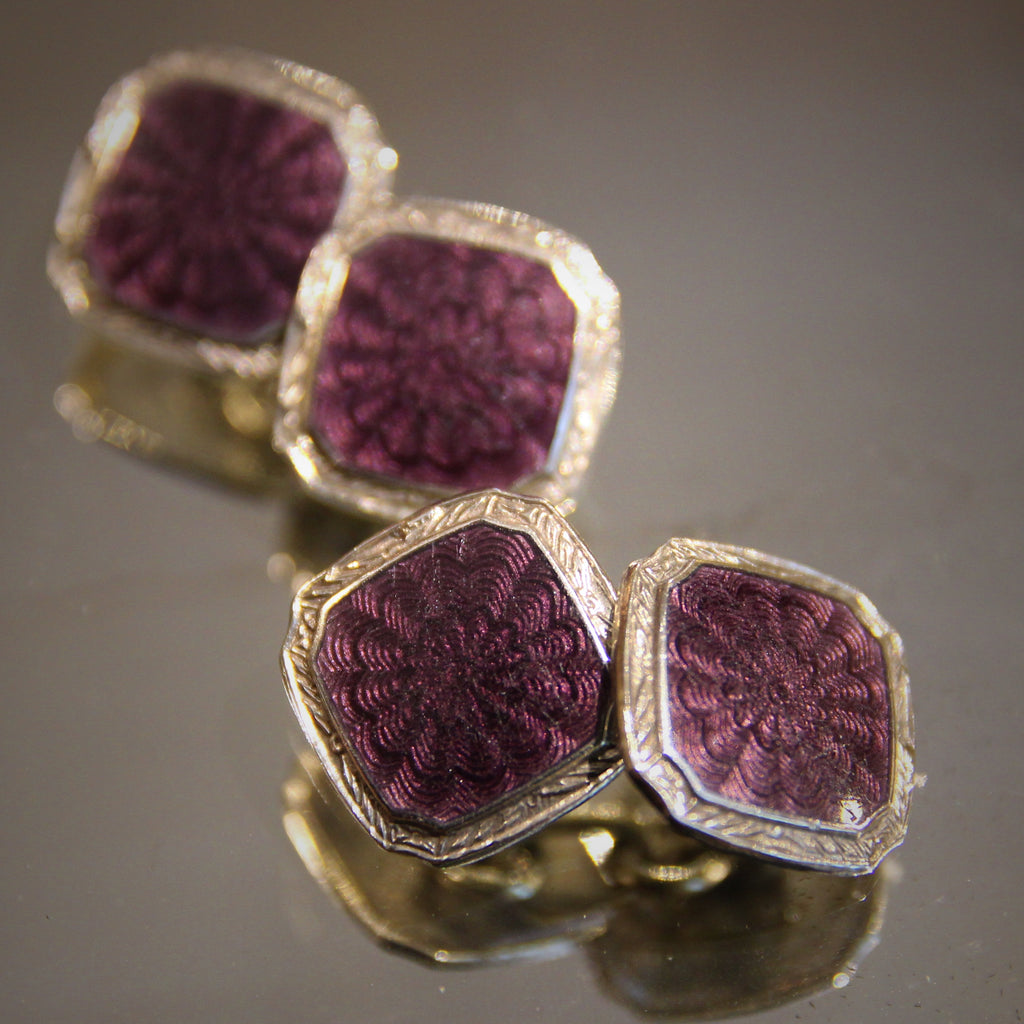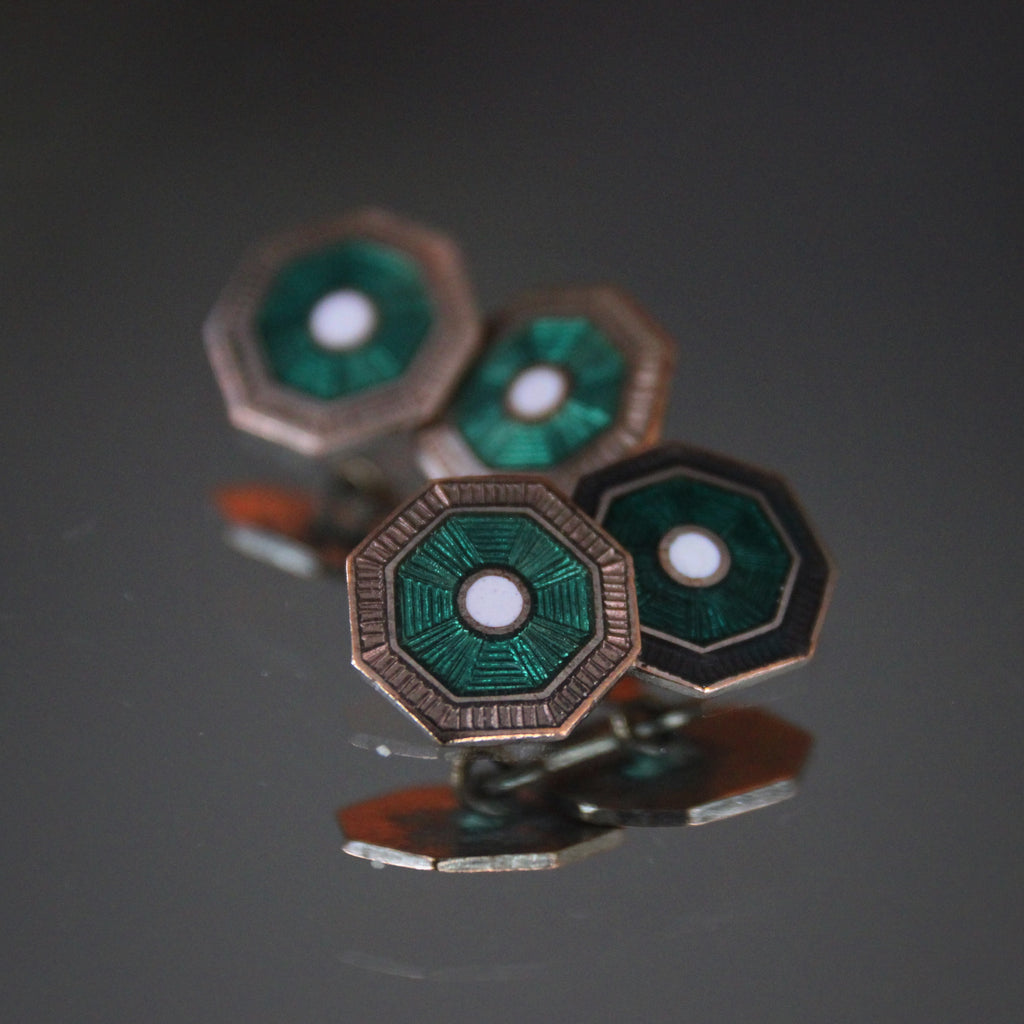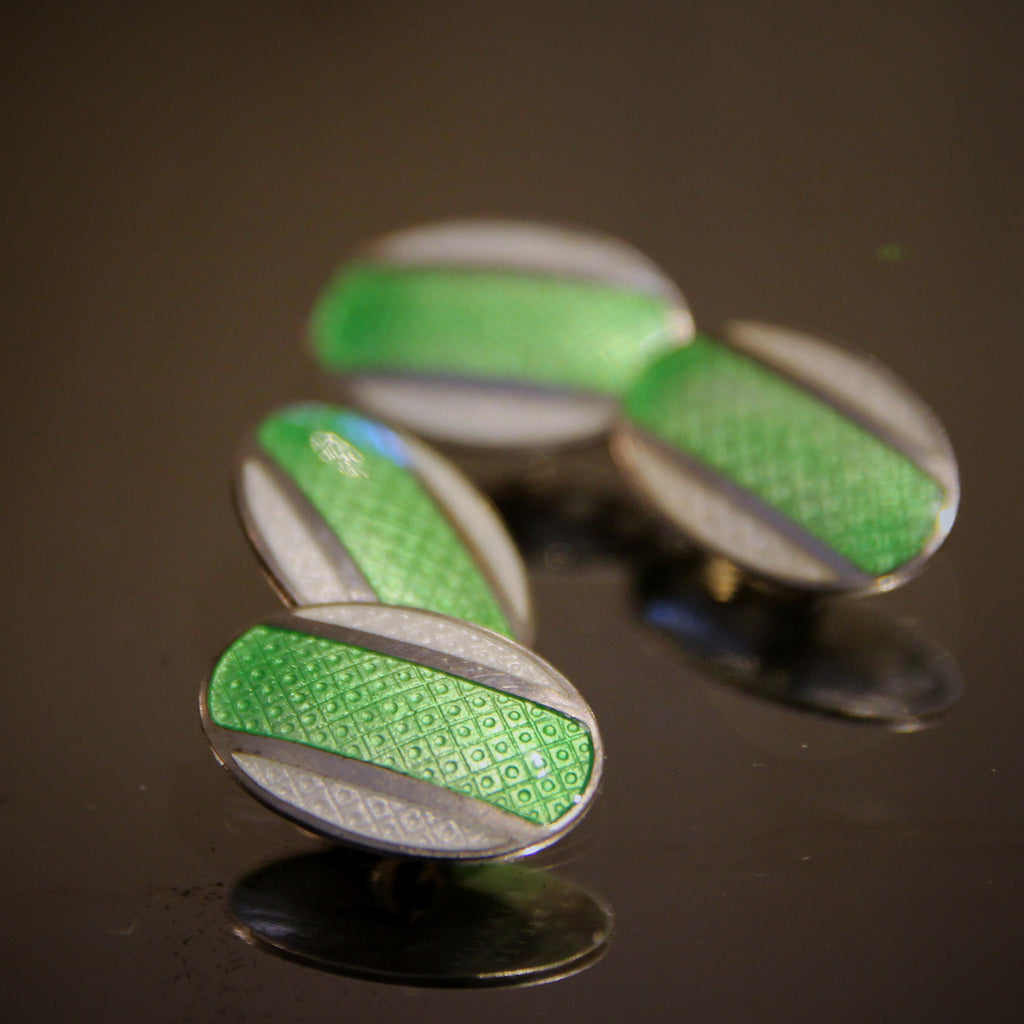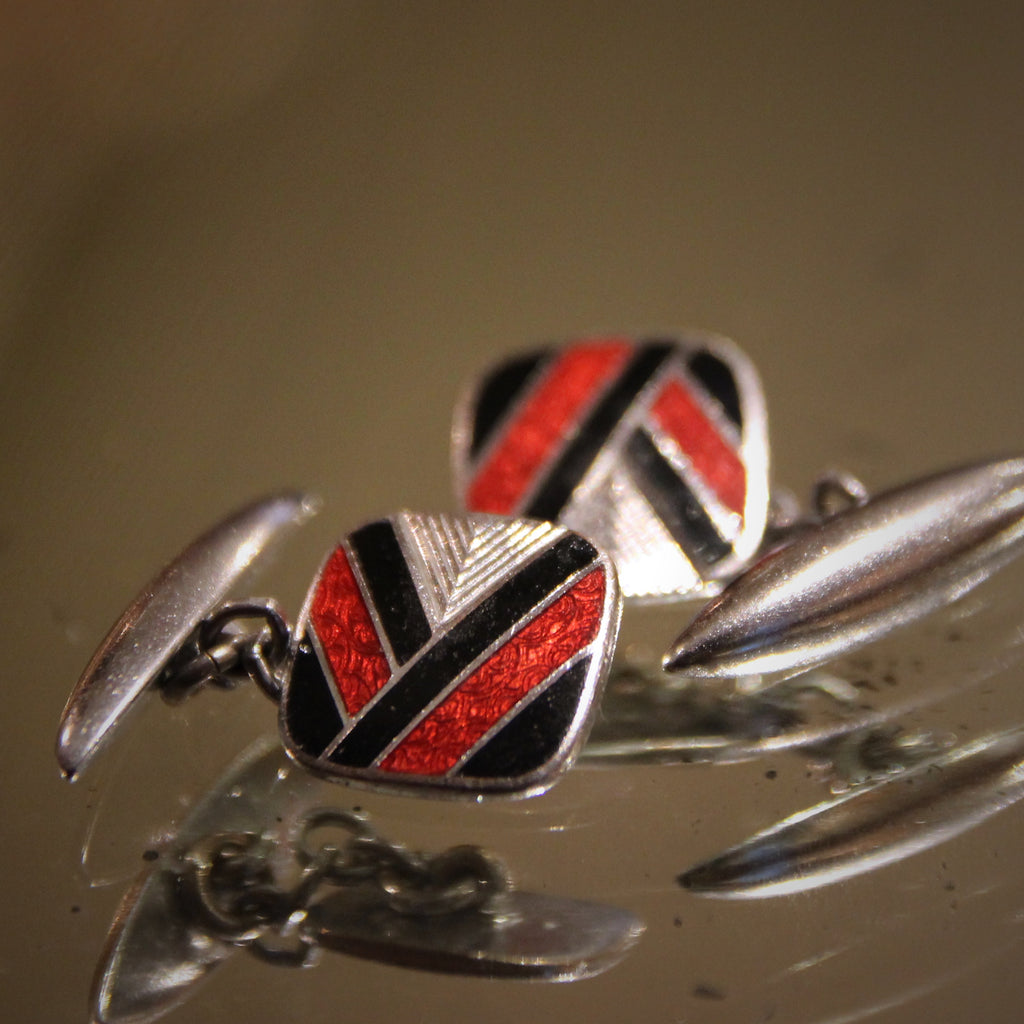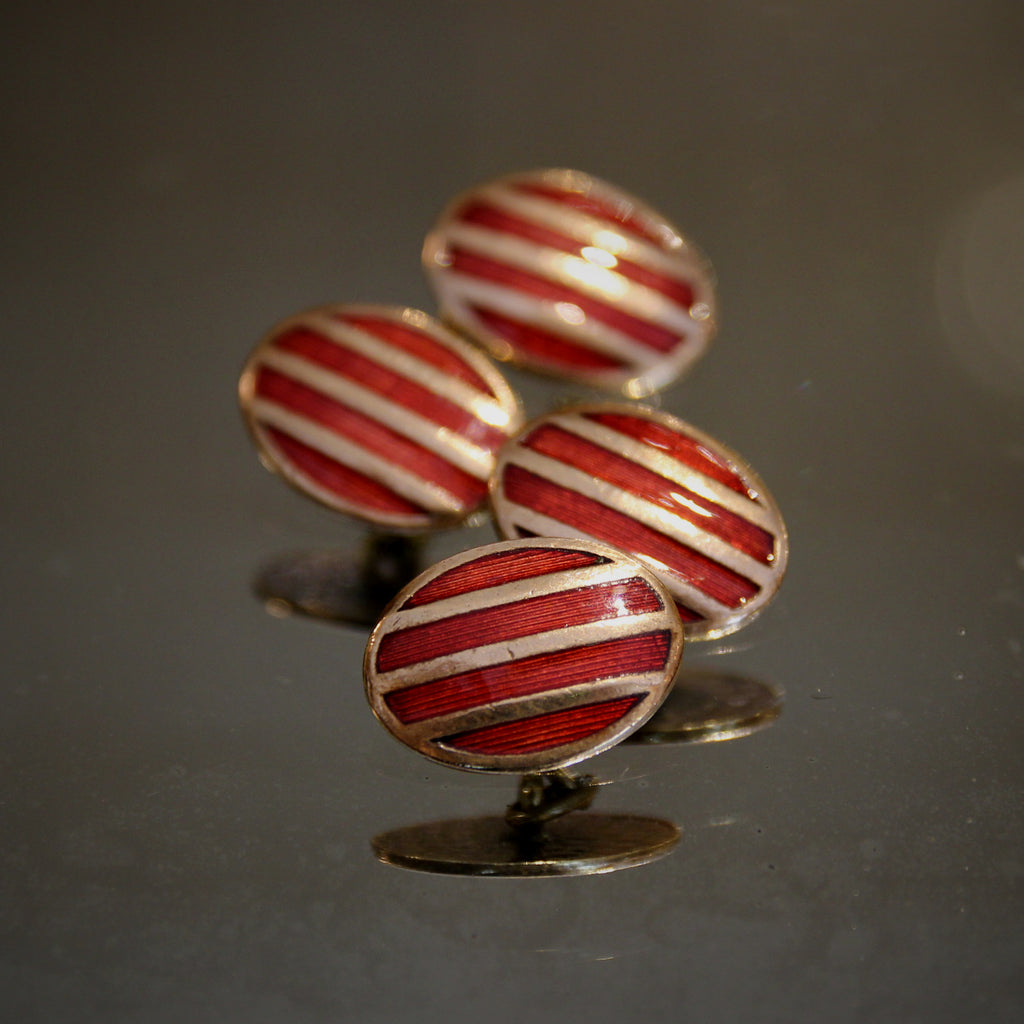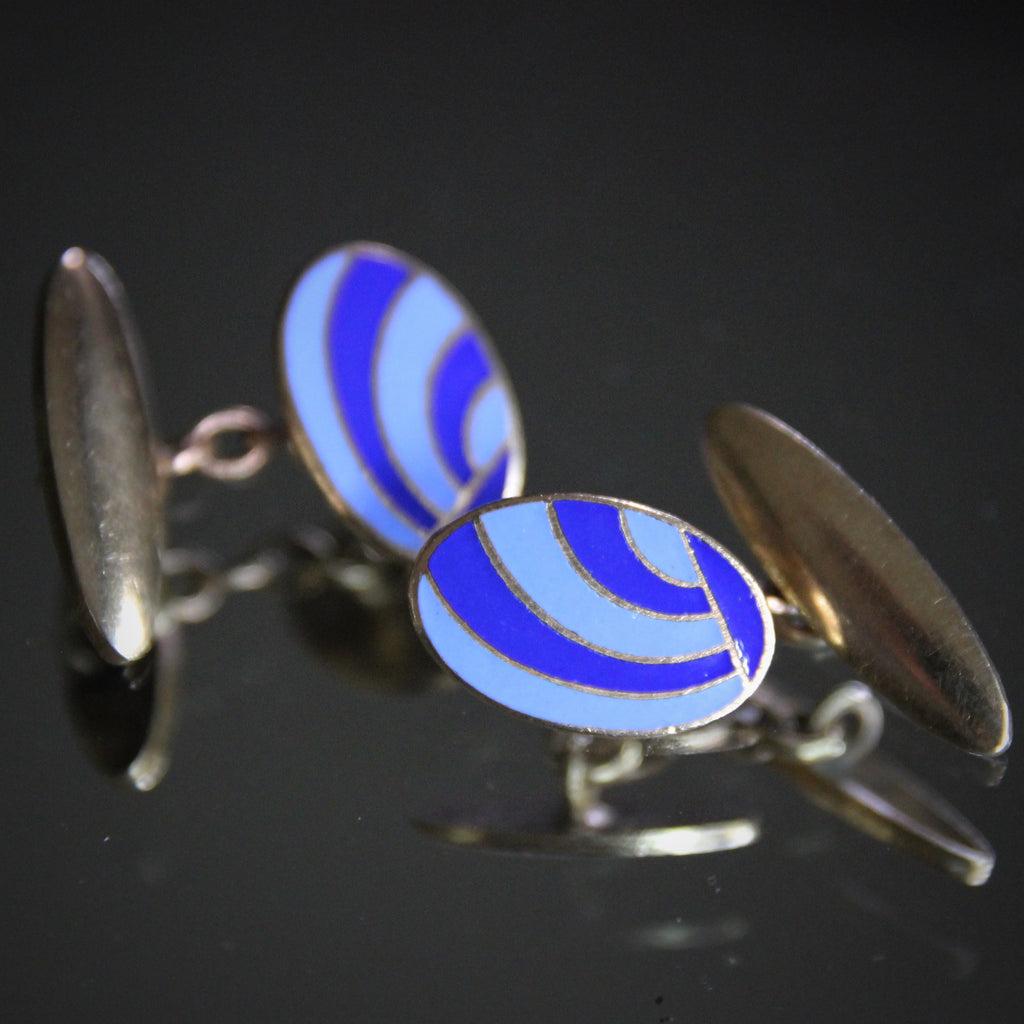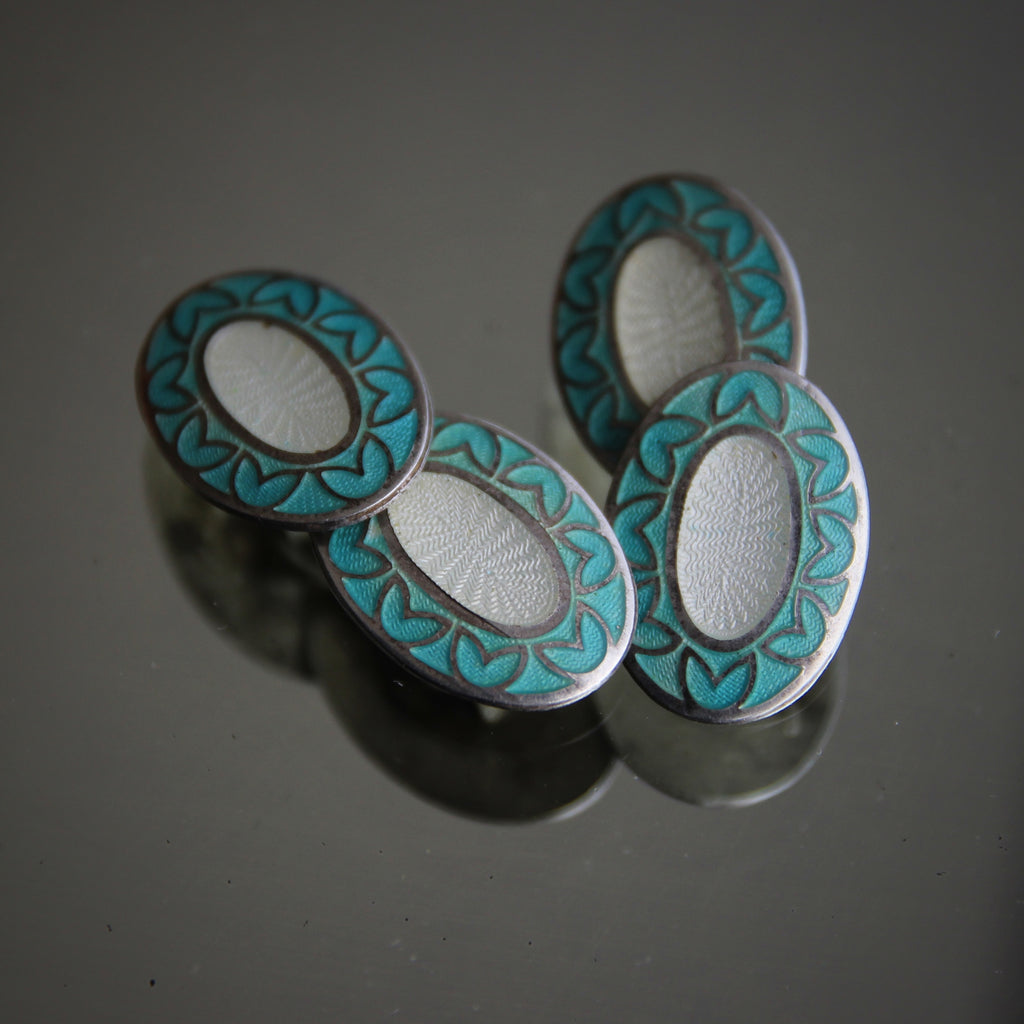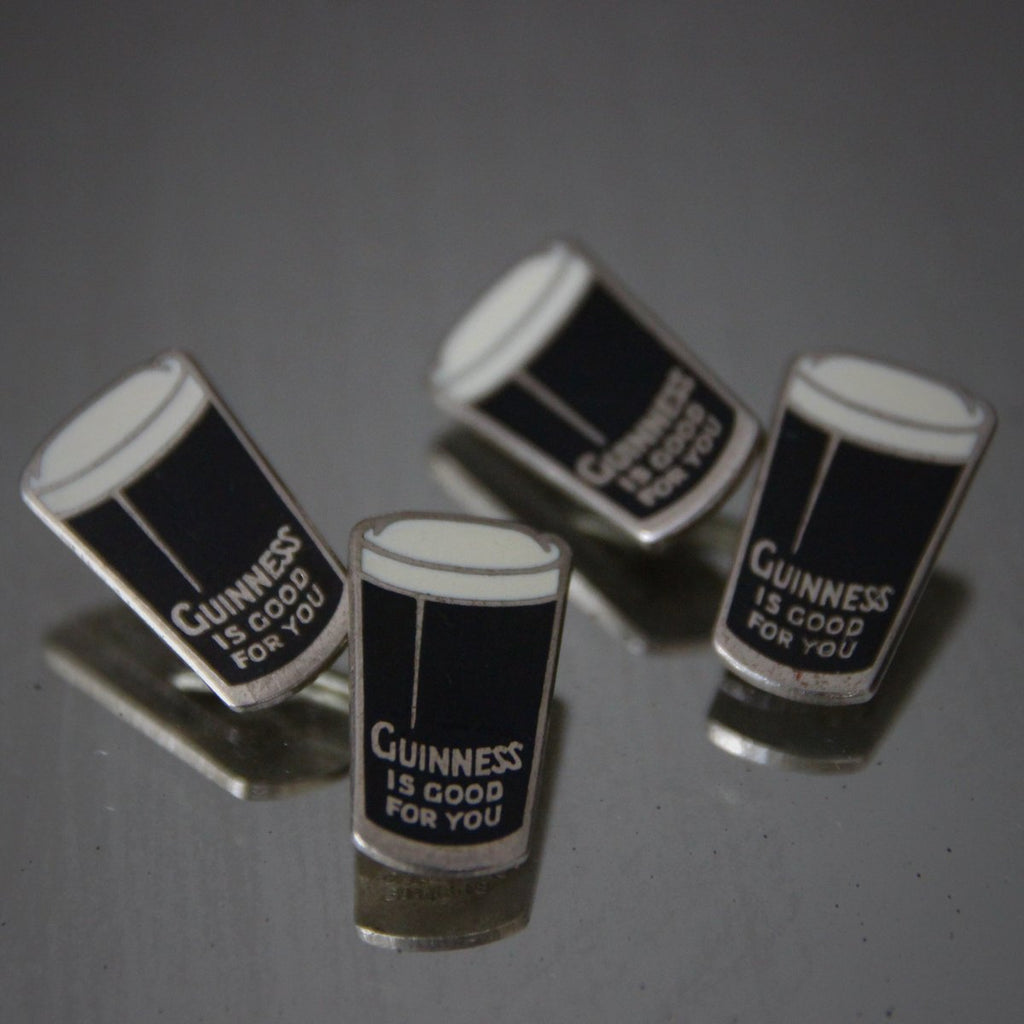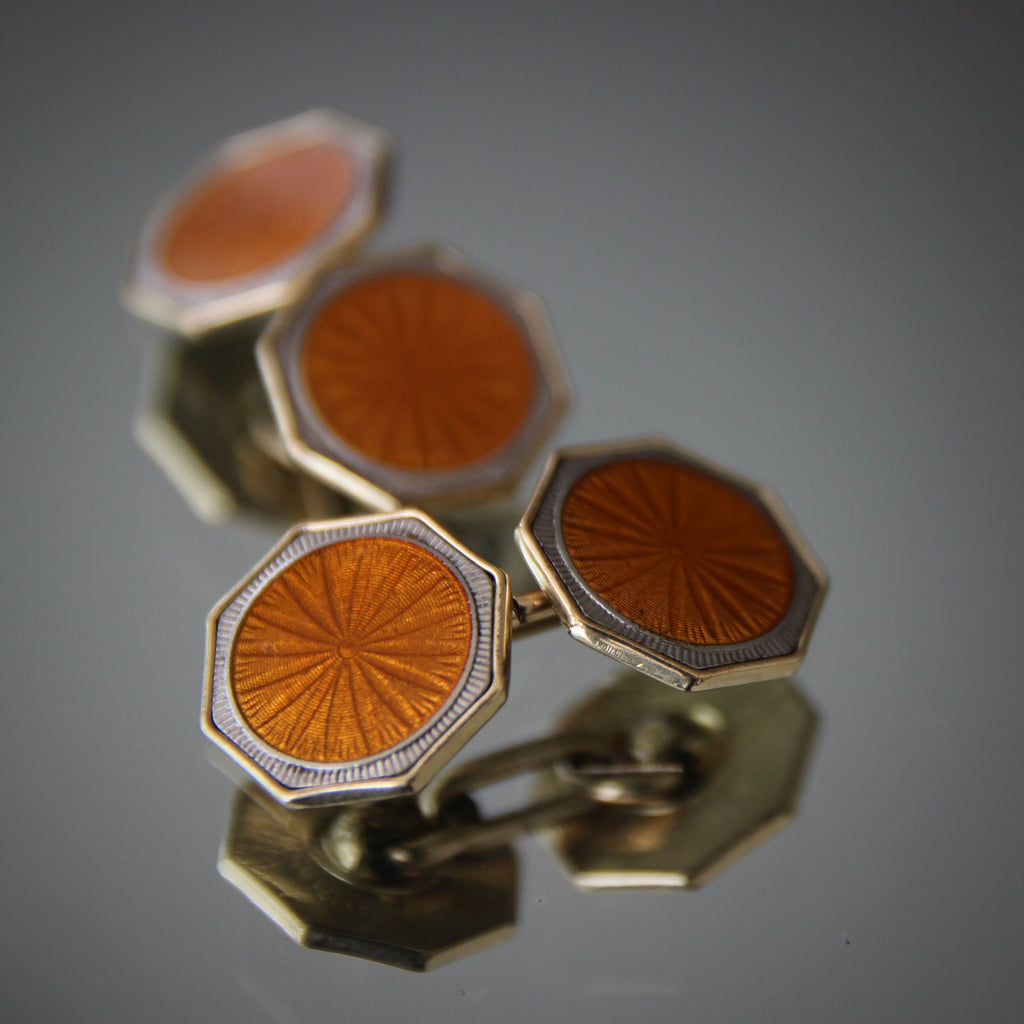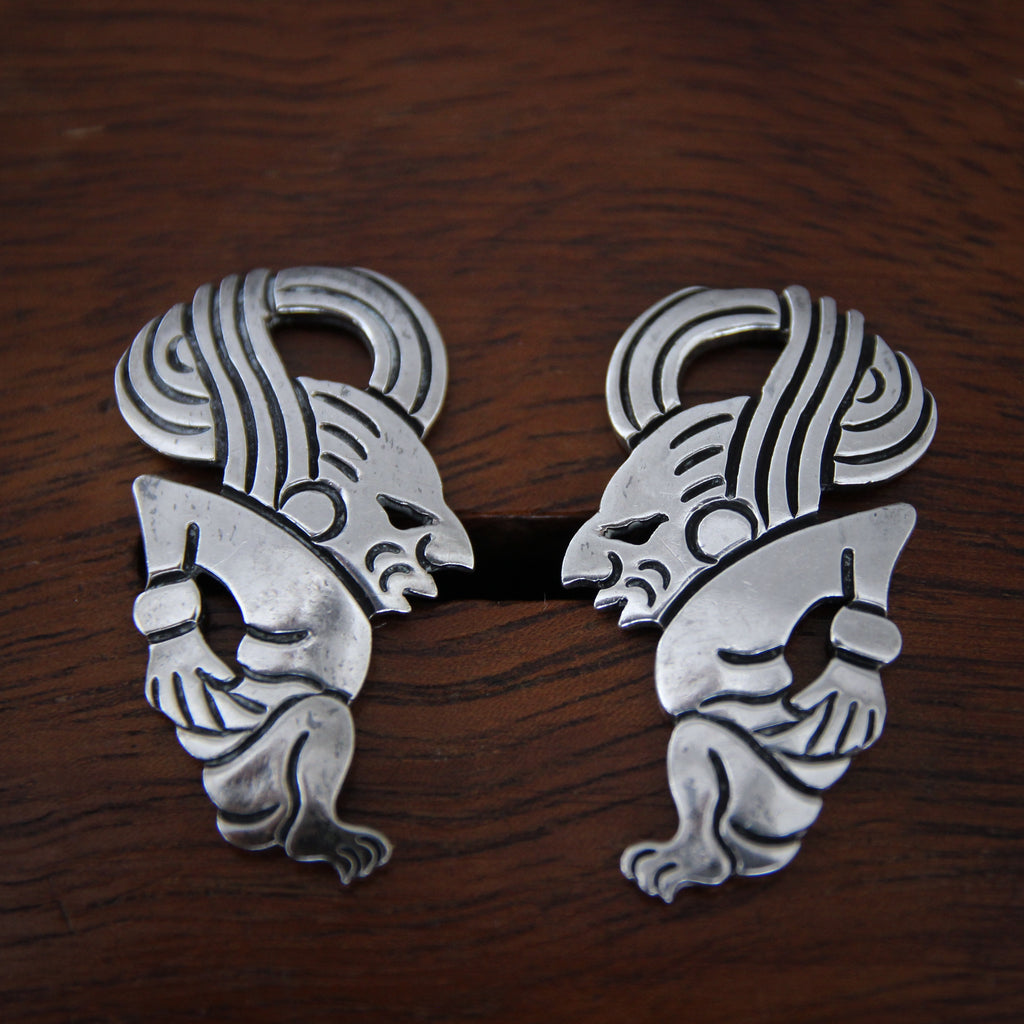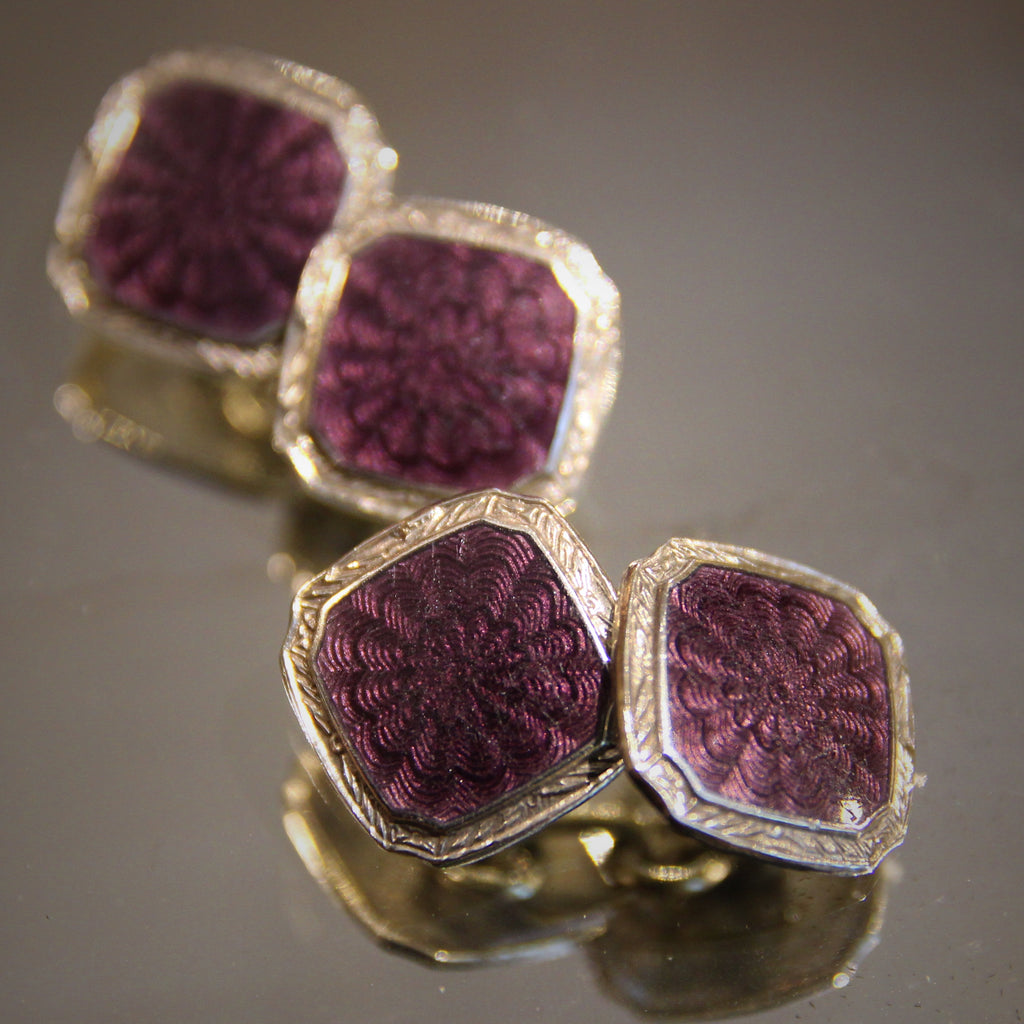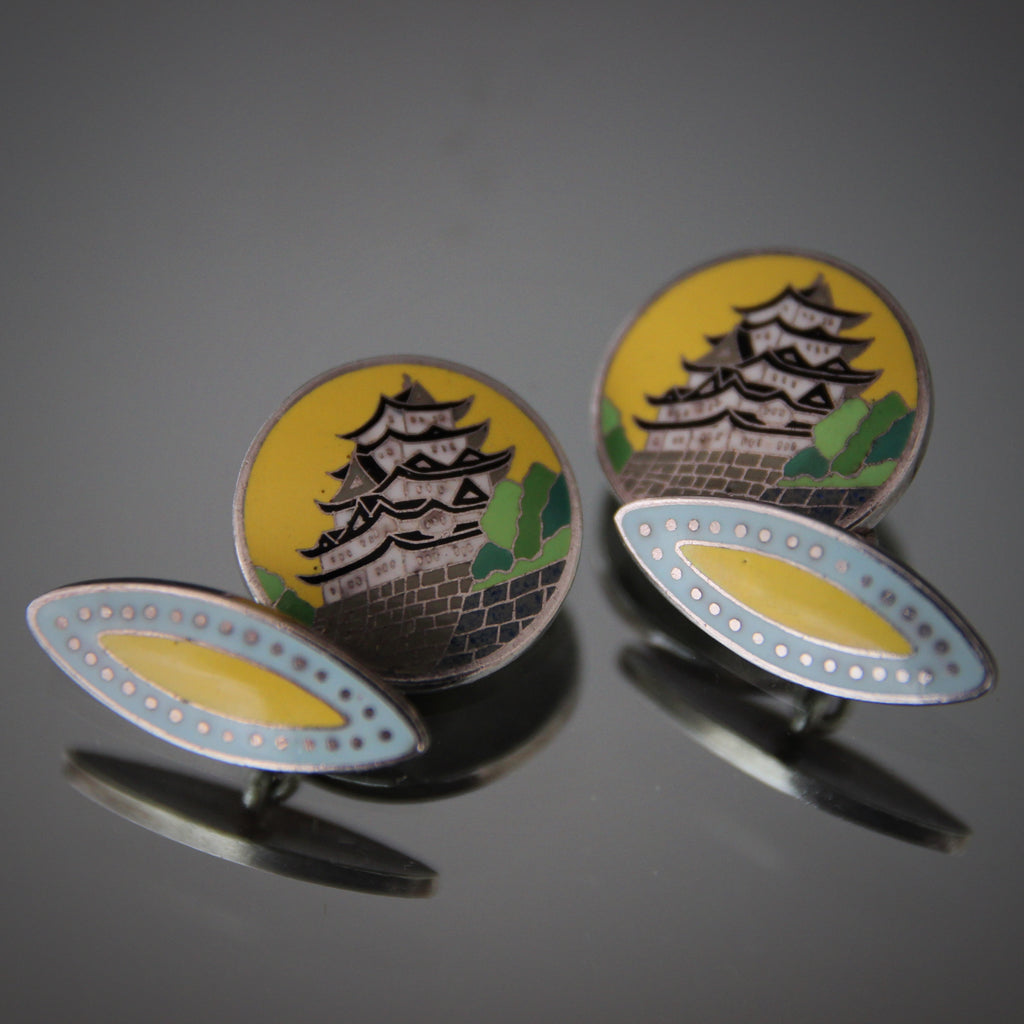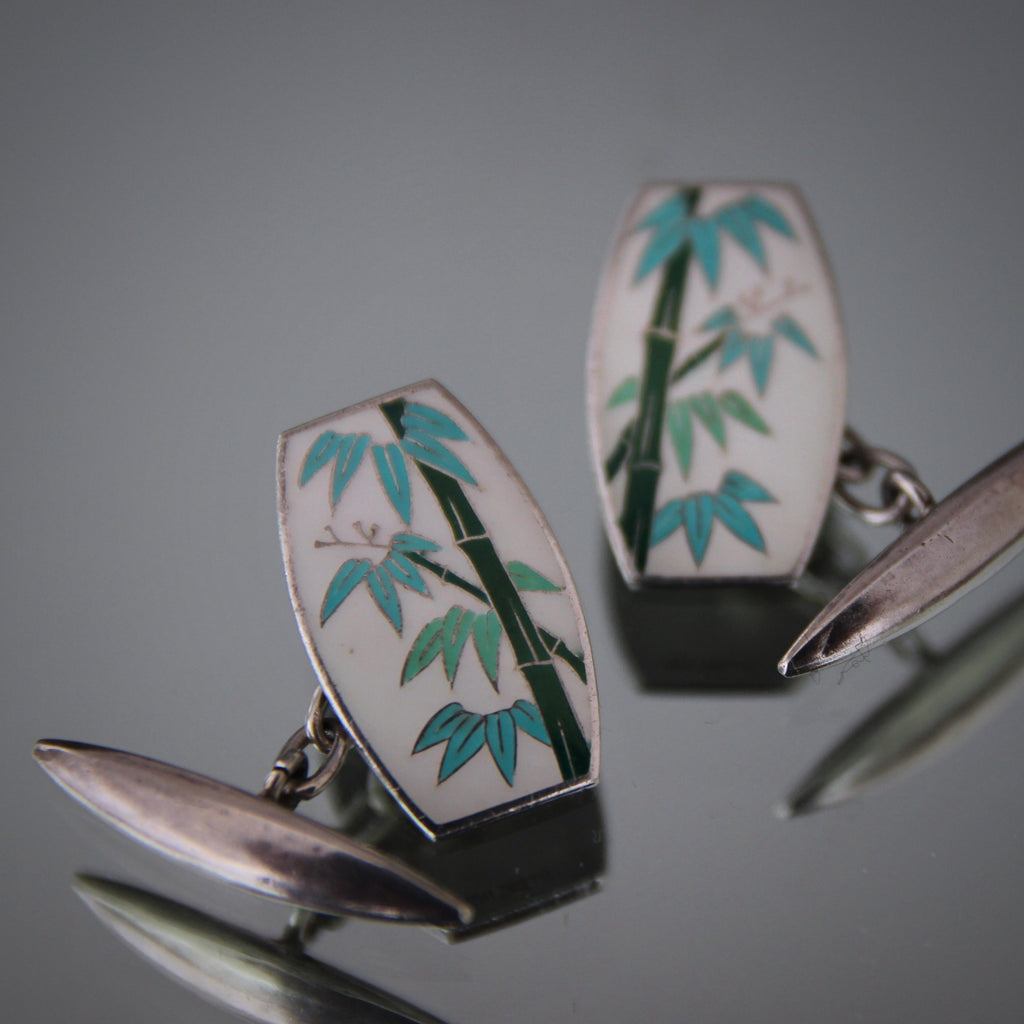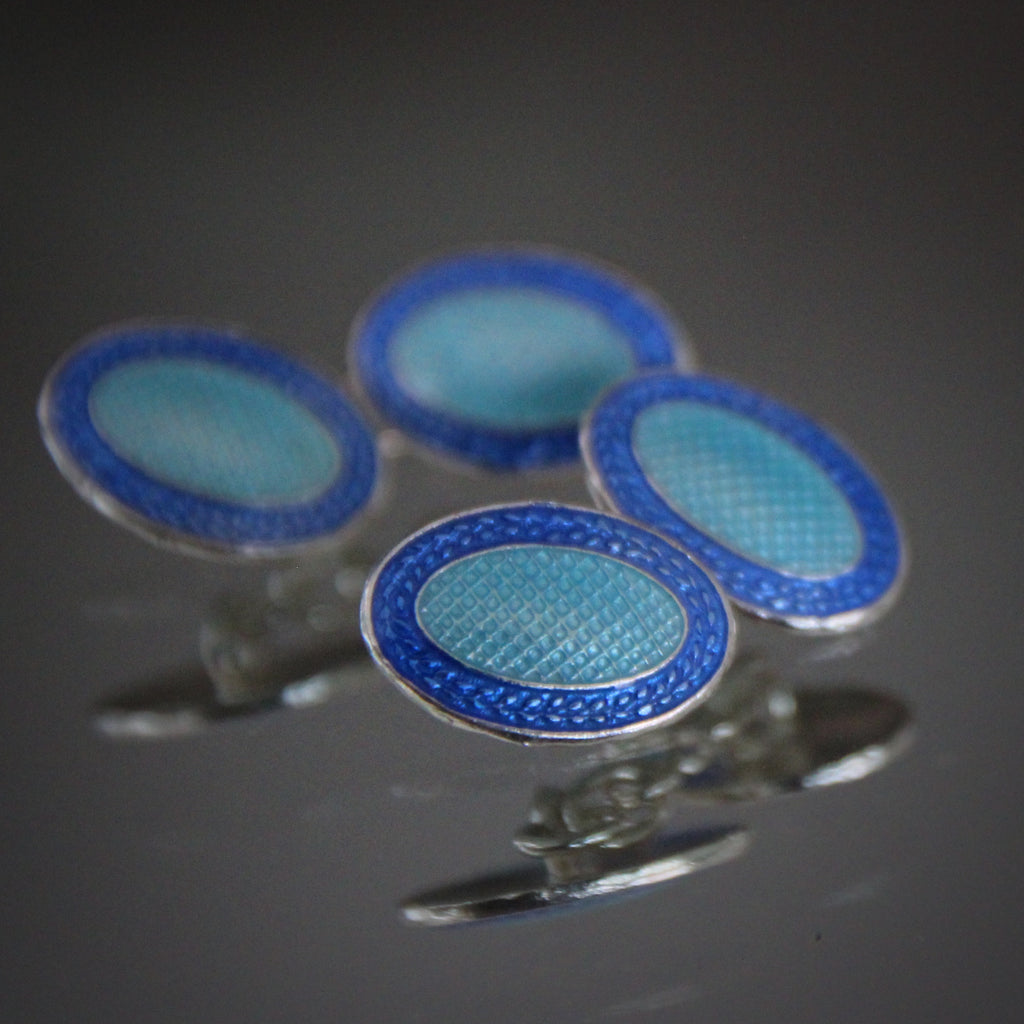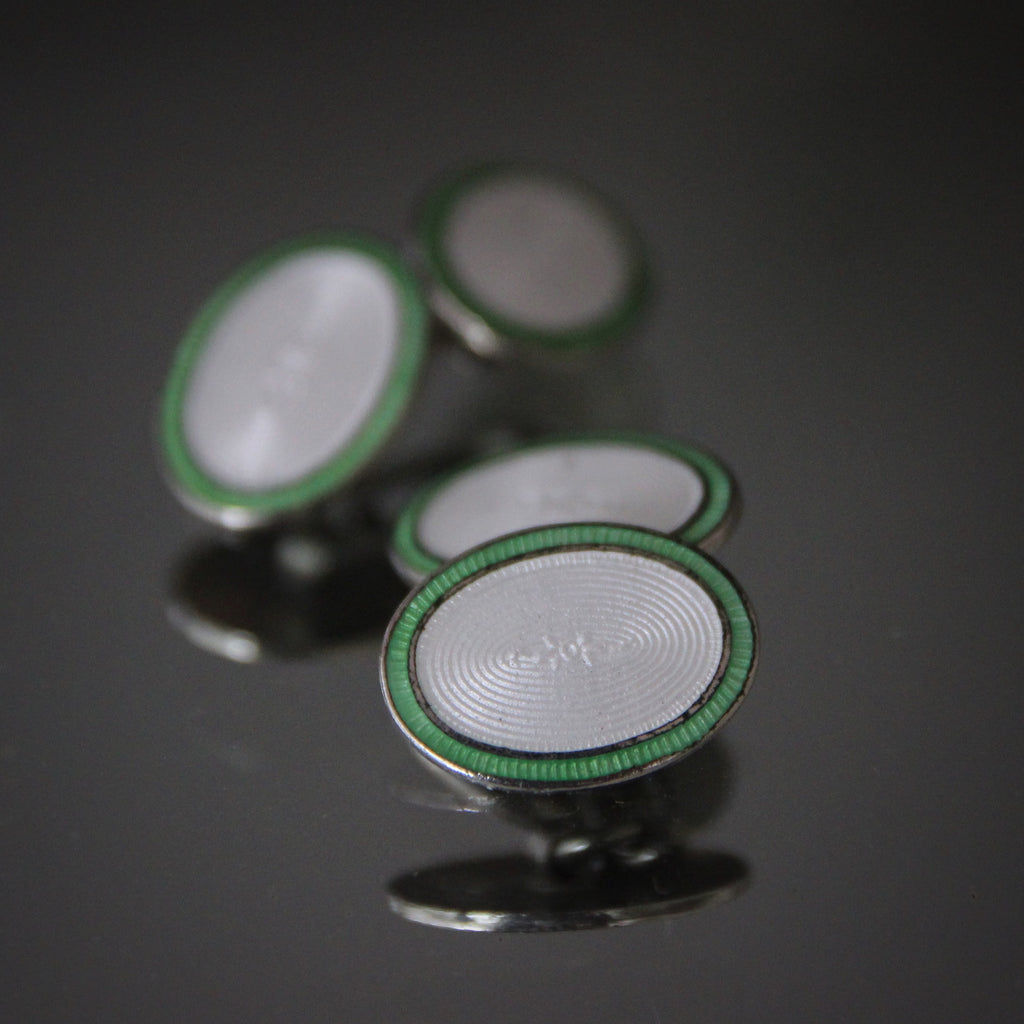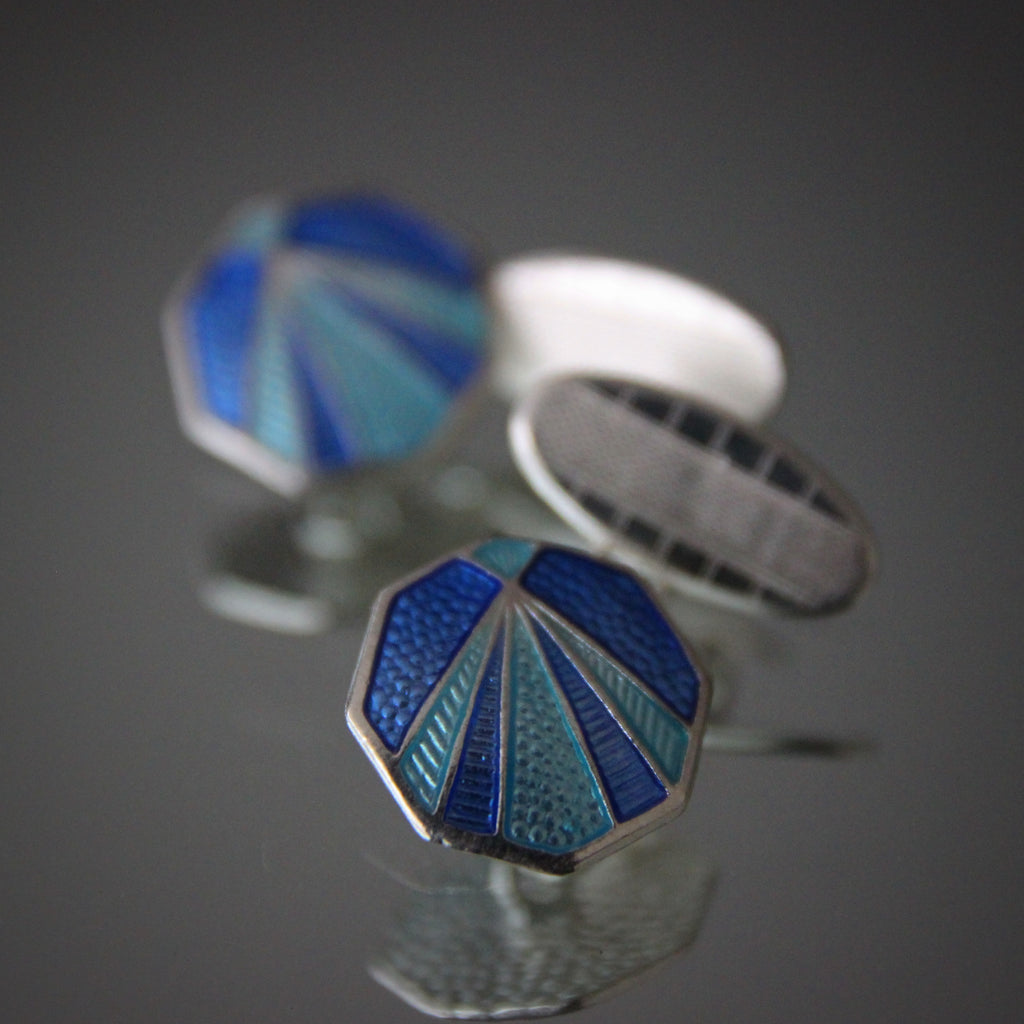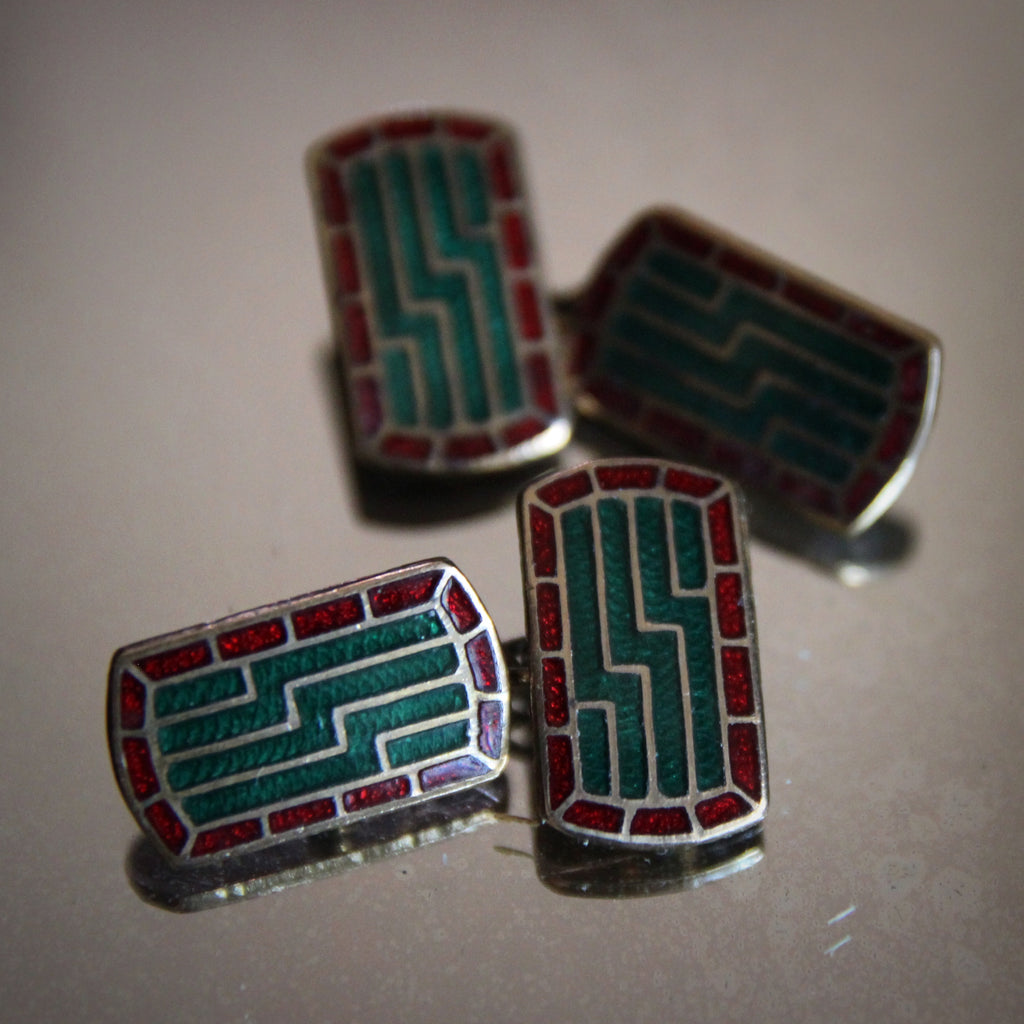JOURNAL — Cufflinks RSS
The Art Deco movement is known for its clean lines, crisp attitude and sharp angles. Therefore the biomorphic "soft square" silhouettes of these Art Deco cufflinks provide a glimpse of the next big design trend (which was then still in-the-wings): Modernism. The iridescent Mother-of-Pearl faces provide clean and classic tradition; the soft-square form of the bezels provide Modern energy. and the tasteful embellishment of the settings reminds us that these cufflinks are clearly Art Deco.
Classic Mother-of-Pearl - IV
Over the past (and next) several days, we'll be sharing some of the classic, Mother-of-Pearl cufflinks now in-stock at LEO Design.
This pair of English Art Deco cufflinks boasts deeply-lustrous Mother-of-Pearl faces, polished to a satiny sheen. They are framed in crimped octagonal bezels which provide the perfect textural contrast to the smooth faces within.
Classic Mother-of-Pearl - III
Though these cufflinks are from the Art Deco Forties, their "soft square" silhouette foreshadows the Modernist movement just down the road. Black Mother-of-Pearl faces provide multi-color iridescence—which makes these cufflinks highly adaptable to a wide range of shirt colors: white, black, grey, purple, pink, peach, tangerine, green, blue, yellow or cream. This versatility makes black Mother-of-Pearl cufflinks perfect as starter cufflinks for someone with a limited collection.
Classic Mother-of-Pearl - II
These Edwardian English Cufflinks are a symphony of textures: smooth, creamy white Mother-of-Pearl faces, punctuated with a shiny, golden "boss," and surrounded by a textured gilt bezel. Handsome, classic and always in-good-taste.
Classic Mother-of-Pearl - I
Classics are forever. Simple, handsome and timeless—these are the qualities that make a classic enduring. Over the next several days, we'll be sharing some of the classic, Mother-of-Pearl cufflinks now in-stock at LEO Design.
This pair of English Art Deco cufflinks have a rounded, polished face set within an octagonal gilt setting. Simple as they are, they closely resemble a basic shirt button—but very well done.
Deco Delights - XV
Simply elegant. This pair of American Art Deco "rolled gold" cufflinks are bold, handsome and understated. Rolled gold is a technique by which two layers of metal ( 14 karat gold on top and something less-expensive below) are bonded together under heat and pressure to create a strong, gold-topped "plied" metal. The rolled gold can be cut, shaped, formed and polished much like a sheet of solid gold could be.
These octagonal cufflinks, made by Krementz in Newark, New Jersey are fronted with gold and backed with gold-plate, too. Crisp lines add clean texture and interest to the fronts of these cufflinks—certain to make a good impression whether worn formally or casually.
Deco Delights - XIV
The Art Deco period coincided with "The Jazz Age"—inextricably linking the two movements in the modern person's mind. Jazz, with its energetic, stimulating, and (sometimes) discordant rhythms, captured the energy and conflict and promise of its day. Likewise, Art Deco design captured the streamlined and modern and efficient energy of the machine age.
These handsome English Art Deco cufflinks—with snazzy black and white enameled faces—capture the fractured energy of the Twenties. A good deal of animation is contained within each little hexagon of this dynamic pair of links.
Deco Delights - XIII
These English cufflinks—chromed and crossed with scarlet and soft grey enameling—simply scream "Art Deco!" The bright metal ground, punctuated with elegantly colored enameling, make for a handsome and lively pair of links. And the textured background adds yet another dimension of visual interest to the pair.
Deco Delights - XII
Snapping cufflinks were invented in the 1920's. This new invention allowed men to easily dress themselves—as it was during the Twenties that more and more men gave up their valets (by choice or financial circumstance). The concept behind the design is that the man could insert the cufflinks into the cuff before dressing, which allows him the ease of using two hands to manipulate the links. Once the links are inserted into their buttonholes, the man will then put-on the shirt, button-up the front, and simply snap each link closed.
The silvery faces of these English Art Deco cufflinks have a mixed-pattern which gives a somewhat "quilted" look to the links—or, perhaps, the look of an embroidered sampler.
Deco Delights - XI
Black, white and silver is such a nice color combination: clean, sophisticated, neutral. (And I suppose there are some who would argue that black, white and silver are not really colors!) The crisp juxtaposition of these colors increases the Art Deco elegance of these cufflinks—and makes them ideal for affordable evening wear.
Deco Delights - X
In my opinion, color-blocking can often go quite wrong. Even the best of them (Mondrian, Rothko, Yves Saint Laurent) don't really appeal to me. But I do love these English Art Deco cufflinks, made in the Thirties! Maybe it's the sophisticated color combination: no primary colors! Or the understated cool tones of grey and blues. Or, perhaps, it's the small size—just a little touch of color-blocking—which is not a visual assault on my vision. I find these cufflinks very handsome, indeed. Sorry Piet (and Mark and Yves)! This is color-blocking done well.
Deco Delights - IX
These handsome Art Deco cufflinks, made in Providence, Rhode Island, in the Twenties or Thirties, are crafted of mixed metals—two shades which are possibly of some gold content. This mixing of metals, in a sculptural way, always reminds me of New York's Rockefeller Center, where "sculpted architectural decoration" is sometimes painted with rich metallic colors. And, of course, Rockefeller Center was designed and built during the peak of the American Art Deco movement.
The manufacturer, Walter E. Hayward in Providence, was founded in 1851—approximately 75 years before these cufflinks were made.
Deco Delights - VIII
These English cufflinks capture "the lighter side" of the 1930s Art Deco movement. The diamond-form of the faces provide an elongated elegance while the thin embellishment—engraved and enameled striping—carries little visual weight. The pistachio and cream coloration is a nice Thirties touch, reminiscent of an ice cream cone in the Spring. Overall, these are an unusual and interesting pair of cufflinks—a "light touch" on the cuff.
Deco Delights - VII
Mother-of-Pearl has been a classic shirt button material for centuries—even before "sewn-on" buttons became popular. Here we have a Modernist Art Deco twist on the material: thick, chamfered slabs of Mother-of-Pearl topping "snapping" cufflinks from the Twenties. Snapping cufflinks were a new invention in the 1920's, which coincided with the dwindling employment of valets to dress wealthy or middle class men. With these new cufflinks, a man could easily dress himself. He would install both sides of each cufflink into the cuff before dressing—thus he was free to use two hands to negotiate the task. After putting-on the garment, he could simply snap-closed each cufflink. Ready-to-go! What this pair of cufflinks lacks in "graphic sex appeal," it makes up for...
Deco Delights - VI
These Art Deco cufflinks provide a little "wink" of fun on the cuff. The oval forms of these English cufflinks are decorated with royal blue and light grey enameling—arranged to covey an ever-so-slight swirl of motion around the perimeter. Clean lines, bold color and smooth motion are all hallmarks of the Art Deco movement.
Deco Delights - V
The chamfered and crenellated bezel around these English Art Deco cufflinks are reminiscent of a wristwatch. And the central "mortise & tenon" element adds an interesting design detail. Otherwise, the cufflinks display a simple, white Mother-of-Pearl face—classic, clean and timeless. They are a handsome, straightforward and masculine accent providing closure to a cuff.
Deco Delights - IV
The navy blue, white, grey and turquoise repp-striped enameling on this handsome pair of English Art Deco cufflinks give them an official, perhaps regimental sensibility. The soft corners of the cufflinks, however, provide a gentle modification to the sharpness—which creates an interesting juxtaposition of the passive and the aggressive. The clean combination of layered colors also creates a very proper look.
Deco Delights - III
There are very few totally new ideas—in life or in design. So, although change may sweep-in around us, sometimes we can get our bearings by looking backwards. (And, the more one knows history, the better one will be at recognizing contemporary change.)
This pair of English cufflinks, made in the Art Deco period, utilize a crisp "Moroccan Star" engraved upon their Mother-of-Pearl faces. While the star graphic was far from new (in the Thirties), its angular, precise and energetic form was perfectly-suited for use in Art Deco design. It provides an elegant accent—a modern take on an ancient symbol.
Deco Delights - II
This pair of English Art Deco cufflinks, made in the Thirties, conveys modern tension through their unusual, triangular form. The concave white inner triangle seems tightly contained—compressed with tension—within a convex, distended outer aqua triangle. One triangle is pushed-in while the other triangle is pushed-out. And the clean aqua and white enameling provides an unexpectedly sophisticated (and nuanced) coloration to this handsome pair of cufflinks.
Deco Delights - I
We are in the process of listing dozens of newly-acquired pairs of vintage cufflinks to our website's on-line shop. For the next several days, we'll be sharing some of the handsome Art Deco options, now available at LEO Design.
This pair of English Art Deco cufflinks perfectly captures the energy and style of the Art Deco movement. Chromed backgrounds convey the clean, industrial attitude of Art Deco. And the sleek bands of navy and royal blue enameling convey the forward motion and energy which Art Deco provided the world.
Back-To-School Blues - III
Let's end our exploration of "schoolboy" cufflinks with this interesting pair which displays a crest on one face and a diagonal slash of repp-striping on the other face. I am sure that the crest and stripes signify a particular unit, club, school or team—but who they are is still undetermined by me. Nevertheless, these handsome cufflinks from the Thirties provide in spades that quintessential "British Association" look. One can wear them with confidence, knowing that a certain American fashion designer has built an empire on "Faux British Aristocratic Pretension." At least this heraldry is real (for someone). Click on the photo above to learn more about them.
Back-To-School Blues - II
Repp stripes were (and are) highly-popular in England where they often represent a regiment, a school, a sports team or some other club or clan. Like tartan plaids in Scotland, members of the (originally all-male) groups would wear their colors with great pride.
Occasionally, I am able to identify the organization to which a particular repp stripe belongs. But, most of the time, I remain in-the-dark as to the pattern's origins. I also suppose that some repp stripe patterns are designed (or re-colored) by fashion designers, simply to look nice on a tie, a scarf or a pair of cufflinks—not because they are historically accurate renderings of a school's or team's colors.
Back-To-School Blues - I
By now, most students have trundled back to school. And, this year, some of them might be returning after more than a year away. Personally, I always loved the first day of school and was always excited to return. But, for others, September signaled the "Back-to-School Blues."
One of the mysterious inconsistencies of the English language—on different sides of the Atlantic—is the meaning of the term "public school." In England, where the term was coined, public schools are those fancy, expensive, private schools (open to students for a tuition fee). In America, "public schools" are those open to the wider public, paid-for by the public.
Last Crack at Summer - 3
Among the "memorable sights" of Summer is that of a nicely-tanned wrist, emerging from a light blue shirt cuff, punctuated by a white cufflink such as the one shown above. White and blue are summery enough. Add a little tanned skin and the look is complete.
These Art Deco cufflinks, made in the 1920's, are centered with a woven mesh of "mixed metals." Around that, a bright white iris beams. Though they would look good in any of the twelve months of the year, during the summer, they can work their finest magic—showing-off your hard-won summer tan.
Last Crack at Summer - 1
Having already experienced a few crisp nights and the shortening days, we realize that Summer won't last much longer. Here are a few ways to "take a last crack" at Summer, before it goes.
Taking a holiday along the seaside become fashionable in England in the late Eighteenth Century. By the early Nineteenth Century—as one will read in many of Jane Austin's novels—spending "the season" in a coastal resort town might be the highlight of a young person's life (whether dressed in "regimentals" or cotton Empire dresses). Spending time along the sea (and, perhaps, taking a dip) was considered healthful and refreshing—not to mention, a chance to let one's hair down.
Edwardian Accents - IV
Let's end our tour of Edwardian cufflinks with this interesting trio of sterling silver shirt studs—connected with a silver chain. Before World War I, sewn-on buttons had not yet become popular. Prince or pauper, a man needed shirt studs and cufflinks to fasten the plackets on his shirt. In even earlier times, men would tie or lace their shirts to close them (and many shirts were designed to be pulled-over the head). This set of fancy shirt studs bear a turquoise enameled fleur-di-lis on each sterling silver stud. One might find this interesting, given historical British antipathy toward the French (and their famous icon). But there has been a long history of fleurs-di-lis on English heraldry, especially on medieval...
Edwardian Accents - III
The English cufflinks shown here are made of "Blue John," a rare semi-precious gemstone found in just one region of England—in the Blue John Cavern, under Treak Cliff in Castleton, Derbyshire, England. Blue John is a form of banded "fluorspar" with alternating purple/blue and yellow/white layers. It is believed that the name comes from the French term "Bleu-Jaune" (that is, "Blue-Yellow," a reference to the banded coloration). Even today, scientists have not figured-out what causes the unique and beautiful coloration. It is uncertain when the first veins of Blue John were discovered in Derbyshire, but the first record of mining the rare stone comes from a letter in 1766 (making reference to the leasing of the mines). Initial quarrying provided enough Blue John to...
Edwardian Accents - II
La Belle Époque spread to North America where sometimes it was called "The Gilded Age." In America, this was a period of tremendous growth, industry and invention. But, like elsewhere, the financial fruits of this boom were concentrated near the top—amongst the "Robber Barons." In my old home of New York City, the beneficiaries of the Industrial Revolution had names like Astor, Morgan and Vanderbilt. They controlled transport, banking and various lucrative trades. In my new home of Pittsburgh (a real heavy-hitter during The Gilded Age) names like Carnegie, Frick, Mellon or Schwab might ring a bell, even today. It has been argued that Pittsburgh "built America" during the late 19th and early 20th Centuries. In fact, one neighborhood in...
Edwardian Accents - I
The Edwardian Age was a time of handsome style, obvious socio-political awakenings, and the last few years of innocence before The Great War and the turbulent decades to follow. This week, we'd like to share a few offerings from the Edwardian cufflink collection at LEO Design. The British Empire expanded greatly during the Victorian Age. The World—and its peoples—were viewed as resources to utilize (if not exploit). And England, like other powerful countries at their strongest, was not shy about stepping-up to seize-the-moment. During the late Victorian and Edwardian periods, England controlled so many far-flung countries that it was said that "The sun never sets on the British Empire." I do not single-out England as a lone villain in this endeavor. Other...
Nouveau Novelties - IV
Let's end our collection of Art Nouveau cufflinks with this understated—but nevertheless handsome—pair of Edwardian English Art Nouveau cufflinks. A scrolling botanical bas relief covers half the surface area of these golden, elongate-hexagonal cufflinks.
"Edwardian" usually refers to the period of Edward VII's reign: from 1901 (when his mother, Queen Victoria, died) to 1910 (when he died). Edward, nearly 60 when he was crowned, was a fashionable and socially-prominent monarch who lived in a "modern" age—that is, a period when information, news and photo images were able to be widely and quickly distributed. Thus, his sartorial choices and leisure behaviors were quickly disseminated around the world—where they could make an immediate impact and be promptly emulated.
Nouveau Novelties - III
Enameled cufflinks are probably my favorites. And, while most of our collection of enameled cufflinks are from the Art Deco period, I occasionally acquire an earlier pair (from the Art Nouveau period) or a later pair (from the Modernist period). Enameling is the process of laying glass powder upon metal and then heating it to the point where the glass powder melts into molten glass. Upon cooling, the "enameling" is simply a layer of glass (often colored) lying upon a base of metal (sometimes engraved in a process called guilloché). Enameling provides a rich, luxurious surface and allows for a creative explosion of colorful graphic design. Fine, machine-turned engraving (beneath the enamel) provides a whole new dimension of pattern...
Nouveau Novelties - II
At the time that these cufflinks were made—around the Turn-of-the-Century—pearls were the rarest, most mysterious, and most expensive of "gemstones." At this point, cultured pearls had not been developed. And, while these cufflinks are not made of real pearls, they are made of Mother-of-Pearl (and, with their soft luminescence and iridescence, are highly reminiscent of the coveted precious globules).
From Biblical times, pearls have been lauded as "more precious" than other objects. Pearls were referenced in numerous parables, lessons and other maxims. And, let's not forget, "The Pearly Gates" did not get their nickname for no reason.
Nouveau Novelties - I
For a few days, we would like to share some of our Early Twentieth Century Art Nouveau cufflinks—from England and from America.
This pair, probably American, have a decidedly Eastern European Secessionist design—in the form of hexagonal, "riveted" shields. What they lack in color, they more than compensate for in design-punch and style. Imagine them—handsome and proud—on your shirt cuffs.
Welcome, September!
The sapphire—amongst the treasured "Cardinal Gemstones"—has been highly-valued for millennia and is the birthstone bestowed upon those born in September. Indeed, there is something immaculate, heavenly and, well, divine about the sapphire—a pristine presence somehow elevated above earthly matters and concerns. Their crisp purity reminds us that perfection is, indeed, possible. Sapphires are made of corundum, made blue by the presence of iron and titanium. Other colors of sapphires can be found, too, depending upon the impurities found within it: yellow, purple, orange, grey or black. Some stones have two colors (side by side) and corundum without any impurities is clear. Red corundum (colored with chromium) is called a ruby and they are sometimes mined near sapphires Sapphires are found...
Mod Links - IX
Let's end our procession of Modernist cufflinks with these understated—but interesting—sterling silver accessories. They were made shortly after World War Two by Simmons, a jeweler in Attleboro, Massachusetts. Simmons was founded in 1873—in the middle of the Victorian Era—and, thus, was well-aware of that earlier design period. Although the size, shape and functional mounting of the cufflinks is clearly Modernist, the scrolling botanical engraving is a tip-of-the-hat to Simmons's Victorian roots. But the engraving is not a "direct lift" of Nineteenth Century foliate engraving. Instead it is adapted, loosened-up and enlarged, making it a clearly-Modernist embellishment.
Mod Links - VIII
The Modernist Movement—like many design movements before it—was known to "lift" aesthetic inspiration from history and the work of earlier designers. Modernist designers and craftsmen (like all artists) looked-back for historical, literary and cultural elements which could be "revived" (or adapted) for their contemporary works. I've sold Mid-Century pottery inspired by archeological discoveries—including vases decorated to emulate early paintings from the caves of Lascaux, France. Many Modernist ceramics forms are inspired by the utilitarian objets (jugs, urns, bowls) uncovered at sites in Egypt, Greece, or Mesopotamia (which explains the abundance of jug handles on so many Modernist vases). Ancient shields, architecture and other graphic elements were adapted and freely-utilized in Modernist decor. It's all part of the same "Cycle of Design" from the beginning...
Mod Links - VII
These Czech Modernist cufflinks have seen quite a bit of dramatic history! They were made in the 1920's, during the period known as The First Czechoslovak Republic. After World War One, and the collapse of the Austro-Hungarian Empire (1918), several former portions of the Empire were cobbled together to create a new country—and the name "Czechoslovakia" was born. After 1933, Czechoslovakia was the only remaining functioning democracy in Central Europe. But it was not to last. In 1938, Germany took Sudetenland, the "German Region" of Czechoslovakia. Other regions were ceded to Hungary and Poland. Thus began The Second Czechoslovak Republic which was only to last six months. In 1939, the Nazis took the rest of the young country; from 1939 to 1945, Czechoslovakia ceased...
Mod Links - VI
"In the old days," silversmiths like Paul Revere worked hard to avoid any sign of hammer marks in their wares. They would use increasingly fine "peens" from their collection of hammers to create a perfectly-smooth, mirrored finish to their silver works. The best items were devoid of any hammer marks or imperfections. At the turn-of-the-Twentieth-Century, Arts & Crafts artisans embraced a different point of view. Prominent hammer marks were now encouraged as part of the decoration—providing evidence of the human handwork that went into creating such a piece. The contemporary cufflinks, shown above, are fashioned of hand-hammered sterling silver. The only embellishment to be found on their large, Modernist faces is the skillful hand-hammering which catches the light—and reminds us that they...
Mod Links - V
"Celtic Knots" refer to the interlacing, never-ending "braid-work" in the art and craft of the Irish, Scottish, Cornish and Welsh. Although earlier examples of such "plaited" design themes are found in other places—early Roman mosaic work, Byzantine stonework, Scandinavian woodcarving, and other European folk craft—the Celts embraced the style and vigorously adapted it to their own culture. After Christianity was introduced to the Celts (in the Fourth Century AD), Celtic-style plaiting (and other design) was incorporated into every sort of religious works: architecture, stonework, woodcarving, even illuminated manuscripts. In the mid Twentieth Century, when these cufflinks were made, there was a powerful movement in Celtic lands to revive and promote the ancient, native folk culture—especially as a means of differentiating themselves from the dominant English...
Mod Links - IV
Two chunky slabs of "coffee & cream" marble make for a substantial pair of Modernist (nearly Brutalist) cufflinks from the 1950's or 1960's. The goldtone bevelled settings, which handsomely frame the ingots, were patented in 1949. These cufflinks perfectly illustrate the evolution of cufflink design after World War Two—when Art Deco began to take a back seat to the weighty minimalism of Mid-Century Modern. Men's tailoring—including ties, cufflinks and jacket lapels—became wider, thicker and heavier.
Mod Links - III
As we discussed two days ago, "Modernism" began in the late Nineteenth Century and included Art Nouveau, Arts & Crafts, and the Art Deco movements. Modernism came to full fruition with the Mid-Century Modern period after World War II, the 1950's through the 1970's. The handsome cufflinks, shown above, are Modernist—but with the streamlined, sculptural Art Deco influences which suggested the "Jet Age Industrialism" to come. They were made in Rochester, New York by Hickok.
Mod Links - II
Aage Weimar (1902-1986) was a Danish Modernist jeweler known for his bold (and sometimes Brutalist) designs. These striking, sculptural cufflinks were made in the 1940's or 1950's of 830 silver. Northern European Modernist cufflinks—those from Scandinavia, Finland or Soviet Russia—tend to exhibit strong, sculptural forms, often in simple silver or gold vermeil (that is, silver coated with a layer of gold). These Danish cufflinks, though uncomplicated, still serve-up a bold aesthetic punch.
Mod Links - I
This week we'll be sharing a selection of Modernist cufflinks, recently added to our on-line collection. Please click here to see our full range of cufflinks—from Victorian to Modernist. One often thinks of "Modernist" as concurrent with "Mid-Century." But Modernism actually began during the end of the Nineteenth and beginning of the Twentieth Centuries. Dr. Christopher Dresser was pushing Space-Age boundaries in England during the 1880's. L'Art Nouveau—"The New Style"—was well underway by the Turn-of-the-Century. And the Bauhaus School (as well as Art Deco) flourished between the World Wars (1919-1939). These cufflinks, made in the Twenties, are clearly "Cubist" in form. Cubism began in the first decade of the Twentieth Century, two decades before these cufflinks were made. A faceted rock crystal punctuates...
Let the Sun Shine! - XI
We're celebrating the summer by sharing a collection of "sunny" cufflinks—little reminders on-the-cuff of the brightness and warmth which may leave with the season, but will always come back again.
Let's end our parade of sunshine-inspired cufflinks with this interesting and unusual pair from the late Art Deco period. Triangles of 9 karat gold are engraved with concentric circles (at center), from which radiating "sunbeams" emanate outward.
They were hallmarked in Chester, England in 1958—a bit late for the Art Deco period—though there were still a few designers working in that inter-war style (carmakers, furniture crafters and cinema designers, for example).
Let the Sun Shine! - X
We're celebrating the summer by sharing a collection of "sunny" cufflinks—little reminders on-the-cuff of the brightness and warmth which may leave with the season, but will always come back again.
These cufflinks are a favorite of mine! The warm amber enameling. The crisp white bezels (perfect against a summer-tanned wrist). And the intricate guilloche work, pulsing beneath the glass. Add to that their resemblance to the sun and—well, maybe I should keep these myself! They were made in the Art Deco Thirties and represent the height of the period's glamour, style and sophistication.
Let the Sun Shine! - IX
We're celebrating the summer by sharing a collection of "sunny" cufflinks—little reminders on-the-cuff of the brightness and warmth which may leave with the season, but will always come back again. I have described these cufflinks as "Edwardian"—and have dated them to around 1905—but I may have been too conservative in my attempt, not wanting to overstate their age. They might, indeed, be a bit older than this. The company that made them, "Foster & Bailey," was founded in 1873 in Providence, Rhode Island. Jeweler Theodore Foster (first in partnership with Mr. White and then with Mr. Bailey) grew the business from a one floor operation in 1880 to a full building of 275 craftsmen in 1898 (when Foster bought-out Bailey). They...
Let the Sun Shine! - VIII
We're celebrating the summer by sharing a collection of "sunny" cufflinks—little reminders on-the-cuff of the brightness and warmth which may leave with the season, but will always come back again.
These English Art Deco cufflinks from the Thirties are a real spot of sunshine. The fronts are 9 karat gold, engraved with radiating sunbeams. Let them bring a dose of summer sunshine to your outfit, any time of year.
We have recently added a cache of new cufflinks to our website—and have many more pairs to add in the weeks to come.
Let the Sun Shine! - VII
We're celebrating the summer by sharing a collection of "sunny" cufflinks—little reminders on-the-cuff of the brightness and warmth which may leave with the season, but will always come back again.
Pinwheels of light shine-forth from the faceted faces of these black mother-of-pearl cufflinks—reminiscent of a darkened sun-in-eclipse. Actually, the cufflinks are part of a larger "dress set": a matching suite of cufflinks and shirt studs for black tie. They have a handsome, understated Art Deco style—and are set into gold-plated mountings. They were made by Krementz in Newark, New Jersey in the Thirties and come in their original presentation box.
Let the Sun Shine! - VI
We're celebrating the summer by sharing a collection of "sunny" cufflinks—little reminders on-the-cuff of the brightness and warmth which may leave with the season, but will always come back again. These "snapping" cufflinks were patented in 1920—perfect timing for such a new invention—which was just about the time that most men had lost their valets (if they had ever had one to begin with). These cufflinks snap-apart into two halves; each half is inserted into the shirt cuff before dressing. The shirt is only then put-on, and the sleeves (that is, the cufflinks) are "snapped" closed with little fumbling. This design allows the man to use both hands to insert the cufflinks and avoids the awkward contortions sometimes required while inserting "old fashioned" cufflinks...
Let the Sun Shine! - V
We're celebrating the summer by sharing a collection of "sunny" cufflinks—little reminders on-the-cuff of the brightness and warmth which may leave with the season, but will always come back again. When describing cufflinks, the term "gold-fronted" is more commonly heard in England than it is in the States. Usually, it means a layer of gold is plied to a layer of sliver (or another less expensive metal), resulting, in this case, with a pair of cufflinks whose faces are made of the more precious metal. This pair of English Art Deco cufflinks are just such an example. Gold-fronted ovals are stamped and then decorated with "machine-turned" engraving—which creates the handsome optical band encircling the ovals. The resulting effect is of...
Let the Sun Shine! - IV
We're celebrating the summer by sharing a collection of "sunny" cufflinks—little reminders on-the-cuff of the brightness and warmth which may leave with the season, but will always come back again. Swirling rays of light—from the needles of a machine-turned etching machine—rise within the framed octagons of these Art Deco cufflinks from the Thirties. Though not marked with a specific gold content, many cufflinks of this quality had at least a small amount of gold in the alloy—or was finished with a layer of gold (or an alloy containing some gold). This is what has kept the cufflinks so bright after so many decades. This pair was made in Providence, Rhode Island, once the center of commercial jewelry production in the...
Let the Sun Shine! - III
We're celebrating the summer by sharing a collection of "sunny" cufflinks—little reminders on-the-cuff of the brightness and warmth which may leave with the season, but will always come back again.
These English Art Deco cufflinks glow from their mother-of-pearl faces. Etched upon them is graphic, intertwined "Moroccan Star"—a little taste of Orientalism, perhaps (if not the Gothic Revival). And, lest we forget, our Sun is, indeed, a star itself—one of millions of flaming bodies, hovering in the heavens above.
Let the Sun Shine! - II
We're celebrating the summer by sharing a collection of "sunny" cufflinks—little reminders on-the-cuff of the brightness and warmth which may leave with the season, but will always come back again.
These 9 karat gold Modernist cufflinks—hallmarked London, 1960—channel the energy of Carnaby Street's swank & swish: suede jackets, go-go boots, and the boundless optimism of the Age of Aquarius. A radiant sun beams down upon us all (or is that an upwards emanation?). And the "back" faces remain blank, making them perfect for monogramming, should that be desired.
Let the Sun Shine! - I
While we're soaking-up the summer warmth right now, let's not forget that the sun soon will be spending more time down South. The Autumn crisp will be here soon—followed by the Winter's chill.
We've recently loaded a new cache of cufflinks to our website (with many more pairs to come). Over the next several days, we'll be sharing pairs which are somehow reminiscent to the Summer Sun. Perhaps a pair of their shining faces will help you take the sun with you throughout the coming seasons, a small reminder that the Sun has gone—but it will come back.
Perfect with a Tan
If you must dress-up during the summer, why not take advantage of the season? Imagine this handsome pair of English Art Deco cufflinks, fastening a crisp, light-blue shirt, against a perfectly summer-tanned wrist. The mother-of-pearl irises will certainly "pop" while the blue tone of the surrounding color will be pulled forward. And the golden settings will certainly add its own measure of summer warmth.
Countdown to Father's Day - VIII
I've sold hundreds of pairs of cufflinks over the years—covering many periods, aesthetics, materials and colors. But, if I had to identify "a best seller," it would be "Blue Art Deco." Art Deco graphics are widely-popular, perhaps because the graphics can be as bold as they wish, and yet, when restrained within a postage stamp-sized area, they are never overbearing. And blue is popular because it's so easy to wear. Who doesn't like blue?
This pair of English Art Deco cufflinks have bold, parallel stripes of navy enameling, separated by lines of sky blue enameled dots. Gently regimental—without being militaristic—they would look great on a white, blue or pink dress shirt.
Countdown to Father's Day - V
Off the Western coast of Scotland, lies the mystical island of Iona. It has been inhabited by humans since the Iron Age (approximately 1,000 years BC) but became most famous when Saint Columba (from Ireland) founded a monastery here in 563 AD. This was the beginning of Scottish Christianity. The monastery, which still stands today, is not large, but it exhibits wonderful details of early Medieval architecture. Today, the island remains a popular destination for spiritual pilgrims and tourists seeking a contemplative place to meditate and relax. A sophisticated culture of quality handcraft exists on the island, providing visitors to help support the abbey and the local economy. These silver cufflinks, made in the period after World War Two, exhibit the...
Countdown to Father's Day - II
In 1759, Arthur Guinness signed a 9,000 year lease (at £45 per year) for large premises at Saint James's Gate, Dublin, where he planned to operate his brewery. From medieval times, Saint James's Gate was the western entrance to the walled city of Dublin—and the traditional Irish starting point for the Camino pilgrimage to Santiago de Compostela, the burial site of the Apostle Saint James. Other brewers had operated in the area before Guinness opened its doors. Today, the original medieval gate is gone, though the neighborhood still bears the same name. Over time, Guinness Brewing thrived and expanded, acquiring space for more brewing, offices and living quarters for workers. The premises even had its own power plant. In the Nineteenth Century,...
The Belmont is Back!
2020 was a year of tumult for America's premier horse racing community—as it was for pretty much everyone else on Earth. Races were cancelled or run to empty stands. Alas, 2021 has also been a tumultuous year at the tracks, too—but not due only to the Coronavirus. Rather, it was due to the potential doping with banned substances of an injured racehorse, Medina Spirit, who had won the Kentucky Derby (followed by a third place showing in the following Preakness Stakes). Nevertheless, the Belmont Stakes at Belmont Park, just outside of New York City, will be run today. Medina Spirit has been eliminated and will not be running; his trainer has been suspended from racing for two years.
Welcome, June!
The birthstone for the month of June is not a "stone" at all. It is the pearl—the mysterious and exotic and (at one time) ultra-rare treasure from the seas. Pearls, which represent purity, innocence and humility, were once the most precious of all the jewels. Egyptian aristocrats would be buried with their pearls. The Ancient Greeks believed that pearls were the tears of the gods. The Bible tells of the wise merchant who would sell all his stock in order to acquire one perfect pearl. And "pearls before swine" is a classic metaphor for wasting something on a person who cannot understand or appreciate it. Even the Gates of Heaven are encrusted with pearls—"The Pearly Gates." The famous American gemologist...
Accessories for the Natural Man - XVIII
An understated white-speckled brown enamel inhabits one corner of these English Art Deco cufflinks from the 1930's. Directly across the face, the chromed metal is broken into two fields: one is textured while the other is smooth. In the center, running diagonally between the fields is a cream enameled bar. Lots of activity and lots of motion make for a dynamic design, quite unlike any other cufflinks.
Accessories for the Natural Man - XVII
Here's another handsome pair of English Art Deco cufflinks. This time, the face of the cufflink is bisected with a deep furrow, slashing-though the color blocks of brown and white enameling. And while the coloration of the enamel is understated, the visual effect is nonetheless bold. Made in the Thirties in England.
Accessories for the Natural Man - XVI
"Soft squares" of black mother-of-pearl are machine engraved with a flower petal design (also known as a "corollate"design) and mounted into art deco settings. They make for a handsome cufflink, well-suited to shirts (or shirt stripes) of many different color variations.
Accessories for the Natural Man - XV
Art Deco was vastly popular—and it lived a good long life. After World War One, Americans (and others) felt that they were now living in a new, modern world. They embraced the streamlined, forward-looking aesthetics of the Art Deco movement. And, luckily, Art Deco was perfectly suited for the kind of mass production that was necessary to make a lot of new stuff to satisfy a growing, post-war middle class.
These English Art Deco cufflinks are chromed and then punctuated with chocolate and cappuccino enameling. If you want, you can imagine that the graphic symbolizes "V for Victory"—though, in truth, these cufflinks were made a few years before the war touched-down in England.
Accessories for the Natural Man - XIV
The crisp, bold graphic on these cufflinks—presented in unusual rootbeer and taupe enameling—makes me think of the "V" in "Victory." It's easy to see victory everywhere, especially in hindsight, when looking at something English from the Thirties or Forties. But British victory in the war was never a certainty. World War Two was fought hard and long—and the British paid dearly for their win. As for these cufflink graphics, they were probably made well before England entered the war (or even before there was a war). So I guess I'm just being a romantic, or, perhaps, fanciful. What is true is that these cufflinks are quite unique, especially regarding their coloration, and they do enjoy a strong and handsome graphic design....
Accessories for the Natural Man - XIII
A few days ago, we shared some "Toledo" cufflinks—damascened, mixed -metal accessories in the traditional Central Spanish style. Here's another pair. The body of this cufflink is quite interesting; it resembles the cross-section of galleon's hull, laden with treasures, no doubt.
Accessories for the Natural Man - XII
Though I purchased these cufflinks in London, I have never been convinced that they were made in England. Something about the "large stone" slightly fascist design hinted at an Eastern European (or Soviet Bloc) origin. They are set in Art Deco mounts—indicating that they are from the Thirties—a period when such "Brutalist" stonework was not really en vogue in the British Isles. In this regard, they are just slightly ahead of their time. (Big-stone cufflinks became popular after World War II, even more so in the Sixties and Seventies). Regardless of the time or place of creation, one must admit that the banded agate is simply beautiful. Caramels, whites and rootbeer colors form spontaneous streaks of stone—which was then cut, bevelled, polished...
Accessories for the Natural Man - XI
The Scots love their stones! From the rusticated architectural building-blocks in Edinburgh to the inlaid agates in their "Penannular" shawl-fasteners. And what seems to be important isn't whether the gemstone itself is valuable in the eyes of the world but, rather, is the stone colorful, beautiful, and Scottish in origin. Like so many things Scottish, the best things come from the land. My favorite things in Scotland are hard, durable and weather-beaten. After all, this is a country represented by the thistle—a wiry, spiky and tenacious plant which clings to life in the rocky, cold and windswept mountain terrain. These cufflinks, made in the 1920's, are fashioned from oval cabochons of polished "hardstone"—mostly oxblood, with a dose of brown, and...
Accessories for the Natural Man - X
We're spending a few days showcasing some accessories "for the Natural Man"—cufflinks in the subtle, low-key shades of brown, rust, cream, black and white. You'll find them (and many others) for sale on the LEO Design website.
These black mother-of-pearl cufflinks are ultra-iridescent—the "highlight colors" are lush and varied. They are set into gold-plated mounts and you can learn more about them by clicking on the photo above.
Accessories for the Natural Man - IX
In the 1930's, functional graphics in England took on a particular look—clear, soft, round—and one can see great examples of this in vintage enameled railway signage from the period. Sometimes the signage was in brown, sky blue or green, giving the signage a "softer" more natural appearance. This contrasts with American signage of the period which was often red, yellow, orange, black or white—meant to "pop" not "complement" the surroundings. Furthermore, many of the signs were produced with rounded corners which served to soften the sign's appearance even more.
Accessories for the Natural Man - VIII
Tracery is most often associated with Gothic architecture—for example the lacey, carved-stone windows in a church (usually filled with stained glass) or pierced woodwork (including trefoils and quatrefoils) that decorates the interior. These Art Deco cufflinks, while they make no pretense to Gothic style, have metallic tracery overlays which are derivative of the Medieval style. The gilt metalwork lies upon mother-of-pearl faces and are set into gilt (that is, lightly gold-plated) mountings. Click upon the photo above to learn more about them.
Accessories for the Natural Man - VII
This pair of goldstone cufflinks is as "flashy" as we will get this week. In truth, "goldstone" is not a stone at all; it is a glass carrying suspended copper crystals which create a sparkling, metallic optical effect. For centuries, goldstone was believed to have been invented in Venice by the Miotti family of glassmakers. In the 1600's, the Venetian Doge granted the family an exclusive license to produce goldstone. More recently, a Persian amulet (dating from the 12th or 13th century) has been discovered, showing that goldstone had been produced elsewhere and earlier.
Accessories for the Natural Man - VI
At first glance, these cufflinks seem to have very little decoration to them. But, upon closer inspection, there is quite a bit of subtle detail work which adorns them. First, they are crafted in an interesting, modernist "lozenge" shape—essentially a soft rectangle. Then the centers are etched with very fine diagonal lines. The end quarters are etched with a contrasting crosshatch effect. Finally, two of the corners are "dipped" into brown enameling, giving the piece an interesting "twisting energy." But all of this is only appreciated by someone who takes the time to study and understand the cufflinks.
Accessories for the Natural Man - V
Toledo is an ancient city in Central Spain, about 45 miles south of Madrid. In Medieval times, it was known as a place where Christians, Jews and Muslims lived together (for better or worse), with each group contributing art, architecture and cuisine to create a rich, blended culture. But long before this, Toledo made its mark as the place where the finest forged-steel swords were made. Metalsmiths in Toledo invented a technique of forging hard and soft steels together, creating swords that were strong and flexible. From 500 BC, the Romans discovered that they wanted their weapons from Toledo.
Accessories for the Natural Man - IV
Every now and then, a customer will want to buy a pair of cufflinks for a young man. Sometimes he's about to graduate from high school or university. Or, perhaps, he's been invited to his first dressy function. This will be the young man's first pair of cufflinks—and the shopper asks for a little advice.
White mother-of-pearl cufflinks are the most neutral and one can never go wrong wearing them with black tie or a dinner jacket. But white (dressy) mother-of-pearl cufflinks always exude a formal disposition—and a man with his first (and only) pair of cufflinks may want to be able to wear them with other shirts, on other occasions. In this case, I always recommend black mother-or-pearl.
Accessories for the Natural Man - III
Many people assume that the "repp" in "Repp Stripe" refers to the repeating pattern of distinctive, colored stripes often shown in ties or foulards. In truth, "repp" refers to the repeating tiny ribs woven into the silk fabric from which the ties are made (regardless of the color pattern). In the Medieval age, groups of knights would enter battle wearing distinctive heraldic colors or carrying flags which indicated the fighting team to which they belonged. Repp stripes are an evolution of this idea, adopted by (originally male) groups to distinguish themselves from other groups: schools, military regiments, social clubs, sports teams. Customized striped patterns and colors would be adopted as the "modern heraldry" of a specific group, usually woven into...
Accessories for the Natural Man - II
These understated Soviet cufflinks (hallmarked 1921 to 1958) are made of jasper—the opaque, highly polishable stone that comes in shades of brown, red, yellow or green. Jasper has been used as a coveted gemstone for millennia. Official seals made of carved jasper (used for authorizing or sealing documents), dating from 1800 BC, have been unearthed in the Minoan Palace of Knossos in Crete. Large pieces of jasper have also been crafted into boxes, urns, sculpture and architectural elements like the balustrades on a grand staircase.
The metal mountings on these Soviet cufflinks are silver which has been plated in a gold "vermeil."
Accessories for the Natural Man - I
Some men like to keep things understated. No flash. No bling. For them, we present a collection of "natural accessories"—cufflinks in decidedly "earthy" shades: brown, rust, black, cream and white (plus silver and gold). Call it an "Homage to the Seventies" or a solution for the modest mate. Find these cufflinks for the Natural Man on our website at LEO Design. Art Deco was a large and widely popular design movement. It conveyed "a modern feel," in keeping with the modern times after World War I. It was well-suited to mass production methods, necessary to satisfy a growing middle class with new-found leisure time and increasing disposable income (in contrast to earlier movements which required much more labor-intensive "handcraft"). And the Art Deco...
Welcome, May!
May is here—and so is her majestic birthstone, the Emerald.
Emeralds are one of the four "cardinal" gemstones, alongside diamonds, sapphires and rubies. At one time, amethysts were on this list of rare stones until vast amethyst deposits were discovered in South America, making them much more common (and inexpensive).
Perfect emeralds are very rare. Because they are so susceptible to flaws, the industry allows them to be graded with the naked eye (that is, without magnification). This allows them a bit of a "reprieve" from the harsh standards of other rare gemstones—as almost no samples would pass muster under rigid scrutiny. The most valuable color is a deep green, but one that is very clear and bright.
The Wearing of the Green
As a "Three-Quarter Irish-American" (and proud holder of dual passports), I guess I'm obligated to take a little pride in Saint Paddy's Day—despite my annual disgust at the day trippers vomiting green beer along the Fifth Avenue parade route. Most of all, I am proud to be the descendant of beleaguered immigrants who persevered—misunderstood, maltreated and despised (as waves of immigrants, sadly, always have been and continue to be). Today, Irish-Americans have fully taken-root in the New Country. But I still pray we remember what our forebears endured—and commit to helping those who arrive on American shores a century later.
Welcome, February!
February is here—and it brings along its regal birthstone, the amethyst. Until the Nineteenth Century, amethysts were very precious; they were considered one of the rare (and expensive) "Cardinal Gemstones"—alongside rubies, diamonds, sapphires and emeralds. At the time, they were only to be found in Austria and Russia (where the most beautiful, deep-purple amethysts were found). Medieval monarchs—especially in England—adorned themselves with the royal amethyst (given that the color purple has long been associated with royalty). Even today, Anglican bishops wear an amethyst in their episcopal rings. This is due to the ancient belief that amethysts prevented intoxication—and that alcohol, drunk from an amethyst bowl, would not cause inebriation. In fact, the name "amethyst" comes from the Ancient Greek root...
Welcome, May
May's birthstone is the regal Emerald—one of the world's "Cardinal Gemstones" alongside the diamond, ruby, sapphire and amethyst (that is until large deposits of amethysts were discovered in Brazil in the Nineteenth Century, contributing to the loss of their rarity and high value). Emeralds are a variety of the mineral gemstone "Beryl," which, when pure, is clear (which is why beryl was used as the lenses in the first eyeglasses in the 13th Century). When beryl is "contaminated" with other minerals, it changes color. Emeralds are the variety of beryl which have Chromium in them. Other varieties in the beryl family include Aquamarine, Heliodor (Golden Beryl), Goshenite (clear), Morganite (Rose Beryl) and Bixbite (Red Beryl). Emeralds were first mined in...
A Golden Spring - Part VI
I'm seeing—and hearing—the comforting activity of honeybees already buzzing around my yet-undeveloped Early Spring garden. Their return is a sure sign of Spring; and I hope that they are reassurance that things are working as they should. These handsome Art Deco cufflinks—yellow and black striping over scrolling guilloché engraving—remind me of my lively garden helpers. Click on the photo above to learn more about them. Though our Greenwich Village store is now permanently closed, LEO Design is still alive and well! Please visit our on-line store where we continue to sell Handsome Gifts (www.LEOdesignNYC.com). We also can be found in Pittsburgh's historic "Strip District" at Mahla & Co. Antiques (www.mahlaantiques.com) or in Canonsburg, Pennsylvania at The Antique Center of Strabane (www.antiquecenterofstrabane.com). Or call to arrange to...
Springtime Fresh
Spring is all around us. Trees are budding; Tulips are in their glory; Daffodils are completing their pioneering course. Is there a more beautiful—or hopeful—time of the year? These Art Deco cufflinks from the 1930's, made of enameled sterling silver in in England, provide a dash of Springtime Fresh: lime green and crisp white. Click on the photo above to learn more about them. Though our Greenwich Village store is now permanently closed, LEO Design is still alive and well! Please visit our on-line store where we continue to sell Handsome Gifts (www.LEOdesignNYC.com). We also can be found in Pittsburgh's historic "Strip District" at Mahla & Co. Antiques (www.mahlaantiques.com) or in Canonsburg, Pennsylvania at The Antique Center of Strabane (www.antiquecenterofstrabane.com). Or call to arrange to...
Spring Fresh - part II
Here's more of our promising Spring green hue. Soft green always reminds me of newly unfurled leaves—delicate, supple and ready for a full life to come. These cufflinks are dressed in just such a shade. Spring green enameling lies over machine-turned guilloché work on a pair of Art Deco sterling silver cufflinks. Click on the photo to learn more about them. Though our Greenwich Village store is now permanently closed, LEO Design is still alive and well! Please visit our on-line store where we continue to sell Handsome Gifts (www.LEOdesignNYC.com). We also can be found in Pittsburgh's historic "Strip District" at Mahla & Co. Antiques (www.mahlaantiques.com) or in Canonsburg, Pennsylvania at The Antique Center of Strabane (www.antiquecenterofstrabane.com). Or call to arrange to visit our Pittsburgh...
Countdown to Valentines - part VII
In the Thirties and Forties, when "V" stood for "Victory," these English Art Deco cufflinks would have communicated an undeniable message: "We're going to win!" Today, the "V" could mean "Valentine"—which makes these cufflinks a great gift for one's beau. To learn more about these cufflinks, made in England in the 1930's, please click on the photo above. More Valentine's Day gift ideas tomorrow. Though our Greenwich Village store is now permanently closed, LEO Design is still alive and well! Please visit our on-line store where we continue to sell Handsome Gifts (www.LEOdesignNYC.com). We also can be found in Pittsburgh's historic "Strip District" at Mahla & Co. Antiques (www.mahlaantiques.com) or in Canonsburg, Pennsylvania at The Antique Center of Strabane (www.antiquecenterofstrabane.com). Or call to arrange to...
Countdown to Valentines - part IV
Looking for a nice Valentine's Day gift for your Beau? These English Art Deco cufflinks, adorned with bold red enamel striping, will become a sartorial favorite—and a frequent reminder, throughout the day, of your love and steadfast affection. Vaguely reminiscent of rugby stripes and rugby balls, they are simultaneously handsome, classic, strong and sporty. Click on the photo above to learn more about them. More Valentine's Day gift ideas tomorrow. Though our Greenwich Village store is now permanently closed, LEO Design is still alive and well! Please visit our on-line store where we continue to sell Handsome Gifts (www.LEOdesignNYC.com). We also can be found in Pittsburgh's historic "Strip District" at Mahla & Co. Antiques (www.mahlaantiques.com) or in Canonsburg, Pennsylvania at The Antique Center of...
Hanukkah: Night Seven
Two shades of blue enameling give graphic punch to this pair of English Art Deco cufflinks from the 1930's. Learn more about them by clicking on the photo above. And please see many more blue cufflinks in our on-line store.
Though our Greenwich Village store is now permanently closed, LEO Design is still alive and well! Please visit our on-line store where we continue to sell Handsome Gifts (www.LEOdesignNYC.com).
We also can be found in Pittsburgh's historic "Strip District" at Mahla & Co. Antiques (www.mahlaantiques.com) or in Canonsburg, Pennsylvania at The Antique Center of Strabane (www.antiquecenterofstrabane.com).
Or call to arrange to visit our Pittsburgh showroom (by private appointment only). 917-446-4248
Welcome, December
The icy chill is here—and with it the final month of 2019. Welcome, December, and your birthstone, the turquoise. Turquoise has been mined for over 5,000 years—in Persia, the Sinai Peninsula, Mexico and the American Southwest. Egyptians buried their dead with carved turquoise talismans carefully inserted within the deceased's body wraps. The Book of Exodus refers to the High Priest's turquoise encrusted breastplate. And, in the New World, archeologists have found ancient turquoise artifacts of the Zuni, Pueblo, Aztec and Mayans. To this day, Native Americans from the American Southwest use turquoise in their exquisite silver jewelry. Worldwide, turquoise has long been believed to be a holy or lucky stone. The cufflinks shown here are not turquoise, but enameled with turquoise (and white) colored...
National Best Boyfriends Awards
According to the fine people at Wikipedia, today is National Best Boyfriends Awards Day. So how about a fun prize for your fun guy? (A fun prize other than you, of course). Perhaps a pair of enameled cufflinks proclaiming "Guinness is good for you." Made in England the 1930’s, they’ll remind your special guy that he is a special guy, indeed. You might also remind him that the beer is made in Ireland! Please click on the photo above to learn more about them.
Amber Deco
The highlight of these American Art Deco cufflinks from the 1930's is the handsome amber-colored glass enameling which rests over radiant guilloché etching. They are finished with gold-plated backs, a nice attention to detail. Although the enamel is amber-colored, it does not contain the actual gemstone. But these cufflinks do bring-to-mind, however, the beauty and geological fascination of amber which has fascinated humans for over 10,000 years. Amber is the fossilized remains of tree (usually pine) sap which was buried and transformed into the gemstone under heat and pressure. Away from sunlight, rain, microbes and extreme temperatures, the sap hardens over the course of millions of years. While some amber has been dated to 370 million years ago, it is believed that 2 to...
Welcome, May!
Welcome, May, and your birthstone, the Emerald. Called "The Jewel of Kings," emeralds have a long and illustrious history. Egyptians mined them from 1500 BC and legend has it that Cleopatra decorated her body and her palace with the gemstone. They have been mined in Austria and India since the 1300's and, in 1535, were discovered by Spanish explorers in Columbia (which remains the largest source of emeralds to this day). Emeralds have been credited with increasing fertility, providing immortality, conferring riches, power and eloquence, strengthening memory, counter-acting poisoning or infection, and empowering its wearer to predict the future. Emeralds are a variant of the gemstone Beryl and their green color is due to the chromium within the stone's structure....
Aluxes
Aluxes are mythical Mayan "elves"—not unlike Irish Leprechauns or Hawaiian Menehune. Though usually invisible—or, at least, unseen—they can take the form of knee-high dwarves. And they are known to be mischievous. But their mischief-making does not carry an evil intent; instead, they will sometimes create chaos while attempting to protect their territory. In recent years, while a bridge was being built in Mexico, it kept collapsing, inexplicably. Local residents of Mayan ancestry explained that the builders had failed to ask permission of the little aluxes before commencing work. The engineers rectified the situation by creating a little house under the bridge—so that the aluxes could continue to live in the area, undisturbed. The small house can still be seen (under...
Amethysts for February
Welcome to February and its birthstone, the amethyst. Although these sterling silver Art Deco cufflinks do not bear the actual gemstone, they are dressed in a handsome, amethyst colored enamel—and would make a lovely gift for any February birthday. Learn more about them by clicking on the photo above. Up until the Nineteenth Century, amethysts were very precious; they were considered one of the rare (and expensive) "Cardinal Gemstones"—alongside rubies, diamonds, sapphires and emeralds. At the time, they were only to be found in Austria and Russia (where the most beautiful, deep-purple amethysts were found). Medieval monarchs—especially in England—adorned themselves with the royal amethyst. Even today, Anglican bishops wear an amethyst in their episcopal rings. This is due to the...
Matsumoto Castle
Matsumoto Castle is one of Japan's most famous buildings and a designated National Treasure. Principally built between 1593 and 1594, it soon became the home of the "Matsumoto Domain" during the Tokugawa Shogunate of the Edo Period (1603-1868). It is within the Nagano Prefecture, some 40 miles south of Nagano. Built of wood, atop a stone base, Matsumoto Castle is unusual in that it was not sited upon a hilltop or on an island. Instead, it is a "flatland" castle, protected by a wide man-made moat (which, in turn, is surrounded by cherry trees). The six story building is sometimes called "Crow Castle" due to its black coloration and gracefully upswept eves. These cufflinks, probably Japanese, are silver decorated with striking...
Japanese Bamboo
Can you hear the wind passing through the bamboo—a satisfying rustle of leaves overhead? These sterling silver Art Deco cufflinks, made in the 1930's, are probably American, not Japanese. Nevertheless, they capture a popular theme during the 1930's, "the exotic Far East." Actually, it was a time when most Americans couldn't imagine making such a long trip—nor could they afford it. But a small, alluring indulgence, like these cufflinks, might afford its wearer a moment of romantic glamour, a modest experience of enjoying the larger world. Please click on the photo above to learn more about them. LEO Design's Greenwich Village store is now permanently closed. While we contemplate our next shop location, please visit our on-line store which...
Style and Substance - part III
Another pair of English sterling silver cufflinks, finished with a handsome treatment of aqua and sapphire blue enameling. They're very stylish, exhibiting classic Art Deco style. Their lack of any wear and tear, however, bring their age into question. But they were nice—and priced right—so I bought them. Click on the photo above to learn more about them.
LEO Design's Greenwich Village store is now permanently closed. While we contemplate our next shop location, please visit our on-line store which continues to operate (www.LEOdesignNYC.com).
Follow us on Instagram: "leodesignhandsomegifts"
Follow us on Facebook: "LEO Design - Handsome Gifts"
Style and Substance - part II
Such a fresh color combination: pistachio and white! And the color makes this pair of Art Deco cufflinks pop! Concentric ovals of guilloché work radiate outwards, adding an additional level of finesse to this handsome pair of cufflinks, made in the 1930's. Please click on the photo above to learn more about them.
LEO Design's Greenwich Village store is now permanently closed. While we contemplate our next shop location, please visit our on-line store which continues to operate (www.LEOdesignNYC.com).
Follow us on Instagram: "leodesignhandsomegifts"
Follow us on Facebook: "LEO Design - Handsome Gifts"
Style and Substance - part I
If I could only buy one type of jewelry for the rest of my life, it would be Art Deco enameled silver cufflinks. The pair above, tick this specific box. I am not, however, certain of their age. They are beautifully designed, well-made, and have very little wear and tear. It is this final factor which throws their age into question. Obviously, I bought them anyway—a testimony to their handsome and stylish design and condition. Please click on the photo above to learn more about them. LEO Design's Greenwich Village store is now permanently closed. While we contemplate our next shop location, please visit our on-line store which continues to operate (www.LEOdesignNYC.com). Follow us on Instagram: "leodesignhandsomegifts" Follow us on...
Christmastime is Here!
Christmas Eve inspires a variety of feelings in a shopkeeper's heart. It always has for me. On the one hand—as I'd lock-up my shop after a long and exhausting season—I'd feel as though I'd just (gratefully) stepped-out of a wind tunnel. Because I'd usually close later than most of my neighboring merchants, the streets were always dark and unusually quiet as I ambled home for my Christmas Eve dinner. The walk was an annual ritual of decompression and it was always clear that a chapter had just ended. On the other hand, the Christmas rush brings with it a flurry of excitement: familiar customer faces, happy music and a definite sense of purpose (not to mention lots of sales). There have been times when...


